
#12 The Work Style Magazine — # 12.2013 — Europe ¤ 12.50, US $ 14.99, World ¤ 18 — Poste Italiane - Spedizione in abbonamento postale - 70% - LO/MI A worldwide observatory on work style changes Work Style RulesandPassion 09 Rulesand Passion 18 Welcome Fido! 24 Breathing Diseases 25 ItWasan Accident! 43 LoveMaking 76 Charming Neckties 90 HREventsfor Work 121 Foodfor Work 150 Heavy, Heavier:Japan 156 Digitalized Signage 158 Detroit:TheSilentCity
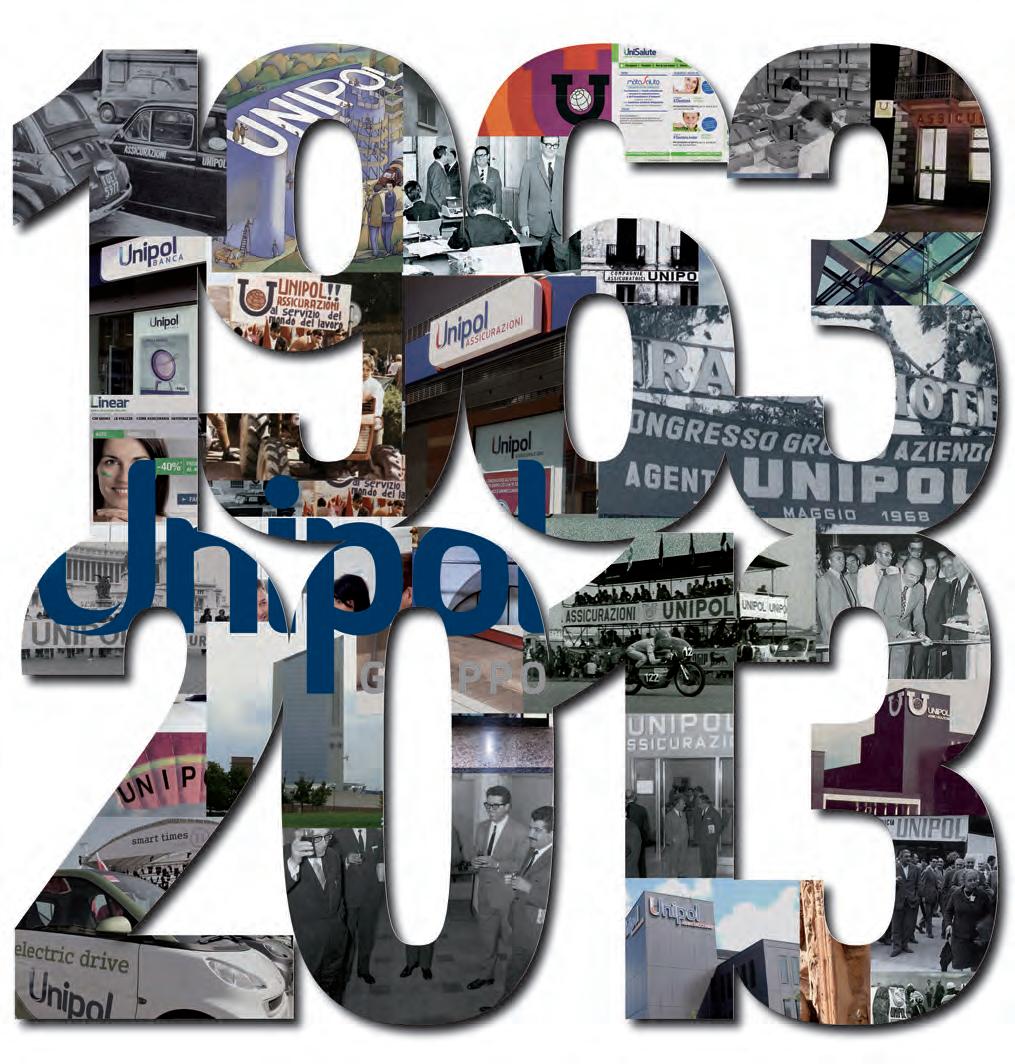
2 Work Style — #12.13
Work Style — #12.13 3
Colophon
#12 issue, Autumn/Winter 2013
International publisher
The Work Style Company
Riva Caccia 1d, POBox, 6901 Lugano, Switzerland
T 0041 22 548 00 06
W www.theworkstylemagazine.com E welcome@theworkstylemagazine.com
US Address: The Work Style Magazine
2578 Broadway, Suite 150 New York, NY, 10025
Italy Address : The Work Style Editorial Board
Via Cesare Balbo 4, 20136 Milan, Italy
T 0039 02 87 196741 0039 380 6936502
Printing: Italgrafica, Via Verbano 146, 28100 Novara, Italy. At Work Style we care about the environment, so we print our magazine on 100% recycled paper.
Periodical magazine registered at the Milan’s Court
Chairman: Mirko Nesurini
Editor in Chief: Rosario Imperiali d’Afflitto
Editor: Marta Scetta
Foreign Editors: Pina Draskovich, Thrasy Petropoulos
Section Editors: Roberto Roberto Benzi, Luca Brunoni, Palle Ellemann, Allan Hall, Jennifer C. Loftus, Francesca Morelli, Nigel Phillips, Francesca Tonegutti, Peter Conrad, Marta Adrados García
Section Illustrators: Doug Cowan, Paul Davis, Agata Janus, John Joven, Tomek Karelus, Hanna Melin, Sergio Membrillas, Goñi Montes, Eelco Van den Berg, Yihsin Wu, Les Herman, Patt Kelley
Cover illustrator: John W. Tomac
Authors’ illustrator: Alessandro Baronciani
Others illustrators: Donough O’Malley
Photographers: Tim Flach, Jeff Sheng, Yann Riou, Sergey Bogdanov, Hamish Hooper, Rick Deppe, Arne Svenson, Dave Yoder, Olga Guseva, Paula Melo, Gavin Gosbert, Michel Sedaghat, Robert Rafton, Joni Kabana, Tsvetelina Anastasova, Gyula Sopronyi
Work Style Talks
Stefano Guandalini, Massimo Temporelli workstyletalks.com
100 Work Cities
Giovanna Sussinna, Paolo Mazzo 100workcities.com
Advertising / Subscriptions
Roberta Donati
E roberta@theworkstylemagazine.com T 0041 22 548 00 06
09 Administration
• Have To or Want To? by Laura Sadis Director of the Finance and Economy Department, Ticino Canton Bellinzona (Switzerland)
• Good for All by Raphael Saborit Head of Media Relations and Public Affairs Brussels (Belgium)
11 Research, Training, Academia, Education
• Odd Combination or Necessity? by Barbara Teicher
Consultant and Business Owner of ETC Kansas City (USA)
• Happiness is a Choice by D. Luke Iorio President & CEO, iPEC Coach Training School Shrewsbury (UK)
• The Element by Willie Sánchez
Associated Journalism Professor, Universitat Internacional de Catalunya Barcelona (Spain)
1THINKING OUT OF THE BOX
Rules and passion…some jobs require passion, and passions are often controlled by rules. Passions are not instinctive stimuli, but more likely all-absorbing projects. We see rules in a positive sense, they’re not ties, but a guide at the base of the job.
13 Production
• Social Relations by Tom Ridgman Director External Education Industrial Systems, Manufacture and Management (ISMM), Manufacturing Industry Education Research, University of Cambridge Cambridge (UK)
• Creativity by Jason Furness CEO of Manufacturship Green Hills (Australia)
• Taste by Gastone Farolfi Export Manager at Chocolat Stella Bernrain Giubiasco (Switzerland)
16 Psychology
15 Service Sector
• Networking by Peter Williams
Director, Centre for Tourism Policy and Research, Simon Fraser University Burnaby (Canada)
• TLC by Heamoon Oh Professor and Head Department of Hospitality and Tourism Management Isenberg School of Management, University of Massachusetts-Amherst Amherst (USA)
Cognitive Organizations deal with rules and passion very differently and they’re very different workers
• Rules and Passion by Marco Mossi, Psychologist and Cognitive Psychotherapist Blevio (Italy)
• To Each Their Own by Valter Mascetti, Pyschologist and Psychotherapist Como (Italy)
4 Work Style — #12.13
BEST PRACTICIES
18 Meritocracy
• Welcome Fido!
by Anne Buchanan, President at Buchanan PR, Philadelphia (USA)
• Dogs are a Company’s Best Friends by Christine Deakers, Account Coordinator in B2B Tech and free lance writer, San Francisco (USA)
• 4 Tips to Introduce Pets to the Office by Charlie Piscitello, Chief People Officer at Petco, San Diego (USA)
21 Recognition
• Gaining the Advantage Over Workplace Stress by Jennifer C. Loftus, Work Style, New York (USA)
24 Health
• Breathing Diseases by Francesca Morelli, Work Style, Milan (Italy)
25 Training & Coaching
• It Was an Accident! by Allan Hall, Work Style, Berlin (Germany)
• Bringing Home the (Big) Bacon by Work Style
28 Compliance
• Money Laundering, a World Plague by Silva Annovazzi, Senior Associate at Grimaldi Law Firm, Milan (Italy)
31 Legal
• The US Hunting Tax Evaders by Meredith Mazzola, Associate at Gibney, Anthony & Flaherty, LLP, New York (USA)
32 Performance
• Athletes at Work by Palle Ellemann, Work Style, Bagsvaerd (Denmark)
34 Attachment and Pride
• The Carrot or the Stick? by Jonathan D. Messinger, CEO & Managing Partner at Essence Enterprise, Houston (USA)
36 Communication
• Mr. Saito, This isn't Your Typical Corporate Espionage by Luca Brunoni, Work Style, Neuchâtel (Switzerland)
• Big Brother is Watching You (probably) by Nigel Phillips, Work Style, London (England)
38 Change Management
• Stefano Bartoli, the Timenaut of the Lagoon by Roberto Benzi, Work Style, Milan (Italy)
43 Culture Integration
• Love Making by Alex Di Martino, Work Style, London (England)
• From Kosher to Veganism by Work Style, Lugano (Switzerland)
46 Unusual Job
• The Chocolate Factory by Martha Tintin, Work Style, Lugano (Switzerland)
48 Joining the Company
• Mercenaries by MT, Work Style, Milan (Italy)
Work Style — #12.13 5
2
52 People to Watch
• Agnese Gullotta Psychologist and food blogger Milan (Italy)
• Anna Guschina Business-trainer (freelance) Moscow (Russia)
• Antonnione Franco Leone Ribeiro Researcher and teacher at Universidade do Estado de Minas Gerais Minas Gerais (Brazil)
• Mshinwa Edith Banzi Managing director at Illumination East Africa Arusha (Tanzania)
• Olivier Haski Restaurateur Dubai (United Arab Emirates)
• Rebecca Chan Wedding planner and events manager Toronto (Canada)
51 Design for Work
• The INDEX & Office Exhibition Product Design Awards honors manufacturers and designers for excellence in product design for the residential and commercial office industries.
.. for Work: 64 Movie
• The Internship and A Touch of Sin 66 Books
• 40 books reviews
• 6 original interviews with the authors 73 Our Choice
• Free time ideas 74 To Three Friends
• Page dedicated to F38F 76 Fashion
• Our choice of… Necktie 81 HR Events
• HR events worldwide 121 Food
• We reinvent the “lunch-box” in a more modern and healthy way. Chef Moreno Cedroni has written 8 recipes for Work Style readers.
Others contributors:
Chrysta Payton, Communication Manager, International Interior Design Association, Chicago (United States). Alex Barnett, Comedian, Writer and Social Commentator, New York (United States). James Cussen, Director at ICE Art, Cape Town (South Africa). Leticia de la Herrán, Managing Director, Antal International, Madrid (Spain).
Nick Kochan, Writer, Consultant and Speaker, London (United Kingdom). Maurizio Marinella, Owner, Marinella, Naples (Italy). Paolo Aicardi, Commercial Director, Fondiaria-Sai and Sports Commentator, Telelombardia, Turin (Italy). Emmanuel Maindron, independent journalist and freelance
consultant, Saint Martin des Noyers (France). Sandro Lombardi, Director AITI for twenty-four years (19882009), Mendrisio (Switzerland). Jerzy Potocki, President, AIMS, International Poland, Warsaw (Poland). Amedeo Quaranta, Owner, Quaranta Locatelli, Naples (Italy). Stefano & Paola Bigi, Owners, Bigi Cravatte, Milano (Italy). Silvana Bressan, Sales Manager, Cravattificio Diana, Padua (Italy).
Jamie Ferguson, Online editor, Drakes, London (United Kingdom). David Pireh, PR and CRM, Edwin Pireh, New South Wales. (Australia). Giorgio Ricciardi, Owner, Giorgio Napoli, Naples (Italy) Italy. Mark Roscoe, Owner, MarkRoscoe Design, Indiana.
(USA). Maria D’Ambrosio, Owner, Nodi d’autore, Turin (Italy). Gianni Cerutti & Marta Passaggio, Owners, Passaggio Cravatte, Naples (Italy). Phil Buckley, Managing Director, Change with Confidence Incorporated, Toronto (Canada). John Mattone, President JohnMattonePartners, Inc, Orlando (USA). Kelly McDonald, Owner, McDonald Marketing, Dallas (USA). John R. Stoker, Author, Speaker and President, DialogueWorks LC, Provo (USA). Dorie Clark, Marketing, Branding and Management Consultant, Boston (USA). Erik Wahl, Graffiti Artist, Author and Global Philanthropist, San Diego (USA). Moreno Cedroni, Chef and Restorateur, Madonnina del
Pescatore, Senigallia (Italy). Manuel Barroso, Architect, Jerez de la Frontera City Council, Jerez de la Frontera (Spain). Cristóbal Cortes, Breeder at Ganadería Salvador Cortés, Fuengirola (Spain). Millán Herce, Veterinarian and Breeder, Yeguada Millán Herce, Fuentes de Andalucia (Spain). Álvaro Domecq & Antonio Domecq, Owners, Yeguada Torrestrella, Cádiz (Spain). Javier Conde, President, ANCCE, Seville (Spain). Rafael Soto, Rider, Royal Andalusian School of Equestrian Art, Jerez de la Frontera (Spain). José Juan Morales, Vice President, ANCCE, Seville (Spain). Ignacio Candau, Breeder, Yeguada Candau, El Coronil (Spain). Juan Carlos
6 Work Style — #12.13
3
PRIVATE EYE
WHERE TO WORK 4
138 Country Guide Bulgaria
• Looking to the Next Generation by Thrasy Petropoulos, Work Style Athens (Greece)
148 3 Work City Guides
• Seville (Spain)
• Beirut (Lebanon)
• Caracas (Venezuela) by Giovanna Sussinna, Work Style Catania (Italy)
150 Focus on Japan
• Heavy, Heavier: Japan by Peter Conrad, Work Style Tokyo (Japan)
152 Focus on Africa
• Youth Unemployment and Population Aging in Ethiopia by Olumide Taiwo Director of the Research Centre for the Study of the Economies of Africa Abuja (Nigeria)
156 Interior Design
• Digitalized Signage by Alessandro Albrizio Product Manager, Underline Milan (Italy)
158 Discovering the City
• Detroit: The Silent City
• Iconic Building
• Shinola
• Companies Against Bankruptcy by Cristina Milani, Work Style Lugano (Switzerland) and Paolo Mazzo, Work Style Milan (Italy)
190 Workplace Kindness
• A New Planet Where to Work
Is it a magic place, where everyone is polite and rules are followed? Is it a place out of this World?
Editorial
Are rules and passions really antonyms? Or is it possible that passion is nestled comfortably in the allegedly rigid world of law where it is, in fact, indispensable for the very creation of those rules and regulations? And if the so-called oxymoron “passion and rules” is conceivable in the legal domain, why not at work too?
Strange as it may seem, the question is hardly frivolous. History offers many examples of the common bond between passion and law. The Mahatma and Martin Luther King taught us that passion can guide radical reforms of a whole nation’s ruling system an extraordinary modus operandi when compared to the ordinary capacity of legislative assemblies around the globe. The same lesson can be drawn from the exemplary examples of the Italian judges Giovanni Falcone and Paolo Borsellino, who consciously gave their lives in the war against international organized crime. We could mention many more whose courage was rooted in such passion.
So passion may indeed be the beginning of regulation. It may be read in the footprints of every visionary ruler. How could we otherwise understand the first articles of the UN’s Universal Declaration of Human Rights, or the famous motto of the French Revolution, "Liberté, Fraternité, Egalité," whose messages hang in the air today?
The more ambitious the innovation, the more essential a passionate approach. Consider Beethoven’s “Ode to Joy,” selected as the anthem of the European Union. Here is clear evidence that a community of member States originally formed for economic purposes has chosen to broaden its misson: it will, embracing the standards of other historic transformations, strive to become a political union based on common fundamental rights. No simple matter. But with both passion and law, it can be done.
Román, Director at Royal Andalusian School of Equestrian Art, Jerez de la Frontera (Spain). Juan Heredia Díaz del Riguero, Technical Director, Royal Fraternity of Cavalry, Ronda (Spain). Belén Bautista Sánchez, Professor, Royal Andalusian School of Equestrian Art, Jerez de la Frontera (Spain) Desirée Lang, Breeder, Yeguada Querencias, Ronda (Spain). Javier Ruíz, horse rider, Yeguada Torrestrella, Cádiz (Spain). Manuel Novales de la Escalera, Director, Yeguada de la Escalera, Fuentes de Andalucia (Spain). Manuel Grandal Reyes, Blacksmith, Chiclana de la Frontera (Spain). Vicki Stanford, Director, Ken Blanchard, Escondido (USA). James Robinson,
CEO, Robinson Speakers, New York (USA). Tom Kenyon-Slaney, CEO, London Speakers Bureau, London (UK). Jan Jones, President, Jan Jones Worldwide Speakers Bureau, Solana Beach (USA). Gary Prell, Vice President Culinary Development, Centerplate, San Francisco (USA). Anu Kokko, Marketing and Offering Creation Director, Fazer Food, Helsinki (Finland). Matias Perdomo, Chef, Al Pont de Ferr, Milan (Italy). Pedro Subijana, Chef and Owner, Akelarre, San Sebastian (Spain). Chan Yan Tak, Head Chef, Lung King Heen, Hong Kong (Hong Kong). Christine Taylor, Director, Choccywoccydoodah, Brighton (England). Natascha Schwarzer,
Director, Barry Callebaut Academy, Zurich (Switzerland). Ernst Knam, Maitre Chocolatier and Owner, L’Antica, Milan (Italy). Mirco Della Vecchia, Maitre Chocolatier and Founder, Italian Master Chocolatiers Academy, Sospirolo (Italy). Christina Tantsis, Creative Director, Sisko Chocolate, Hawthorn (Australia).
Simon Chesterman, Dean, National University of Singapore Faculty of Law, Singapore (Singapore). Terri Kemp, Vice President HR, AAM, Detroit (USA). Christopher Son, Director Investor Relations and Communication, AAM, Detroit (USA). Michael Kulka, CEO, PM Environmental, Berkley (USA). Greg Martin, Executive Director
Communications and New Strategy, GM, Detroit (USA). Mark Rieth, Owner, Atwater Brewery, Detroit (USA). Daniel Caudill, Creative Director, Shinola, Detroit (USA). Bill Hartman, Managing Director, Gensler, Detroit (USA). David Simon, President, Toggled, Troy (USA).
Jack Kennedy, Vice President and General Manager, Chelsea Milling Company/Jiffy Mix, Chelsea (USA). Vince Thomas, Chairman and Founder, Bill Highway, Troy (USA). Brenda Gallick, HR Director, Chairman and Founder, Bill Highway, Troy (USA).
Paul Urbanek, Design Leader, SmithGroupJJR, Detroit (USA). Dan Kinkead, Executive Director, Detroit Future City, Detroit (USA).
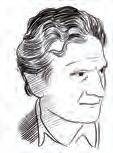
Work Style — #12.13 7

Rules and Passion in ... Administration
LAURA SADIS
Laura Sadis started her political career in 1988 in the Lugano City Council. In 2007 she was elected in the State Council, which she chaired in 2011 and 2012. She's currently Head of the Finance and Economy department.

Have To or Want To?
Respect for every citizen and society is a principle I observe in every aspect of my job. Failing to acknowledge or be honest and open with those who trusted and got me here would not involve a fine, but it would mean that I’d failed.
Another rule I try to live by is sharing. Having a good idea or finding the perfect solution is not enough to make it work, especially in a job such as mine that includes a strong political element. Sharing an idea among colleagues makes it stronger, and I have even come to appreciate the fact that, finally, it may no longer be just my idea, but everyone’s. That’s when you know it’s going to work.
The strong sense of responsibility I feel toward society is what pushes me. I am aware that this may sound ambitious, but providing future generations a better society in terms of fair conditions and better life opportunities than those I had is my ultimate goal.
They have to: good and bad, men and women, day and night.. It’s all about balance.
On the one hand, if you are too passionate about your job, you may get carried away; passion often makes people irrational. But then rules keep you grounded. On the other hand, if you dispassionately follow rules, you’ll miss the sparkle. These two elements chase and play with each other, constantly finding a new balance. To be a good painter, a good teacher, a good nurse, and also a good Chancellor, you need both. And I love to be blessed by both.•
Good for All
In my job, there are two primary rules I have to follow. The first is a rule of loyalty to the political decisions of the Federal Council, the Ministry of Foreign Affairs, and the head of the Swiss Mission to the EU. The second key rule is that of privacy. We deal with a lot of confidential information and must carefully protect it in every form of communication.
The passion for what I do has two sources, and the first is that in working for the state, I am at its service and at the service of the entire population. I like the feeling of doing something useful for everybody, something that serves the interest of a community rather than of individuals. Then there’s the aspect of working in communication. Without passion, that’s difficult. There’s also the patriotic factor, the love for the country I represent for the Swiss brand. We’re well aware that we are not selling or defending a product, but ideas and values, as well as the scientific and technological strengths of a country and its people.
I believe that in my job there is no conflict between rules and passion. This is because the rules I follow are made for the good of the community to defend the image of a country and its citizens. In addition, there is something called common sense. If we act purely from passion, things probably won’t go well. But if we act only on reason, the result will be the same. There must be a compromise between the two.•
RAPHAEL SABORIT
Raphael Saborit started his career in Public Administraton as a personal advisor to the Swiss Home Office Minister and then of the Swiss Economy Minister. He's currently Head of Media Relations and Public Affairs at Mission Switzerland to the EU.

Work Style — #12.13 9
[W eda.admin.ch ti.ch]

Rules and Passion in ... Research, Training, Academia, Education...

Odd Combination or Necessity?
Rules and passion. Hmm. It sounds like an oxymoron. Rules bring to mind structure, constraint, and boredom. Passion, just the opposite: wild abandon and unfettered emotion--fragrance commercials! I thought about how these two coexist. What came to mind is that rules give your passion the freedom to be more intense, more passionate! In my profession, keynote speaking and corporate training, there are rules to follow: engage your audience and provide valuable content. Audience members come in as if they’re on a runaway train. They don’t really know where they’re going or how to get there. Following the rules, I take them
safely on the journey with me, building a picture of where they’re going. What is the source in me that conjures passion? It’s the rush of glimpsing the audience, knowing they’ve come to see me, and I’m going to help change their business and personal relationships. When they’re “with me,” I feel exhilarated and alive. It’s like being the conductor on a speeding train, fully in control yet running full throttle toward a great destination. How can passion and rules live together? You need rules to get you on the right track. Then “The Little Engine That Could” gets you passage on the “Freedom Train. ”All Aboard!•
Happiness is a Choice
Nothing great has ever been achieved without passion. Be a leader whose passion is not only visible but is true. If you aren’t passionate about the task at hand, how could your team be? The fire you light in yourself kindles the passion in your team. Nothing changes without awareness and subsequent action. We have a responsibility to continually learn more about ourselves and others, and then create new ideas and solutions to face any challenges we encounter. You can’t assume that others always know what is occurring or that they are aware of the full picture. So take the
initiative to ensure that important issues are covered and addressed. Be supportive and helpful not confrontational. Let your initiative shine a light in the direction of progress.People want greatness, so help them see it in themselves and then unleash it! So when you change your perception, you will also move mountains to climb toward your highest value or passion. In my job as a coach, illustrated by this example, the constant rule is to be authentic— to be true to who you are and then establish your guidelines or boundaries accordingly. •
Luke Iorio is President & CEO of the Institute for Professional Excellence in Coaching (iPEC), the most comprehensive and experiential coach training program in the world and originator of the Core Energy Coaching™ process.
WILLIE SÁNCHEZ

Willie Sánchez has had a flourishing career in journalism and is now Associate Journalism Professor at the Universitat Internacional de Catalunya (UIC).

The Element
I have no rules; I have principles. First, I determine why a pupil signed up for my class, and then I help him to do his best work. How? Hopefully, before my class, students will have discovered what Sir Ken Robinson calls "the element," or their passion; and they will have worked on it. From there, I give them the freedom to polish and share it with the members of the class. My classes are usually workshops providing hands-on experience, and we work in teams. Building teamwork is another asset. I make sure that pupils don't harbor hard feelings against one another and that they leave grudges outside the classroom. I tend to trust my students and rely on their work instead of imposing my theories. They work freely, making the best use of their time. Since yawning is not allowed, I make the classes interesting as well as instructional. But above all, I value respect. There is only one source of passion and it’s inside you. What moves you, what helps you make a difference and stay creative that’s key. You gotta find it and cuddle it. There is no alternative. We all have a passion and must keep it going because passion should be an everyday experience. I don´t believe in rules, but I do believe in empathy and respect. We need fewer rules and more space for passion. If we set too many rules, passion fades. That’s because it thrives in an atmosphere of freedom. Keep in mind that the absence of rules doesn´t necessarily lead to chaos. Hopefully, it produces a balance. Passions overlap and work together. They don´t need an army to enforce rules. That could lead to censorship!•
Work Style — #12.13 11
[W barbarateicheretc.com ipeccoaching.com uic.es]
D. LUKE IORIO
BARBARA TEICHER
Barbara Teicher is a consultant and business owner of ETC. Prior to this she worked in leadership development for Sprint. She is a speaker and an author.

Taste
The first thing I note each morning is that we produce perishable products, and at the same time our customers expect the highest quality, considering our prices. Rules in my job are: provide customers with adequate service and maintain our reputation. After all, we’re Swiss and our chocolate is renowned. To provide flawless service to our customers, I must give satisfactory answers both in terms of timing (replies to emails are expected within the hour) and of details. I must be precise about what I can provide for their project.
I landed a job at Swiss Chocolate because I’m a gourmet, and I’ve always loved chocolate. It is a fantastic product if we think about the fact that it’s made with just three ingredients and yet is worldfamous. I work in a world that produces something extremely healthy, whose health advantages are yet to be fully discovered. Chocolate is a live product, and its industry is in constant movement.
Icarus finally had to face the fact that if we don’t respect rules, we won’t go anywhere. A great thing for each of us would be to become passionate about rules. They may be stop signs along our road, but if rules are clever, harmonious, and designed to foster ideas and not stop them, they can help us develop a passion.
Passion is what makes you find ideas and believe in the impossible. Rules can help prolong a passion and give you the opportunity to repeat it over time, efficiently. If man reached the moon, it was because someone believed it was possible, Then too that same someone followed the rules that would ensure his return.•
Creativity
As someone who has run large manufacturing businesses and seen best practice all around the world, I observed passionate people daily. Here are three primary sources of passion that I see in people in these industries.
1. Service. Help your client to have a better life. I know people who do highly repetitive work hundreds of times every day. They are passionate about making sure every part is perfect so as to guarantee that the customer will enjoy his new purchase.
2. Creation. Creating something new! Whenever a new model vehicle was being built down the assembly line at GM, or a new fridge was being trialed at Electrolux, everyone was interested. People cared, and they were excited to be part of creating something new.
3. Connection. Many people are passionate about working with others to achieve a greater goal. We enjoy the idea of working with like-minded people on a project. Rules and passion in manufacturing live together. Without passion, there would be no drive to innovate and improve. Without rules, we would lack a framework for analysis and decisionmaking. The two together allow creativity to be brought into reality.•
Social Relations
I work for an old University that believes in academic freedom and therefore has very few formal rules. The cultural rules are that you have to aim to do everything to a world-class standard; you have to raise your own money; and you have to use the privilege of your position to address the hard problems of the world.
I am passionate about educating young engineers and trying to understand how engineering education can be made more relevant to industrial practice.
There is little conflict between the overt rules and the activities I’m passionate about. However, the increase in administration and bureaucracy is limiting the time I can spend on things that add value.•
JASON FURNESS Jason Furness's career spans over 20 years in manufacturing, where he has overseen the turnaround, transition, and transformation of many projects as a general manager. He is now CEO of Manufacturship.
TOM RIDGMAN


Tom Ridgman worked in the automotive industry for 20 years, mainly for Leyland Trucks. He then ran a research program at Warwick University before going to Cambridge in 1995. He now is Director External Education of the ISMM.

Work Style — #12.13 13
Rules and Passion in ... Production
[W cam.ac.uk manufacturship.com swisschocolate.ch]
GASTONE FAROLFI Gastone Farolfi is Export Manager at Chocolate Bernrain AG.

Rules and Passion in ... Service Sector
PETER WILLIAMS

Dr. Peter Williams (MCIP) is a professional planner and geographer whose work focuses on policy, planning, and management issues related to tourism development. He's Professor and Director of the Centre for Tourism Policy and Research at Simon Fraser University.
Networking
I have learned much about living within the rules of academia, while feeding my passions associated with tourism education and research. Essentially, all of my academic activities are framed by explicit policies and procedures concerning teaching (e.g., courses and hours taught), research (e.g., ethics and transparency in data collection and interpretation), and service (e.g., responsiveness to departmental and community needs). For the most part these are mechanical, somewhat stifling, and uncreative realities that are necessary for the efficient operation of the university. My ability to operate effectively and passionately within these rules is built on the implicit and more entrepreneurial relationships that I have nurtured with key colleagues within the university. By nurturing a positive internal network with academic colleagues built on trust, mutual respect, and credibility demonstrated through past performance, I have been given an implicit “social license to operate” in a more entrepreneurial fashion than would otherwise be the case. This cultivated freedom has provided me with the leeway needed to pursue my personal academic passions. More specifically, these include: implementing novel and more meaningful approaches to education delivery; developing alliances with leading tourism industry professionals that foster unique learning and career opportunities for students; and conducting research that produces outcomes relevant to policymakers and industry organizations influencing the development of more sustainable forms of tourism. Interestingly, my approach to “navigating with the rules” has had a reinforcing “rebound effect” on some university administrators. For those encouraging creative responses to emerging education challenges, it has provided them with additional best practice evidence demonstrating how entrepreneurial approaches to academic practice can lead to significant benefit for the institution and its students.•
TLC
We are in hospitality education. The hospitality industry is at the center of the service sector as its largest employer. While there are many fundamental rules specific to companies, one broadly shared norm in the hospitality industry is to take good care of your customers—treat others as you would want to be treated. In my academic discipline, there are no clear rules everyone must follow. But there are some basic notions shared across the board. (1) We are teachers committed to the learning and success of the next generation. (2) We are scholars continually engaged in research that will bring innovation and advance the quality of human life. (3) We are scholars reaching out to and helping the community, industry, and society in general to acquire best practices. The biggest source of my passion is the future of our students. If I can contribute to their success, however that is defined, I’m excited and stimulated. Passion is contagious. I become more passionate when our team of faculty and students responds to my passion. Everyone has passion. You have to bring it out as a leader. In my job, when you are passionate about what you do and express your passion in actual deeds and results, you do not need to worry about rules and expectations. For passionate people, rules are not goals to be met and satisfied; rather, they are basic directions and guidelines. Passion builds much more meaningful results on top of rules.•
Haemoon Oh is Professor and Head of the Department of Hospitality and Tourism Management at the University of Massachusetts Amherst. Prior to this role he was Associate Professor and Director of Graduate Education at Iowa State University.

Work Style — #12.13 15
[W sfu.ca umass.edu]
HEAMOON OH
Rules and Passion
By MARCO
MOSSI The cognitive approach is just the tool if a manager wants to get to know his raw material: people. This is because it can zero in on the four main ingredients of a personality and the infinite number of ways in which people express themselves. These ingredients provide flexible frameworks that suggest how an individual will react to certain stimuli and what will motivate his or her actions.
1

The first framework considers the areas of perseverance and commitment. Some people hold honesty and procedure in high regard. Their passions are of an intellectual nature, and they are truly engaged when they feel the project is right and corresponds to a number of objective criteria.
• STENGTHS: They are able to control their passion and use their enthusiasm to attain their objectives.
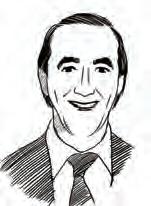 by Goñi Montes, Decatur, USA
by Goñi Montes, Decatur, USA
16 Work Style — #12.13
Illustration
Psychology Cognitive Organizations
By VALTER MASCETTI
To Each Their Own
A brief and crystal clear summary of the 4 Cognitive Organizations by a psychotherapist who loves metaphors.
I DO NOT CARE TO BELONG TO A CLUB THAT ACCEPTS PEOPLE LIKE ME AS MEMBERS.
Groucho Marx
The Depressive Organization can be defined as an individual's tendency to experience a pervasive sense of loneliness and isolation from others and generally to live out life's events with distrust, delusion and failure.
IT IS NOT SO MUCH OUR FRIENDS' HELP THAT HELPS US, AS THE CONFIDENCE OF THEIR HELP.
Epicurus
A Phobic Organization is characterized by a conflict between the need to feel free and independent and the need to have someone to lean on in order to feel safe. The need for freedom triggers a fear of loneliness and
lack of protection, while the closeness of another is experienced as a threat to the very freedom the individual craves.
MIRROR, MIRROR ON THE WALL, WHO IS THE FAIREST ONE OF ALL? Snowhite’s Queen and Wicked Witch People with Eating Disorder Organization have an oscillating and indefinite sense of self that becomes stable when they are confident of fulfilling the expectations of others. These people experience a constant need for unconditional approval. From this derives their tendency to focus on the opinion and behavior of others as a mirror where they recognize and feed their personal value. At the same time, precisely because they attribute a great deal of importance to
the judgment of others, people with an eating disorder organization constantly live in fear of disappointing others.
OF ALL THINGS THAT ARE CERTAIN, THE MOST CERTAIN IS DOUBT.
Bertolt Brecht
People with an Obsessive Organization are characterized by an ambivalent and dichotomous sense of self, where both a positive and a negative self-image are constantly at play Theirs is an all-or-nothing, blackand-white worldview. These individuals cannot appreciate the nuances and contradictions of life because such an awareness would provoke a crisis and inflame their inability to decide.•
• WEAKNESSES: They risk curtailing the brainstorming phase, thereby damping down the energy of others.

2 The second framework looks at the questions of responsibility and sense of duty. Some people’s passions are controlled and mainly of a personal nature; they may also be linked to the satisfaction of others’ needs. They are engaged when they feel a project is in their hands.
• STENGTHS: In relationships, they’re able to go with the flow. They can integrate passion and respect for rules, as well as tone down conflict.
• WEAKNESSES: They may be overly wary of risk, causing excessive seriousness.
3 The third framework concerns curiosity and self-confidence
Here, people’s passions are intense and directly linked to the novelty and freedom inherent in a specific task. Their engagement increases when they feel a project is innovative but also rooted in a solid frame of reference.
• STENGTHS: They choose highly innovative paths, always knowing the road home.
• WEAKNESSES: They may find daily routine painful and dislike the mundane aspects of organization and management.
4 The fourth configuration concerns imagination and flexibility The passion of these people can be contagious. They are always in touch with their audience, and they can shape and control the critical move toward consensus. They’re engaged when they feel a project will meet with the audience’s approval.
• STENGTHS: They are liable to get off track and make decisions on the basis of intuition.
• WEAKNESSES: They may agree to rules just to please others and not because they are truly convinced.
Finally, it is possible to harmonize rules and passion and to improve your teamwork atmosphere through a careful direction of the actors on stage. But be sure to have a thorough knowledge of the script (the framework) and engage your players with an approach that’s respectful of the sensitive areas in each of these frameworks.
Work Style — #12.13 17
[W centroterapiacognitiva.it studiopsicoterapiacomo.com]
Best Practices in HR Management Meritocracy
 By ANNE BUCHANAN
By ANNE BUCHANAN
Welcome Fido!
Researchers at Virginia Commonwealth University report that employees who bring their dogs to work experience lower levels of stress throughout the work day, have greater levels of job satisfaction and think better of their employer. Pets can provide a productivity boost as well. When the results of the study were released, appropriately named VCU professor Randolph Barker said, “Dogs in the workplace can make a positive difference. The differences in perceived stress between days the dog was present and absent were significant. The employees as a whole had higher job satisfaction than industry norms.” In case you’re wondering how they tested, they gathered saliva samples to measure levels of stress hormones.
THE BENEFITS
“Pet presence may serve as a low-cost, wellness intervention readily available to many organizations and may enhance organizational satisfaction and perceptions of support,” Barker’s study concluded. Another advantage is that taking your dog for a walk gets one up and away from their desk for a few minutes. Away from the phone and e-
mail, one can do some of their most creative thinking and come up with new ideas for a project they’re working on, or a different way of approaching a problem. Plus new research shows how dangerous extended sitting may be for our long-term health.
THERE NEED TO BE RULES
Needless to say, there need to be ground rules, and every office should have a pet policy. An employee with a dog allergy is a deal-breaker, or even someone who is afraid of dogs. Always alert clients and potential clients coming to the office that you are a dog-friendly office, and offer to make other arrangements if they prefer. “You have to have the right kind of dog,” said Greta Springett. “If a dog was aggressive or barked a lot it wouldn’t work. It also helps that we have offices where we can shut the door and cordon them off if need be.” Several other people at the Delphic office also bring in their dogs on occasion – including the boss – but they have yet to have more than one at a time.
SOME FINAL NOTES
We do occasionally have to explain some background barking when we are
on client calls, but those on the other end are usually delighted to hear we are a dog-friendly office. In fact, we find our dogs are often the first topic of discussion when we arrive at client meetings. Everyone wants to know how Lacey and Romeo are doing. And dogs have become part of our identity as an agency; we are involved in rescue efforts, annually contribute to shelters, and even helped broker an adoption by posting a stray we found outside our office on our Facebook page. Being a dog-friendly office has certainly set us apart in the marketplace. But it goes far beyond that – dogs have made our workplace more humane, more creative and more energetic. What leader wouldn’t want to cultivate that type of culture for her team?•
Tim Flach’s most recent work is the series More Than Human. This exploration of how humanity sees and shapes other species extended a body of work that has become a unique and important visual inquiry into anthropocentrism. His images have been acquired by major public and private collections. He has won the International Photography Award's Professional Photographer of the Year in Fine Art, and has been nominated for the Prix Pictet.
01 Chico’s Hair 61 x 48.5 cm Edition of 10, 122 x 95 cm Edition of 5, C-Prints.

02 Flying Mop 61 x 61 cm Edition of 10, C-Print.
03 Kinda Ready 61 x 51 cm Edition of 10, 140 x 122 cm Edition of 5, C-Print.
18 Work Style — #12.13
[W amazon.com americanpetproducts.org authentictv.com benjerry.com buchananpr.com cdc.gov cognition.com delphicdigital.com]
A growing number of companies are welcoming canine companions into their corporate culture. And with good reason. Research continues to point out the benefits for those whose work life includes the presence of a pup.
All photos are courtesy of Dubinsky Fine Arts
01
Below are four tips to help introduce pets to the office, and coworkers to pets.
1 START SLOW FOR FIRST-TIMERS
To ensure good behavior, start pets out with short time increments in the office. Reward pets for good behavior, such as laying at your feet quietly and resisting the urge to jump excitedly on coworkers. For anxious or overly excited dogs, pet parents can soothe Fido with the Thudershirt Dog Anxiety Solution - a breathable, lightweight vest that wraps around pets and provides gentle comfort.
2 USE SIMPLE COMMANDS TO ENSURE A PEACEFUL WORKDAY
"Place" and "stay" cues will help pets understand what their pet parents expect from them while at the office and provide a recognizable area for the dog to go when a break is needed. Add the command "place” so he associates this area with the word. Once the pet understands “place,” add the command "stay.” Soon, pets will understand that this is the place to sit and stay.
3 EXPEL EXCESS ENERGY BEFORE HEADING TO THE OFFICE
A half hour before heading into the office, take him or her for a walk to burn off any excess energy. During work hours, bring a toy like a KONG Dog Toy that can be filled with treats and provide hours of entertainment.
4 BREAKS ARE BENEFICIAL TO BOTH PARTIES
Breaks can help lower stress and are linked to having a smaller waistline, lower body mass index (BMI), and lower triglyceride levels. The same goes for pets. Taking short breaks outside with pets will allow them to get a change of scenery, as well as let them take those ever important potty breaks.
By CHARLIE PISCITELLO
KEYWORDS Meritocracy

➜ Increase productivty and reduces stress ➜ Helps bridging differences
➜ Improves communication between employees ➜ It is a win-win situation.
Dogs are a Company’s Best Friends
Perhaps one of the best additions to add to your company’s HR program, scientists say, is to bring your dog to work.
THE SCIENCE OF CUTENESS
Researchers at Hiroshima University conducted a study concluding that looking at pictures of baby animals improves productivity by nearly 17%. The study says, "For future applications, cute objects may be used as an emotion elicitor to induce careful behavioral tendencies in specific situations, such as driving and office work.” Participants’ focus in
the study increased, “induced by the cuteness-triggered positive emotion.”
WHEN PET POLICIES BITE BACK
Not every company has puppy love despite their pet policies.
Administrative Assistant Suzie Smith of a Toronto-based marketing group said, “Some management is not a big fan of having dogs around. At one point a couple of months ago, a dog came into a conference room where a meeting was going on with my boss and an important client. Another dog then followed into the room and they had a fight. It was not good, and my boss was really angry. Stricter guidelines followed soon after.” While policies may become stricter, some companies roll with the punches.

Auditor Christina Yum visited one of her clients, a start-up company, to find an unwelcomed surprise by her desk on her first day.
EASTWICK: A DOG CASE STUDY


 By CHRISTINE DEAKERS
By CHRISTINE DEAKERS
One of the vital perks to Eastwick, essential to the everyday atmosphere of the personable yet professional office, is how many employees bring their dogs to work. To Eastwick, dogs are a morale boost, and handy for employees. The dogs get taken on regular walks outside, both at the San Francisco and Sunnyvale office, and get to move around. As long as they are well behaved and not a distraction, dogs in the workplace really are a win-win situation.
Work Style — #12.13 19
03
02








































Best Practices in HR Management Recognition
By JENNIFER C. LOFTUS
Gaining the Advantage Over Workplace Stress
Today’s world always has another email, call, or meeting to address. While this may generate a satisfied feeling, a steady diet of always being on call is detrimental. Our 24/7 world, combined with ongoing global economic uncertainty and continually doing more with less, creates stress.
Human Resources consulting firm Towers Watson notes that 38% of 2012 Global Workforce Study participants are often bothered by excessive job pressure. Only 54% indicate the amount of work they are expected to do is reasonable. Fifth-three percent state stress levels are manageable. Managers, take note. Stress leads to burnout, disengaged staff, and negative bottom line impacts. According to the study, organizations that actively mitigate employee stress have average operating margins almost three times higher than those who do not address workplace stress.
STRESS IS IN THE AIR
What can be done to reverse a negative spiral? Know your organization. What are your employees’ stressors? At Syracuse, New York's engineering firm O’Brien & Gere, stress comes from “selfinflicted pressure” regarding “quality, budgets, and timing” to “achieve client satisfaction.” At a Westchester County (New York) financial services organization, “aggressive goals and having to do more with less” are stressors. GMHC, a New York City non-profit, feels stress from a “lack of funding support for our work.”
NOT FOR MANAGERS ONLY
Stress is not the exclusive domain of management. As Janet Weinberg, Chief Operating Officer of GMHC explains, “Where you sit is where you stand.” In finance, everyone is stressed, particularly at year end. Pete Koval, O’Brien & Gere’s Principal for Corporate Human Resources (HR), finds that middle and top management have the most pressure “because they have the most responsibility for driving the business.” Culture impacts how stress flows, as highlighted

by our cases. Stress moves top down in financial services, and bottom up in non-profit. In engineering, stress can emanate from any level where top performers and aspiring staff reside.
PROFESSIONAL STRESS REMOVAL
Removing all stress from the workplace is highly unlikely and detrimental in the long run. Some stress is intellectually and emotionally energizing. Towers Watson’s study cites a variety of stress management techniques, including ensuring a match between employees’ skills and roles, developing and refreshing skills, and redeploying employees into better fitting roles. Flexibility, empowerment, wellness programs, and visible senior management support are other tools. Our case study organizations live these models. Koval notes
O’Brien & Gere’s “long-standing” multifaceted wellness program. Training in job related skills and recognizing and identifying job related stress is available. Work/life balance is also key. The Westchester County financial services firm uses work/life balance, an Employee Assistance Plan (EAP), flexible work scheduling, and wellness programs to combat stress. GMHC remains true to its culture of caring and communication with monthly all-staff breakfasts to share “both good and bad” news, Weinberg explains, and to celebrate employees’ life milestones. Drop-in conversations with HR and EAP services also aid GMHC’s stress reduction efforts. The pace of work is brisk for many, irrespective of size or industry. As leaders, we must be vigilant against the potential downsides of always striving higher to reach our goals. With study, planning, and a toolkit of genuinely supported work/life balance techniques, we can achieve greatness without sacrificing the team that gets us there.•
KEYWORDS Recognition
Stress leads to burnout
Stress comes from “selfinflicted pressure”
Stress removal is detrimental in the long run

Give flexibility and establish wellness programs

Work Style — #12.13 21
[W gmhc.org obg.com towerswatson.com]
Illustration by Agata Janus, Warsaw, Poland
➜
➜
➜
➜
mobility mania
The innovative line of accessories Twitch is the result of a careful study of Italian internationally renowned designers who have turned back in the game and the world of mobility.
The case is equipped with a slide-upfeature, and is the revolutionary model of the collection, characterized by an innovative easy-to-catch extraction system, an ultra resistant polycarbonate body, insert in eco-leather, and an embossed logo with metal datails, tall features that make Teitch inimitable.
The entire range is available for iPhonee5 and iPad Mini, divided by model and in four different colors, each with its own target audience.

Work Style — #12.13 To know more contact us on 0039 02 36766175 - info@underlineglobal.com
Minimal, functional, innovative, sensual... Twitch!
twitchmobility.com
waifinding solutions digital signage displays systems
contract - furniture mobility brand management

Work Style — #12.13 23
strategic partner underlineglobal.com
Practices in HR Management Health

KEYWORDS Health ➜ Prevent exposure ➜ Use protective devices ➜ Improve ventilation systems ➜ Establish wetdown procedures
Breathing Diseases
By FRANCESCA MORELLI

Occupational lung and respiratory diseases are among the leading causes of work-related health problems in the United States. Inhalation of toxic agents and improper ventilation conditions are the major risk factors.
Coughing, shortness of breath, wheezing, chest pain or tightness, and abnormal breathing patterns are the most common symptoms of lung and respiratory diseases and can occur after repeated and longterm exposures to irritants and/or sensitizers on the job. Contrary to a popular misconception, coal miners are not the only ones at risk for occupational lung disease or disease of the respiratory tract. Working in a car garage, for example, or in a textile or electronics factory can result in exposure to hazardous substances or agents that may lead to a lifetime of respiratory and lung problems if not properly diagnosed and treated.
RISK FACTORS
Certain occupations, because of the nature of their location, the kind of work, or the environment are more at risk for occupational lung and respiratory diseases than others. The major causal factors include the inhalation of irritant chemical vapors and gases, organic and inorganic dusts, sensitizing agents and toxic fumes which adversely affect both the upper and lower respiratory tracts. Workers who smoke are at greater risk for certain types of lung disease if they are exposed to irritants in the workplace. Poor ventilation, closed-in working areas, or lack of proper respiratory protection can increase the probability of illness. “Some agents,” says Dr. Christine Oliver, Pulmonary and Critical Care Medicine, Department of Medicine at the Massachusetts General Hospital, Boston, "can cause upper respiratory tract irritation resulting in irritation of the nose and/or throat with cold-like symptoms, such as a runny nose and scratchy throat. Viral infections and allergies produce similar manifestations, but you should become suspicious of a work-related illness if problems occur at work or are worse at work”. Asthma, aller-
gies, bronchitis, persistent cough producing mucus or sputum, as well as more serious conditions such such as pulmonary fibrosis, chronic obstructive pulmonary disease, emphysema and lung cancers are principal lung and breathing diseases.
DIAGNOSIS
Because respiratory symptoms caused by toxic exposure are nonspecific, recognizing their potential relationship to a toxic agent is essential to proper diagnosis and treatment. Factors affecting treatment may be determined on the basis of the age of the patient, overall health, extent of the disease, tolerance for specific medications or therapies, and expectations for the course of the disease. “Eliciting the occupational history is the most important step to determine the nature and the severity of the occupational respiratory disease,” adds Dr. Oliver. “Specific information about the type, level, duration of exposure is needed. This information must be complemented by additional diagnostic tests, such as chest radiography or tomography, pulmonary function tests (measurements of gas exchange in the lung and airways or bronchial hyperreactivity), and other laboratory and microscopic examinations of lung ttissue, pleural fluid, and lung lavage.”
PREVENTION
Occupational lung and respiratory diseases will progress in the face of continuing exposure and often even after exposure ceases. Thus, prevention of exposure is key to reducing morbidity and/or mortality. “It is mandatory,” says the specialist, “to abstain from habits, such as smoking, that are inherently toxic to the lungs and exacerbate respiratory effects of workplace and environmental exposure. But it is also necessary to take active steps to reduce workplace exposure to toxic agents.” The National Heart, Lung and Blood Institute recommends taking further preventive measures, including the use of proper protective devices, such as facial masks or respirators, when around airborne irritants and dusts, the substitution of somewhat toxic with nontoxic substances, factory engineering changes to improve ventilation in the workplace, and adoption of wet-down procedures to reduce dust levels. “If these measures are not effective or if the exposure is to a substance to which the person may be sensitized,” concludes Dr Oliver, “removal from the worksite is the only therapeutic option to avoid serious damage to the respiratory tract.” •
24 Work Style — #12.13
Best
[W bidmc.org nhlbi.nih.gov]
Illustration by Sergio Membrillas, Valencia, Spain
Best Practices in HR Management Training & Coaching
KEYWORDS Training & Coaching
➜ Be an inspiration
➜ Be credible and original ➜ Establishing focus of expertise ➜ Raise morale of employees


It Was an Accident!
By ALLAN HALL
Some of the world's keynote speakers become so by accident. Tony Blair, the former UK prime minister, by dint of a decade in power can command over 100,000 pounds per hour. The same goes for TV celebrities and self-help gurus. But for many, learning the art of becoming a keynote speaker is just that - hard study learned in a specialist environment.
Recently, Britain's former Shadow Secretary of State for Education Stephen Twigg called for all state school pupils to be given lessons in public speaking and interview techniques, believing such skills help later in life when looking for university places or jobs. As the demand for top speakers continues to soar, where do the speakers of tomorrow go to today to learn their craft? Sometimes it is in cyberspace, sometimes at a college, sometimes within the business of present employment. All pursue the aim of a transformation rom good to stellar communicator.
AN ESSENTIAL LIFE SKILL
Eilidh Milnes is a woman on a mission. An empowerment speaker, trainer and coach, her workshops are sold out months in advance. And, at the time of writing, she is the president elect of the Professional Speaking Association. Based in London, in recent years, she has delivered keynote speeches to thousands of people across four continents with two decades of training and coaching behind her. Clients include corporates such as PWC, BAE Systems, Compass, BT, Morgan Stanley and Barclays. Speaking, she stresses, is a skill that must be worked at. She says, “Speaking is an essential life skill; and like all life skills, it is earlier to learn when started young. Do you think to master their crafts Lewis Hamilton, Jenson Button and Andy Murray started at a young age? Of course they did! Consider Barack Obama. Everything about him, from his physical appearance to his mannerisms and cadence, looks and sounds Presidential. This is not surprising. Obama is a gifted orator who has been preparing for his Presidency from very early years. And speak-
ing successfully in public is all about preparation and planning--what I refer to as the 5 Ps--which promise a perfect performance.” Training sessions usually cost around 500 to 600 pounds, but can be as much as 3,500 pounds depending on what is needed. She explained that “particularly in the world of business, keynote speaking is becoming ever more important. A guest speaker can play a big role in raising the morale of employees. There are times when providing the needed inspiration to employees is beyond the control of managers and executives of a company, as they themselves are often experiencing challenges of their own. I can help raise the morale within companies or organizations.”
HIGH DEMAND MEANS OPPORTUNITY
Mike Leidig, 48, is the owner of the Central European News agency in Vienna, serving the whole of eastern and central Europe with a news and photo gathering operation for international
media. CEN also runs courses for keynote speakers for banks, such as Raiffeisen, insurance companies, charities and assorted government agencies in Austria and beyond. Mike, originally from the UK but with Austrian roots, said keynote speaking is now in such demand that he has crafted a special 2,000 pounds, 10-hour course to turn accomplished public speakers into great ones. He says, “Obviously, keynote speakers are people who have had experience in public speaking to the extent that they want to rise to the next level. It's like taking different colored belts in karate, if you will. The objective is to rise above the free circuit and start earning handsome speaking fees to inspire and fire up audiences with your monologues.” If your speech is insightful and impactful, people will pass your name along. “I would say keynote speakers would ideally be people who have at least two years experience in the field, who have given major presentations and are comfortable standing in front of a large au-
Work Style — #12.13 25
Illustration by Donough O'Malley, Bristol, England
dience. But I have trained people with as little as three months experience into keynote speakers. It is all a question of innate talent; if you have it, I can bring it out.” Mike, and others like him, stress that keynote speakers should know their limits, set them, and stay within them.

“There is little point in Tony Blair, for instance, going before the Women's Institute to deliver a speech about jammaking, a subject which he knows nothing about. If you are a professional keynote speaker, it is very important that you determine which market niche to target. There are thousands of speakers out there, and to get noticed you have to set yourself apart.” A jack of all trades and master of none is usually not someone who will succeed. So, be it banking, media, landmine clearance, child vaccines in Africa, or the working poor in India: if you are going to speak on a subject, you must deliver with absolute authority. Anything else will fail, and the audience will see through you as a child sees through a sloppy magician at a party. Mike says,“You also must have a certain flexibility in your character, nomatter how skilled you may be in your area. Audiences are becoming more international. For instance, I trained pair of keynote financial sector workers from Germany recently, who found themselves at a conference in London where some 25 percent of the audience was from the Indian subcontinent. One look around the room told them they would have to make cultural references that sounded plausible at least!” They told me they went along to an Indian restaurant around the corner from the conference venue, where the proprietor was only too pleased to offer some cultural insights into his country, as well as a couple of jokes in Hindi that went down a storm! That is what I mean by flexibility. Keynote speakers are expected to tell their audiences to think fast and think on their feet. It is no good doing this if they are unable to practice what they preach. “The teaching plan we operate works in three ways: voice, speech,
and stage mastery. The voice must be trained to project and sound confident but not arrogant. The speech must be punchy and 'sexy' without being rambling and long.


And stage mastery comes from poise, the way you stand at the lectern, the way you hold yourself. It is not rocket science. No one will be overly impressed by someone in a T-shirt and beer belly, slouched over a podium reading from a script. They will be impressed by someone in a well-cut suit, able to recite key facts at a rapid fire pace without constantly referring to notes. Keynote speakers, it must be remembered, are out there to fire people up, their souls, their ambition, their emotions. They cannot do this unless they look and sound the part.”
CLIMBING UP Rob Hyde, 38, British and a formerly Germany-based PR speaker, took Mike's Keynote Speaker course two years ago and is about to depart for a yearlong lecture tour for management workers in the oilfields of Saudi Arabia. Rob, who honed his teeth speaking to focus groups, cultural exchange missions and business schools said, “Going from being a platform speaker to being a keynote speaker is like kicking up a grade and was worth every penny. Mike's course taught me that, no matter how good you are or how much you think you know, you're never so good that you can't be better.And you certainly don't know everything. I had a tendency to ramble, my speeches strayed. Mike showed me how to keep them taut, to keep them interesting, to keep the audience riveted from the first opening remark until the closing punchline. One very valuable aspect of his course was learning about cultural taboos. In the UK, for example, it is perfectly OK to make mild jokes about the royal family
and the Queen. But I learned that I might find myself under arrest if I tried this in front of a Saudi audience! And in Japan, where I intend to go after my year in Saudi Arabia, one should never use self-effacing humor during a public speaking engagement. Actually, the Japanese don’t like humor in seminars at all. Conversely, Australians love humor. Mike has a guidebook for pitfalls to avoid for any audience, from virtually any country on earth. This is the kind of expertise that you need along with the right coaching to better yourself. It was the best 2,000 pounds I spent.”
For keynote speakers to break into the world of the big time, professionals advise that patience is a necessary quality along with oratory. Planning for big events typically begins at least six months ahead of the date.

Heather Lloyd-Martin, owner of SuccessWorks Search Marketing and programme adviser for PubCon, SEMpdx, and major Direct Marketing Association conferences, explains, “There’s a lot that goes on behind the scenes. When we’re considering a speaker, there might be additional planning, logistics, and several layers of approval needed before we can confirm the slot.We approach Alist speakers first and then contact others whom they think might be a fit. But unknowns, take heart. If I think you will do a good job and provide a fresh voice and perspective, I will bring you on.”
Traci Browne, president of the tradeshow marketing firm Red Cedar Publicity and Marketing, books speakers for organizations in the US. Says Browne, “In this day and age of Flip cameras, it is almost unacceptable
26 Work Style — #12.13
[W cen.at eilidhmilnes.com janjonesworldwide.com kenblanchard.com londonspeakerbureau.com professionalspeaking.biz]
to not have a video sample of your presentation, or several samples. We’re not looking for high production values; we just want to see if you’re a good speaker or not. A video will show us how dynamic you are.” Lloyd-Martin
says she tries to get a sense of a person’s personality and what that person will be like in front of an audience. She also emphasizes that title and position do not guarantee someone is going to be a good speaker. “We’ve had really
high-level executives read straight from their notes, which the audience does not enjoy. They might have a fantastic message, but if people tune out, it gets lost,” Lloyd-Martin says.•
THE POINT OF THE MARKET
Bringing Home the (Big) Bacon
Usually, when companies say they want a keynote speaker, what they mean is, “We need to hire someone who can talk to our audience for about forty-five minutes.” And they will probably cost a lot of money. You can’t tell anyone to become a speaker. They have to do something to earn it. Speeches normally last an hour, broken down into a forty-fiveminute speech and a fifteen-minute Q&A, followed by a book signing or photo session. Studies show that people fear public speaking more than death, which means that public speaking is not for all. There are a number of skills and characteristics required of good communicators, as Vicki Stanford, Director of the Speakers Bureau and Publicity at Ken Blanchard says. “The best communicators are good storytellers; they are authentic and they speak from the heart. They know the demographics of their audience and match speaking style and message to that audience, conveying a stage presence that lends credibility to their message.” According to James Robinson, CEO of Robinson Speakers, a good keynote speaker must possess great stage energy, be amusing, but also have a great voice, speak loudly, and “have a certain je ne sais quoi.” But in terms of what the business is looking for, they have to bring entertainment and real value. “A company is not gonna hire a speaker because they’re funny. They want them to explain how to increase a company’s revenue stream. Consider this example. A company
invites a speaker to a salesforce meeting that all reps must attend. What the organization wants is for all these employees to walk away with something of value. So if you bring in a salesforce speaker, say Richard Branson, he’s gonna be amusing, but he also must give useful tips that the team can put in practice the day after.”
According to Tom Kenyon-Slaney, CEO of London Speakers Bureau, “Good speakers also need to be able to establish rapport quickly with the audience."
A SERIES OF CATEGORIES
Robinson says, “Speakers are differentiated, mainly by subject matter, but as for characteristics, speakers are supposed to be storytellers.” They’re performers. It’s a real art to be a good speaker. Our best speakers include Richard Branson, Cindy Gallop, Ben Stein, Sir Ranulph Fiennes. Categories, according to Kenyon-Slaney, are generally motivation, economics, politics, management, innovation, technology, environment, education, and celebrity. According to Stanford, it seems that there are no characteristics for each category, but there are characteristics belonging to the successful communicator in general. “They must be passionate about their message and experts on the topic, as well as constantly looking for updated material to share. Repeated stories kill credibility. They need to have solid content, but ask any of them what their audience remembers and they will tell you it is the stories they share. Finally, they must know their content cold, and practice, practice, practice.
THE MONEY IS THE PERK
The money one can make is certainly the best perk. As Stanford says, “Most speakers charge between $5,000 and $10,000. But there are the business gurus, politicians, and sports figures who command as much as $250,000. That is for a speech.” Robinson elaborates: “An agency is not gonna be very interested if the fee is less than $10,000, and they start to get really interested when they hit $25,000, as agencies take twenty percent. ” Speakers do a maximum of three speeches a week, but that’s tops. Generally they do twenty a year. “And that’s a pretty good year,” says Robinson. “But there are also some who do one hundred a year.” These people basically live on airplanes. “Ben Stein is a real speaker. He travels with his wife. They fly all over the world, first class for two, hotels of his choice. I don’t think he ever goes home, and he’s making $50,000 a speech, which means about six million a year. Richard Branson is worth nearly $400,000 a speech. That’s for two hours. However, Richard Branson donates it all to his charity, Virgin Unite.” The $400,000 is divided: $250,000 for the speaker; the rest covers flights, hotels, and meals. Jan Jones, President of Jan Jones Speakers Bureau says that keynoters who don’t have a lot of experience can earn anywhere from $1,000 to $6,000. With a little more experience, they can earn up to $10,000 for a keynote presentation. And it goes up from there. She says, “Jan Jones Worldwide Speakers Bureau does not work with speakers who are earning
less than $10,000 for a keynote presentation, and this is because our international clientele wants big name speakers, who will draw audiences to their conferences.” It appears that speakers earning less than $10,000 don’t typically get booked for international events, because overseas audiences don’t know who they are. Fees for moderate-to-well-known speakers who travel to international events earn generally upwards of $30,000, going well over $100,000 for very well-known speakers, who typically have bestselling books and are acknowledged as world leaders in their particular subjects. “But there are those who earn even more,” Jones says. “Ex-politicians can earn over $250,000 and high-profile business leaders are paid more than that. Expenses are in addition to the fee.” International fees are normally higher than fees in the speaker’s home market, as they don’t have to set aside three to four days for an event, as they do with international travel.
GETTING ON BOARD AGENCIES
Generally, speakers will be asked for a history of recent paid speaking, references, promotional video and other marketing materials. Then the agency evaluates and decides whether the speaker is right for them. Says Jones, “We get inundated with speakers who want to break into the international market, but they are not always a fit for us because we cater to a niche market of predominantly business events.”
(by Work Style)
Work Style — #12.13 27
Best Practices in HR Management Compliance
 By
By
Money Laundering, a World Plague
The International Monetary Fund and World Bank estimate that three to five per cent of world GDP (USD 1.6 trillion) is laundered every year, a plague since 1973.
Money laundering, lavado de dinero, blanchiment, riciclaggio--the term was first used in 1973 during the Watergate scandal, and there is no antecedent legal definition to describe what the Financial Action Task Force (FATF) calls the process of disguising the illegal origin of crime proceeds to make them appear legal. The laundering process usually starts with an initial accumulation of illegal capital (“placement”) deriving from activities typical of organized crime: arms sales, smuggling, drug trafficking, tax fraud, insider trading, bribery, and computer fraud schemes. Eventually, the funds are laundered by disguising their sources, changing their form, or transferring them to a place where they are less likely to attract attention (“layering”). Finally, once in the financial system, the funds can be invested in legitimate and quasi-legitimate economic and productive activities (“integration”).
TWO CLOSE FRIENDS OF ML: OFFSHORE FINANCIAL CENTERS (OFCS) AND BANK SECRECY
The globalization of the world economy and the concomitant increasing complexity of the global financial system have resulted in a large number of jurisdictions functioning as offshore financial centers. Offshore centers allow businesses to move their income to a foreign jurisdiction with more favorable tax laws and stronger voluntary or statutory privacy provisions compared to where the investor resides. In practice this means: greater privacy and secrecy, lower taxation (thus the term tax haven), easier access to deposits, and less regulation. These advantages are attractive not only to legitimate customers but also to money launderers who choose offshore centers that offer adequate financial and business infrastructure and, at the same time, strict banking and financial confidentiality facilitated by a general lack of transparency. In addition, some jurisdictions still apply bank secrecy so that authorities cannot access personal and bank information unless certain conditions apply. Bank secrecy is still prevalent in certain countries such as Luxembourg, Singapore, Lebanon, as well as at offshore banks and other tax havens where extreme client anonymity and discretion are guaranteed. Switzerland, the country that historically has played a leading role in bank secrecy, has been under intense pressure to find a way to allow its banks to share information with foreign authorities so as to avoid potential legal action. (UBS settled tax evasion claims with U.S. authorities in 2009 at a cost of $780 million.) Luxembourg announced in
ANNOVAZZI
April that it would begin sharing information about depositors' accounts in 2015, just two days after fellow hold-out Austria signaled it would enter EU negotiations to do the same.
AN OPEN DOOR
It is clear that ML profits hugely from the exploitation of offshore jurisdictions and strong banking confidentiality laws adopted by some countries. That is why European regulators have been fiercely trying to erode this privilege by implementing anti-money laundering regulations for banks and financial intermediaries to protect the integrity and stability of the international financial system and make it more difficult for those engaged in crime to profit from their criminal activities. Three European directives were issued, and there are currently talks on issuing a fourth Anti-Money Laundering Directive. Will the legislators be able to promote transparency and accessibility of beneficial ownership information to chip away at criminals profits?
HOW TO BE ON THE SAFE SIDE OF THE ROAD
Current EU legislation, known as the Third Anti-Money Laundering Directive, has been in force since 2005 and applies to banks as well as to lawyers, notaries, accountants, real estate agents, casinos, and company service providers. These recipients are required to:
• undertake “customer due diligence”: identify and verify the identity of their customers and of the beneficial owners of their customers (for example, by ascertaining the identity of the natural person who ultimately owns or controls a company), and monitor the transactions of and the business relationship with customers;

28 Work Style — #12.13
Illustration by Doug Cowan, New York, USA
SILVIA
BACK TO HARD WORK
A Swiss SME is encouraging young people to go back to working in factories offering a scholarship to re-launch the role of manufactuing in Europe.
The Company
Regazzi is a Swiss enterprise founded in 1946. It specializes in the manufacturing and sale of products for the construction industry. In particular, their portfolio of products offers external sun-shielding goods.

The Entrepreneur
Efrem Regazzi, son of the company's founder, worked in the organization since 1946. In the past few years he retired and left the company to his son Fabio and a team of managers.
The Scenario
During the past 20 years, Swiss industry has reorganized its production through an intensive and widespread innovation activity. It has introduced a number of technical developments that contributed not only to increase the competitiveness of manufacturing companies
The Offer for Young People
The company is offering a chance to young people of spending an entire day in the organization, giving them the opportunity to meet experts in the sector of metal construction, of professional training and...obtain one of the 3 scholarships worth 1,000 Swiss Francs each!
The Scholarship
Every year, from 2013 to 2018, the enterprise awards 3 scholarships for the production and technical sectors of metal construction of doors and windows as well as facades.
Information
For more information on the professions and training profiles in the industry of metal construction
you can visit this interesting website www.go4metal.ch by the Swiss Metal Union.
Requirements
The project is open to young people who are living in the Ticino Canton and are attending the last year of Orientation Cycle (last year of secondary school).
Contacts
Regazzi TSF SA

Via alle Gerre 1 6596 Gordola Telephone 0041 91 735 68 00 Fax 0041 91 735 68 19 Web www.regazzi.ch
• report suspect money laundering or terrorist financing to the public authorities, usually the financial intelligence unit;
• take supporting measures, such as ensuring the proper training of personnel and establishing appropriate internal preventive policies and procedures. The logic behind the provisions contained in the Directive is to construct a well-defined preventive apparatus that derives its effectiveness (i) from fines inflicted on intermediaries and other entities performing activities in direct contact with those intending to launder money and assets, and (ii) by impacting the world of business. The concept of due diligence requires adopting a series of measures which are binding upon the entities involved, most importantly by checking that transactions are compatible with what the entities involved know about their customer, his commercial activities and risk profile, and, if necessary, by looking into the origin of the funds and updating all information on the customer.
WHO FAILED TO COMPLY?
Failure to comply with AML laws and regulations and breaching financial sanctions can have serious consequences, such as:
• criminal proceedings for individuals and legal entities benefiting from the crime with sanctions such as imprisonment, monetary fines and fund-freezing;
• fines for non-compliance;
• damage to reputation.
Some famous cases in the past are:
• HSBC Holdings and HSBC Bank USA N.A. agreed to forfeit $1.26 billion and enter into a deferred prosecution agreement with US authorities for failing to maintain an effective anti-money laundering (AML) program and to conduct appropriate due diligence on its foreign correspondent account holders. The HSBC Group illegally conducted transactions on behalf of customers in Cuba, Iran, Libya, Sudan and Burma, all countries that were subject to sanctions enforced by the Office of Foreign Assets
Control (OFAC) at the time of the transactions.
• American Express was ordered to pay $65 million US in penalties for alleged violations of anti-money laundering provisions. The company failed to create an adequate anti-money laundering program as well as procedures designed to monitor compliance. One of the events that the authorities identified was that American Express Travel Related Services "failed to file a significant number of suspicious activity reports."•
KEYWORDS Compliance
➜ Disguising illegal origin of crime proceeds
Offshore centers allow businesses to move their income
Identify and verify identity of customers
Report suspicious activities to authorities
[W amex.com europa.eu fatf-gafi.org europa.eu hsbc.com imf.org treasury.gov ubs.com worldbank.org]
Work Style — #12.13 29
➜
➜
➜

Best Practices in HR Management Legal
KEYWORDS Legal
FATCA
Fighting tax evasion
Foreign tax credit
Earned income inclusion
Tax treaties
Expatriation is not an easy step
The US Hunting Tax Evaders
The twofold approach is to increase the government’s resources to aggressively pursue tax evaders and offer a voluntary compliance program to encourage individuals to come forward before being caught.
PENALTIES
The teeth behind this campaign are mainly in the form of civil and criminal penalties imposed for failure to file Foreign Bank Account Reports (FBARs). Civil penalties can include up to $100,000 or 50% of the highest account balance for each year of violation. Criminal penalties can reach $250,000 per year and five years in prison. Stiffer penalties are imposed if the government can prove willfulness. In a decision by the Fourth Circuit, J. Bryan Williams was found guilty of willfully failing to file his FBARs. He signed his tax return, which included an affirmation that he did not have a foreign bank account, which was used as the evidence against him. Many taxpayers do not read each line of their tax return and many tax software programs default to "no foreign bank accounts."
The US is entering into agreements with numerous countries and foreign financial institutions, requiring them to turn over information on US account holders.
FATCA
FATCA may be the straw that breaks the camel’s back for some taxpayers. The US has a very different tax culture from most other countries. Not only do people in the US pay tax on their worldwide income (an inconceivable concept for most foreigners), they are expected to report all their foreign financial assets or face exceedingly high penalties. The actual tax burden is lessened by various features, such as the foreign tax credit, earned income exclusion, and tax treaties. The sour taste, how-
ever, comes from the perception that the extent of one’s assets is not the government’s business.
Further, FATCA has resulted in foreign financial institutions refusing to offer investments to US taxpayers. This can cause an immense burden for an individual.
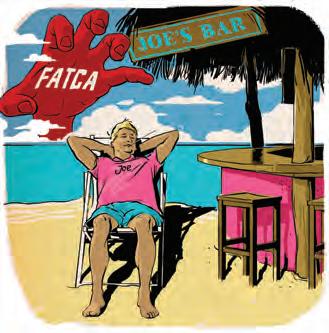
EXPATS
Imagine an expat coming to the US on assignment, not knowing how long he will stay. As soon as he becomes a "US person" (for legal tax purposes), he may be forced to close all foreign accounts and bring his money to the US. Depending on the na-
By MEREDITH MAZZOLA
ture of his investments, this could result in unnecessary losses.
Previously, expats on assignment in the US were eager to obtain a green card to become competitive in the US market without the restrictions of a particular work visa. Now expats must weigh these advantages with the negative tax consequences of becoming permanently tied to the US. Workers that are tied to the US now face the challenging decision of whether to formally expatriate. In the first half of 2013, 1,809 individuals expatriated from the US. If this trend continues, it will be nearly double the amount of people who expatriated in 2011.
Expatriation may sound like a great idea, but the US won’t let you get out easily. The US imposes an exit tax on long-term green card holders (generally those holding their green card for 8 years) and US citizens. The tax is imposed on those that meet any of the following criteria:
1. A total net worth of over $2,000,000;

2. An average annual tax liability of $155,000 or more;
3. The inability to certify that they have complied with all their US tax requirements.
The exit tax is capital gains tax imposed on the hypothetical sale of all of one’s assets.
A PRACTICAL EXAMPLE
The most notable expatriate affected by this law is Eduardo Saverin, co-founder of Facebook. Saverin, a naturalized US citizen, decided to bite the bullet and pay the exit tax prior to Facebook’s IPO. Because Facebook’s stock actually declined in value, Saverin may have paid more tax than if he had waited. As a young man, he will likely benefit in the long run from expatriation, as his income and wealth will inevitably increase. Those who are not young multi-millionaires may not be so lucky.•
Work Style — #12.13 31
The US has launched an aggressive campaign to narrow the international tax gap by targeting US taxpayers with assets abroad. With the enactment of the Foreign Account Tax Compliance Act (FATCA), catching US tax evaders is becoming a matter of “when,”not “if.”
Illustration by Tomek Karelus, Warsaw, Poland
[W facebook.com irs.gov]
➜
➜
➜
➜
➜
➜
Best Practices in HR Management Performance
By PALLE ELLEMANN KNUDSEN
Athletes at Work
Depending on the sport, an athlete's career can be relatively short. Football players typically retire from the field at the age of 35, while a female gymnast's career may be over by her early twenties.
Some athletes have made enough money during their career to be able to choose whether or not to start a new career. But many athletes face the reality that what has been their sole focus, typically since childhood, cannot continue any longer, and their life must take a different direction. Often these athletes do not have a high school or college education, or even a network outside their sport, and it may feel like starting all over again. Some athletes will seek opportunities within the sport because it is an easy bridge to a new life where they can leverage their previous career. But the need for coaches and managers is limited, and some players are not very successful coaches.

FEW JOB OPPORTUNITIES IN ROWING
dedicate time to personal development.” Ebbesen is also stressing physical condition and the importance it has for mental fitness and people’s ability to perform at work. In the last ten years, the corporate world has started to realize this, and more companies have health programs in place for employees. “To bring mind, body, and spirit to peak condition, executives need to learn what world-class athletes already know: recovering energy is as important as spending it.” Ebbesen is clearly leveraging his experience and successful sports career, bringing it into a different context.
CHANGING THE GAME
While most athletes prefer to continue in the world where they have earned their success and built a network since childhood, others use the opportunity for starting a completely new and different career. Garry Kasparov has been the highest rated chess player over time, with a number-one rating from 1986 to 2005.
KEYWORDS Performance ➜ Self-awareness
Recovering energy
Branding
Determination
Result oriented
from his chess career to politics for his own candidacy, at least not enough to seriously challenge President Putin. The question is, are the rules of the game in Russian politics so different from those of chess? And even the chess master cannot win with only one pawn against the Putin army of rooks and bishops. Kasparov has not retired completely hess and regularly does show matches and coaches some of the current leading players of the world. Additionally, he writes books about chess and different chess masters.
FROM SHOT PUT TO POLITICS
Olympic silver medalist in shot put, Joachim B. Olsen, made it into the Danish parliament after he had to stop his active athletic career in 2009 due to injuries. Since early retirement, Olsen has leveraged his popularity to participate in a range of TV shows, including winning a season of the Strictly Come Dancing show. A surprise to many people, he announced his candidacy for the Danish parliament in 2011 and was successful. Olsen has achieved significant media coverage not only because of his background as an athlete, but because he has been very vocal in debates and on various occasions has contributed controversial opinions. The press has had their share of fun publishing the spontaneous controversial comments coming from this inexperienced politician, but Olsen is not the kind of guy to give up easily. So he has continued working hard to build a position in the political arena. He will probably earn a second term in parliament, if his party does not lose too much support. Voters like hard-working people with determination to produce results.
Other sports are less of a business and leave athletes dependent on government subsidies with few career opportunities after an active career. Olympic gold-medalist in the double sculler rowing competition in London 2012, Rasmus Quist, is working part-time as a plumber, while trying to keep up with his rowing training and competition. Another Danish rower, Eskild Ebbesen, has participated in the last five Olympics and won three gold and two bronze medals for Denmark in the men’s lightweight coxless fours rowing competition. In the beginning of his rowing career, he had to have a parallel career, which began by completing a college degree in sports physiology and later working as an independent consultant. He is using his training and experience in two areas of performance--carrying out health tests to work with health issues and working with team spirit and motivational training in companies and other organizations. ““People often forget to [W aljazeera.com alwaslsc.ae bbc.co.uk davidbeckham.com eskildebbesen.dk kasparov.com mariasharapova.com psg.fr sugarpova.com]
At the end of his professional chess career, he became active in Russian politics, in fierce opposition to the current President Putin. In 2007, Kasparov announced his candidacy for the presidential elections, but he later had to withdraw from the race because, he claimed, it was impossible to rent a suitable meeting room for gathering his supporters to endorse his candidacy. Kasparov is still active in the Russian opposition and human rights movement, and was arrested last year in a protest in support of the Pussy Riot members. Kasparov was politically active even during his chess career, supporting Boris Yeltsin’s campaign in 1996, among other things. But he has not been able to leverage his popularity
32 Work Style — #12.13
➜
➜
➜
➜
The Fearless Project by Jeff Sheng began as an independent photography project in 2003, when he started documenting "out" lesbian, gay, bisexual, andtransgender athletes in high school. Between 2003-2006, Jeff photographed about 30 athletes and then began to exhibit and speak about the work at various high schools and colleges as an educational endeavor to decrease homophobia in sports among students. The project has been exhibited in over 50 schools across the US. [W fearlessproject.org jeffsheng.com]





LEVERAGING THE BRAND VALUE
Athletes increasingly become aware of and deliberately manage the brand value of being a well-known person with lots of free media coverage across sports sections, as well in the tabloid gossip arena. At twenty-six years of age, Maria Sharapova, one of the best female tennis players, has already established her own product brand of sweets, Sugarpova, which has been launched in several countries. Sharapova tells BBC News that she has been pondering for some time what she would do when her tennis career ends. And then a long period of recovery from an injury actually gave her time to put her thoughts into action and launch a product. Later, she wants to move into fashion and cosmetics. But for now she still has some good years of tennis left, so business has to be taken care of between training and tournaments. Sharapova has probably been inspired by British footballer David Beckham, who has, more than anyone else, made a brand of his sports career. Beckham has just retired from pro football, but it was clear during his last years in football that it was just part of his branding strategy. He even gave the salary he earned in his last club PSG to charity. It is clear that strong media coverage of sports is giving successful athletes an advantage, or even a platform, for a second career after sports. Additionally, athletes often have unique experience in teamwork, discipline for intense practice, and awareness of personal strengths and weaknesses. These are skills that can be very useful in a business context. On the other hand, athletes who have been so focused on their sport that they lack a formal education have a hard time changing career paths, since their entire network is built around their sport. •

01 Jamie, Rugby, Track and Field, Volleyball and Tennis, Whitney M. Young High School, IL, 2007, 02 Tanner, Varsity Football, Mt. Pleasant Community High School ('11), IA, 2012, 03 Brayan, Boys Wrestling Team, Harrisburg High School, OR, 2010, 04 Jamal, Track and Field Team, Dartmouth College, 2006, 05 Deb, Fencing Team, Brown University, 2009, 06 Ben, Men's Lacrosse Team, Bowdoin College, 2010, 07 Sam, Men’s Swimming, Amherst College, 2011, 08 Keturah, Women's Basketball, Duke University, 2010


Work Style — #12.13 33
07 05 03 01 02 04 06 08
Best Practices in HR Management Attachment and Pride
By JONATHAN D. MESSINGER
The Carrot or the Stick?
The perception of values in the workplace can vary signficantly depending on factors such as gender, age, or the country one works in. This puts in question the boss’s leadership style: fear and guilt or altruism and engagement?
It is an age-old question: which personal style should the boss use to engage the team, the carrot or the stick? It is an age-old question: which personal style should the boss use to engage the team, the carrot or the stick? Some assume people are by nature lazy, always seeking the lowest level of energy exertion. By yielding a big stick the thinking goes, authority figures accomplish more; fear, guilt, and micromanaging pay off. Others, however, believe the carrot is most engaging; that by demonstrating tolerance, altruism, and positive reinforcement, one obtains increased productivity and efficiency. Ask a highly paid consultant; for a fee of a few thousand euros, the answer you get back just might be “it depends.” Perhaps it depends on whether you are the visionary leader or the finance manager chasing six-month-old receivables. Maybe it depends on an individual’s political, theological, or philosophical beliefs: we only live once and the hell with who gets hurt on the climb to the top; or we live many lives and reap what we sow. Maybe Darwin had it right; it’s survival of the fittest. Let’s dissect this seemingly complex and age-old question and skip the highly paid consultant.
COMPANIES ARE JUST LIKE SHIPS
First, consider the primary daily order in the human operating system, our OS. When we come to work each day, what do we do? Basically, we point and shoot. Humans are teleological in nature; we all need to have a target and know where we are on the path to hitting it. If a leader fails to accurately define the target, you cannot blame the staff for missing it. On the other hand, if the leader does his or her job, but the manager fails to provide a feedback mechanism,
how can the staff possibly know whether they are off course or how to self-correct? In this case, the company is no different than the crew of a ship without a destination, rudder, or captain. No one will be engaged in the task at hand; and when you eventually realize you’re spinning in circles, people will start pointing fingers and casting blame. At the end of the day, morale will plummet and with it employee engagement. The moral to the story: every organization must first have a clearly articulated target—a measurable goal at a specific point in time— and feedback mechanisms in place.
If you don’t have these fundamentals, chances are pretty good that leaders and managers alike might have to bring in a stick big enough for the Hulk to swing around, just to get everyone to quiet down and listen up.

TARGET NEEDED
Let’s assume we have a target, the path is clear, and a feedback loop is in place. The carrot or stick: recognition or guilt? The personal style question might now depend on understanding the role and responsibilities of the employee in question: is he the leader responsible for communicating an inspirational vision, or the manager maintaining control and order? Typically, we follow the guidance of the leader because of his personal and charismatic power, and of the manager because of institutional power. On the other hand, an altruistic finance manager might destroy the cash flow, while a fear-mongering leader may inspire isolation instead of innovation and creativity.
It is time to take these concepts down to practical reality and consider two scenarios to test your thinking and personal style. Regardless of your organizational position, we all have a leadership and
management style. That method not only depends upon your role and responsibility in the organization, but on your personal values and beliefs as well.
ENGAGEMENT AND ALTRUISM
Imagine for a moment that you’re the CEO, and one of your most valuable employees, Paula, just came into the office crying. Her husband is dying of cancer and Paula needs time off to take care of her husband and family. She will be absent for months, not weeks. Essentially you have two choices:
1You sympathize, perhaps empathize, with Paula, but policy is policy. Paula can use her two weeks of paid vacation, but then she must return to work or risk losing her job. There is just no guarantee the position will be there when she returns after twelve weeks.
2You assemble Paula’s team and devise a plan to balance the work, which will allow her three months off with pay. You notify everyone in the office of Paula’s personal situation and ask for volunteers to help out the family however they can.
GUILT AND RECOGNITION
Your technology consulting company has just spent $250,000 on a team of twenty people, working for three months to submit a competitive $65 million systems proposal. The results are in. Your proposal came in at the lowest price and was rated highest for technical quality, but you’re disqualified because it was turned in two minutes after the deadline. You have two choices on how to deal with the pursuit leader:
1Conduct a search for the guilty party, chastise them in front of the entire organization, fire the culprit, and thereby
34 Work Style — #12.13
[W jdmessinger.com]
Volvo Ocean Race 2011-12.


Photocredits by: 01-02-04 Yann Riou/Groupama Sailing Team/Volvo Ocean Race (Groupama Sailing Team).

03-05 Hamish Hooper/CAMPER ETNZ/Volvo Ocean Race (CAMPER with Emirates Team New Zealand), 01 Martin Stromberg
02 Media crew member Rick Deppe. (PUMA Ocean Racing's il mostro)
03 Stuart Bannatyne and Adam Minoprio pass into the 'furious fifties' on their way South to Cape Horn

04 Jean-Luc Nelias during leg 1
05 Onboard medic Tony Rae administers three stitches and anaesthetic bowman Mike Pammenter, after suffering a broken tooth and gash to the face in a fall during a sail change.

make it clear that such incompetence will not be tolerated.
2Call in the pursuit leader, investigate what went wrong, then have the investigators conduct pursuit leader training, turning a $65 million dollar mistake into a priceless lesson for future teams.
IN THE END
We could develop a list of pros and cons for each scenario, but the ultimate decision will be based on the target and path of your organization. The target is your organizational purpose—your reason for existence—and the path is the combination of values and beliefs of the enterprise. If your organization's purpose is to serve a greater good, the individuals within the organization will be more inspired, engaged, and energized and your answers to the above case studies will likely reflect the more tolerant, patient, and understanding approach. Paula will be given all the time she needs to care for her family; the team will support her knowing that someday the same thing might happen to them. And the pursuit leader will train everyone on the lessons learned in submitting proposals on time. Finally, the leaders and managers will balance the needs of the company with that of the individuals and think more long-term. The company that demonstrates altruistic tendencies and balances the needs of its people with shareholders will have more innovation, creativity, and sustainable growth. If, however, your corporate purpose is to exceed the analyst projections in the coming
KEYWORDS Attachment and Pride
quarterly earnings or maximize a performance bonus, then chances are your employee engagement is below twentypercent, loyalty and productivity are low, and employee attrition is high. In this mindset, the needs of the individuals are subservient to results, and staff is considered a disposable commodity. Paula will be left without a job after two weeks; the pursuit manager will be fired in disgrace; and employees will hide in their cubicles. No one will ever want to be a large pursuit leader; and what’s worse, when trouble strikes, the staff will resort to a basic animalistic nature by pointing fingers and covering every move with emails copied to a dozen people. •
Work Style — #12.13 35
02 01 03 04 05
➜ Understanding the roles and responsibilities of an employee
➜
Provide a feedback mechanism ➜ Balance the needs of the company with that of the individuals
Best Practices in HR Management Communication
KEYWORDS
Communication ➜ Competitive Intelligence is legal
Talk more openly
Importance of information security
Employee background checks
Mr. Saito, This isn't Your Typical Corporate Espionage
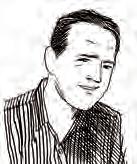 By LUCA BRUNONI
By LUCA BRUNONI

Trashcans, supercomputers, and the insider threat: corporate espionage practices include dumpster diving, rummaging through a competitor's trash hoping to hit pay dirt, reverse engineering, and full-fledged cyber attacks. These threats have one thing in common: they come from the outside.
Inception, 2010’s blockbuster movie, took the idea of corporate espionage to a whole new level. Its protagonist (Mr. Cobb) is a spy who, according to director Christopher Nolan, "is hired by corporations to steal secrets they would otherwise never have access to." He does so by entering people’s minds while they sleep and extracting valuable information. The premise is fictional, but the idea that a man with Cobb's talents would have a long list of clients is everything but.
INFORMATION IS POWER
Success in business often means staying one step ahead of competitors, and this implies keeping tabs on what they are doing. “Competitive Intelligence is the process of ethically gathering and refining information enough so that it can be used to make a strategic business decision,” says Leonard M. Fuld, President of Fuld & Company, Inc. “It is not spying, which implies illegal or unethical activities.” Sometimes, however, the desired information cannot be obtained legally: intellectual property, trade secrets, marketing and business plans, R&D data, client lists, etc. When the game of competitive intelligence is taken too far,
we enter the territory of corporate espionage (CE). But in a day and age where truckloads of data can be carried away on a microscopic USB key, companies must pay closer attention to what goes on within their ranks. “One of the easiest ways to gain access to company data,” says Christopher A. Hagon of Incident Management Group, “is to gain cooperation from an employee on the inside.”
The classic scenario involves bribery, but sometimes information can be obtained from employees who inadvertently give it away (or are duped into doing so) because they do not recognize its sensitivity. A classic alternative consists in hiring away workers hoping that they will bring company secrets (disregarding nondisclosure agreements) or make the best use of the expertise they have gathered during their previous employment. Unhappy employees are easier targets in both cases, as the desire to damage the source of their unhappiness might prove just as strong a motivation as the prospect of monetary gain.
WHAT TO DO?
If you make sure nothing worth protecting ends up in your trash, even the most resilient dumpster diver will come
up empty handed. A solid legal and technical framework of protection goes a long way to thwart external CE actions; control access measures such as data encryption and firewalls are obvious steps to be taken. The next stage, Hagon suggests, is employee awareness, “Firms should conduct periodic training and awareness campaigns,” he adds “to inform employees about the threat from industrial espionage and the importance of information security.” Employee surveillance, in the form of background checks and behavior assessments, is also acceptable when important secrets are at stake, but companies must seek a balance between necessary measures and big brotherism, or they might end up undermining the well-being of their employees and the atmosphere of their workplaces.
Finally, some experts are convinced that the battle against CE must be fought more in the open. Pamela Passman, founder of CREATe.org and a former deputy general counsel for Microsoft, encourages companies to “talk more openly” about the issue and to “recognize that the company next door is having a similar challenge.” Some information is definitely worth sharing.•
By NIGEL PHILLIPS
It is not unusual for employers to monitor employees’ computers or smartphones, but most of us don’t think about this during our work day and spend time in the office reading personal emails, updating Facebook or even checking out other employment opportunities.
WHAT’S
AVAILABLE
Programmes like ActivTrak let you know what websites your employees frequent at work. TeleNav Track, an organizational tracking system, lets you monitor and manage remote employees from afar and get a detailed understanding of behaviour and a clearer sense
36 Work Style — #12.13
01
➜
➜
➜
Big Brother is Watching You (Probably)
The Neighbors is Arne Svenson’s most recent series. In this work the artist has turned outward from his usual studio based practice to study the daily activities of his downtown Manhattan neighbors as seen through his windows into theirs. Svenson has always combined a highly developed aesthetic sense viewed from the perspective of social anthropology in his eclectic
projects with subjects ranging from prisoners to sock monkeys.
Photos by Arne Svenson.



"The Neighbors" (2012). 01 #5, 2012, pigment print, 44 1/2 x 30", ed. 5, 02 #13, 2012, pigment print, 30 x 51", ed. 5, 03 #15, 2012, pigment print, 30 x 48", ed. 5.
Photos are Courtesy of Julie Saul Gallery, New York.
of strengths and problem areas within your business. These tools, however, come with the potential risks of violating employee privacy, or creating a culture of paranoia.
INTERESTING DISCOVERIES
Ben Waber, CEO of data collection firm Sociometric Solutions says there are definite upsides to knowing what your employees are up to. Sociometrics uses RFID chips embedded in ID badges to track employee behavior, collecting data on everything from employee location to the type of interactions they have with each other. The company’s chips know where employees go on their breaks, with whom they interact in the office, even how they speak to co-workers and colleagues.
BETWEEN BOUNDARIES
There is an old saying, “Locks are for honest people. ”Since most crooks can bypass locks and management due diligence, using accounting methods is also for honest people. Employers can and should use accounting mechanisms at times, but without probable cause, they could be headed for trouble. Sometimes employers install keylogging programmes that record every keystroke you use on your computer, letting them see everything you are typing, including your passwords, a fairly intrusive practice. Many companies have written policies stating the company can monitor your email. If the computer system belongs to the company, it can monitor employee communications, even if you use a personal email address. So if you are sending inappropriate messages or confidential information, you will probably get busted.
INTERNET USAGE
Your employer is almost certainly monitoring your Internet usage. So, if you are checking out porn sites, YouTube or Facebook, your
employer will know about it, and you may be violating a company Internet usage policy. Andrea Bonior is a clinical psychologist and blogger for Psychology Today. She says there are many workplaces that have cameras set up, but it’s rare in an office setting. They are more likely to be found in factories where companies are trying to gauge productivity. She says, “Certain corporations are very paranoid about what kind of intellectual property they might lose,” but that for a lot of companies, spying is just about the bottom line. “Companies are very concerned with wasting time. A lot of companies justify it by saying 'we don’t have that much money.' It’s either lay people off or increase efficiency.'”
CCTV AND MICROPHONES
Video surveillance is generally legal but must be used for a reasonable purpose, such as preventing theft, or maintaining security. In many cases employees will not know they are being filmed. Video equipment in the bathrooms is a definite no-no. Audio surveillance, however, is a different matter. It is illegal to record oral communication in a surreptitious manner without consent. Any recording must be done for legitimate business purposes, such as customer services, and if your bosses are recording you, you probably signed a consent form on joining.
THEIR PROPERTY, THEIR RIGHT TO KNOW
If you work for a company that you think is spying on you, make sure you moderate your behavior. Don’t send personal emails from your company account, don’t spend hours checking Facebook or playing Angry Birds. If you need to conduct non-related work during office hours, do it on your own smartphone or tablet. Jaffe says, “Recognize that you are in a fish bowl. The boss has every justification for looking at what’s on his property.”
[W activtrak.com arnesvenson.com create.org fuld.com saulgallery.com sociometricsolutions.com telenav.com theimg.com wyattjaffe.com
Work Style — #12.13 37
]
02 01 03
Best Practices in HR Management Change Management
Stefano Bartoli, the Timenaut of the Lagoon
Stefano Bartoli is the owner of Bagni Alberoni, a historic beach property on the Venice Lido. He’s young at sixty, with a head of hair that suggests a bush. Refreshingly open, disarmingly honest, Bartoli is a former chemist whose dad wanted him to be a ski champion, but who fell in love with baseball instead.
The steamboat departing from Santa Lucia Station struggles as if going uphill.
The lagoon is jade green under an insolent sun; gondolas sway. I can smell the water and fumes of marine exhaust pipes. I count tourists in groups of hundreds. The whole world is in Venice!
The steamer leaves the Grand Canal puffing along, southbound. Beyond the Giudecca and its canal, we can clearly see the long strip of land called the Venice Lido. One more bus and I’ll meet Stefano.
ws From chemistry to the beach: what do you call this career change?
sb It could be called destiny. Actually, I come from a family of chemists, including my grandpa, dad, uncles, cousins, and sister. It seemed inevitable that I would become a pharmacist too. I graduated in biology, and then after two more years finished in pharmacy. For family reasons, I started working with my sister who inherited my father’s chemist shop in Padua. We worked together for years. It was a job that brought income as well as satisfaction, but increasingly I felt drawn to a different life. I wanted to leave the city
and be close to nature. I am an anticonformist and a rebel; this is the true legacy of my dad.
ws You mention your dad. How did he infuence you?

sb My dad was a visionary, a genius-anticonformist. I had a lot of friction with him, but he had the great insight to push me toward my dreams, to encourage me to develop my ideas consistently, without worrying about what others thought. One day he left the pharmacy, bought a piece of land, a “rock” on the Marmolada, and built a prefabricated house where he lived happily for the rest of his life.
ws An important trail. How did you end up buying the Bagni Alberoni on the Venice Lido?

sb Once the decision to leave Padua and the pharmacy was made, I had to convince my wife Daniela to resign from her job so we could pursue this adventure together. We looked for a place in Veneto and Tuscany for a long time, and visited many places. In 1995, we went back to the Venice Lido, an island that we loved. The Bagni Alberoni arose in all its wonderful decadence. The facilities were obsolete and ugly; rain leaked in from the roof; the water system worked by fits and starts. There were a thousand things that didn’t work. But the place was amazing, the nature
Four exciting new life stories:
• Maria Bodelón
• Guido Rabà
• Luis Montalvo
Meceiras
• Lamorna Trahair
I’d thought that I wanted a career, but then realized that there’s a trade-off in your personal life.
María Bodelón Maceiras is a Spanish professional. After a promotion, she suddenly realized that a good career and great money wasn’t the key to happiness.
ws What were you doing before changing careers?
mbm I was working in the finance department of British American Tobacco.
ws What made you change so dramatically?
mbm I had been working for the company for almost five years and then got promoted. I thought
38 Work Style — #12.13
Text and Photos by ROBERTO BENZI
➽
] 01
[W avonandsomerset.police.uk bagnialberoni.com centrodeocioluismiguel.com envialia.com italcaribeclub.com semillaparaelcambio.org
tasted of the wild and we were only 20 minutes from Saint Mark’s square. We fell in love and, after long negotiations, we purchased it.
ws How much did you pay for the beach property and how much does it need to run?
KEYWORDS Change Management
➜ Finding myself
➜ My dad was a visionary
➜ We are a big team
➜ Giving a new imput to the community
sb We needed 235,000 euros at first, then a series of expenses for ordinary and extra maintenance. The annual concession costs 36,000 euros, and waste removal runs 30,000 euros—this for a season that lasts, on average, 100 days a year. It wasn’t always easy. We had difficult moments and problems of
various kinds, including my separation from my wife.
ws How much land does the beach resort occupy and what services do you offer to guests?

sb The beach property covers an area of of nearly five acres, including the beach
01
02
that was my ambition, to be a good manager and have a good salary. In many ways it was, and I worked very hard all along. But then I realized life wasn’t turning out as I had expected. In 2008 I visited India, traveled around for three months, and was strongly affected by what I saw.
ws What are you doing now?
mbm I decided to quit my job and do a master’s degree in Development. I never thought I would set up a NGO. Now I live in India, since 2009 where I run Seed for Change.
ws What sort of investment did you make in this career change?
mbm The investment was very high for me personally. Since I wasn’t making any money myself, I had to dip into my savings to support myself and cover my expenses, which are not high in India, but one needs to live. Even now I don’t get a salary, I just cover my expenses.
ws Are you happy now?
mbm Yes, I am happy. Still, if things don’t improve, I’ll have to find a way to support myself.
Work Style — #12.13 39
Venice from the steamer
The cabanas at Bagni Alberoni
02
When the morning bell rang in Italy, you heard, “It’s the postman, you need to sign.” It had become my worst nightmare.
Guido Rabà is an Italian entrepreneur who, at the end of 2010, decided to leave his home country to move to the Isla Margarita in Venezuela, where he built a new life, both on a professional and personal level.

ws What were you doing before the move?
gr In the last twenty years, I owned a construction company, a business that at first worked in refurbishing and, in the last seven to eight years in building luxury properties. It was a prosperous business.
ws What made you decide to change?
gr In an end-of-year meeting with my accountant, she told me, “Guido, this year went well; our turnover increased.” “That’s great,” I said, “but be honest with me; how much have I earned for myself and my family, net?” She said, “Well, after everything, 24,000 euros!” At that point, I
thought there was something wrong. At the end of 2010, I gave myself a month and warned everyone that I was leaving to see if Margarita Island was for me.
ws What are you doing now?
gr In April 2011, after being on the island for only four months, I started a tour operator business called ItalCaribeClub. We work in two ways: we organize holidays in Venezuela and now also in Cuba and Panama; and we help and support people interested in following in my footsteps, who then move here.
ws What investment did you make?
gr I arrived with basically no money, but was lucky enough to create something like ItalCaribe Club. From the beginning, this business has produced income. It’s clearly not great by European standards, but here If I earn 100 euros on one trip, I am earning half the monthly wage of a clerk.
ws Are you happy now?
gr This is the hardest question. On a professional level, I’m very happy. I live with much less stress. I have the time and resources to do the things I love and I wake up in the morning with a lot of energy.
40 Work Style — #12.13 03
➽
and the building that houses the restaurant and a kiosk. We offer 135 cabanas and 180 parasols for an accommodation capacity of about eight hundred units. The restaurant is open everyday, both for lunch and dinner. The kitchen is wellknown and serves traditional dishes and some that are a bit more exotic. It attracts outside customers as well as guests. My three sons manage and work at the kiosk, a place for young and slightly older people, that serves aperitifs, cocktails, and cold drinks. There’s live music, and evenings there are a delight.
ws How many employees do you have?
sb We are a big team, beginning with family. In addition to my former wife Daniela and myself, there are our three sons, my new partner Alessia, and our son—Alessia’s and mine. There are also twenty-three others on staff, including cooks, waiters, lifeguards, and attendants. They are all exceptional people, motivated and energetic. My staff also has two guys from Bangladesh, a Polish gentleman, a Lebanese fellow, and a Moldovan lady.
ws You were a chemist for a good part of your life, and now you’re managing a beach resort and a succesful restaurant. What is Bagni Alberoni’s turnover?

sb I still remember my first day. I was serving coffee when I accidentally hit a treebranch, cutting my head, spilling the coffee in front of customers, and scalding my hand. Then came the time a sec-
tion of the ceiling fell onto the restaurant floor; and finally, a large woman broke a chair and fell head over heels onto the floor. That made me stop and think. The job was completely new to me, and I want to single out Bepi, a senior worker, hired by the previous owner, for helping me so much, especially in the beginning. At present, our turnover is about 500,000 euros a year, but there are many expenses.
ws What’s the secret of your success? sb I worked hard and believed in it. We bit the bullet when it was necessary. We thrived during some fantastic periods, and kept working. Our guests experience peace and the freedom to enjoy their holidays. Children play when and how they want. There’s room for everybody. I dislike restrictive rules. Guests must feel at home.
ws Old vinyls hang on the walls, photos of singers like Giorgio Gaber or Frank Zappa playing naked on the toilet; and Prodi’s interview to Enrico Berlinguer. What does all this have to do with you?
sb It's still me, even after many years. I loved the Rolling Stones. I met Gaber and we talked for hours. Those things are a part of my life.
I see an image of a timenaut in my mind that around the year 2000 came on a trip to Venice and never left. Why? What did you find here?
sb Myself.
I had wanted to leave the chaos of Madrid and return to my roots. The loss of my boy was the final push I needed.
Luis Montalvo is a Spanish entrepreneur who began as a messenger boy until he opened his own business. The stress of owning a company, but above all the tragic loss of his son, prompted him to return to his roots and create a leisure center in memory of his child, Luis Miguel.
ws What were you doing before this change in your life?
lm I began in the delivery world as a messenger when I was young. One day my ex-wife was laid off, and with her dismissal compensation I was able to set up my own business. At the beginning it was difficult, a loan wasn’t an option, so I had to sell my car and motorbike to pay my employees, but then things started to work out. ws Why did you make the change?
lm I’ve always had a deep connection with the village where I grew up. It has always been a place of solace and relaxation; and after such a stressful situation, it was the only place to find relief. In 1998, my son was diagnosed with cancer and passed away two years later. During his illness, we talked about how much we loved karting. I promised him that once he was better, I would build a track for us. It never crossed my mind, at the time, that it might provide income. ws What sort of investment did you make?
lm We had to start again from scratch. I mortgaged all my assets, my two houses as well as those of my brother and my nephew, and assets of my family, who supported me 100 percent. We knew that we needed 800,000 euros to get started. I also received funding from the EEC. Overall, the entire project cost us two million euros. ws Are you happy now?
lm Now I work where I live, and that gives me time for my family. I’m very happy, if you can measure happiness. Often, happiness doesn’t depend on what you have, but in enjoying time for yourself, earning money to get by, and doing something you really love.
Work Style — #12.13 41 04
03 A pensive Stefano Bartoli 04 Dad Stefano with two of his kids (Stefano and Lorenzo)
➽
I worked for three years as a Special Constable (a volunteer police officer), which provided a good foundation for the career I wanted.
Lamorna Trahair has had a varied career since leaving school. She initially wanted to study Medicine, but University rapidly fell in her list of priorities. After many miles sailed, and being named among the “Top 35 Women Under 35,” she joined the Police Force.
ws What did you do before changing careers?
lt I was working for the Round-the-World Yacht Race as a race officer and I set up, as one of four founding directors, an adventure travel company. We developed what turned into a very successful company, running multiple events worldwide and raising over £1 million yearly for charity.
ws What pushed you to shift gears so dramatically?
lt Joining the Police had always been something I considered, but other opportunities arose. Once I decided it was time for a change, though, I mentally reviewed the previous jobs I'd had and identified the aspects I'd enjoyed most in each.
ws Why did you choose this profession?
lt I could enjoy the advantages of a “portfolio” career as well as the benefits of stability in having just one employer. It was also a career that involved less travel abroad, but still involved interaction with a wide swath of society. It also promised an element of excitement.

ws What type of investment did you make for this career change?
lt The move involved some initial sacrifice. I’ve had to curtail my expenses, but I see this as necessary to pursue the career I'm so passionate about. The biggest investment for me personally, though, is that of the intensive training period.
ws Are you happy?
lt Absolutely! I've always felt that being able to respond to the generic question, “So, what do you do?” with pride and enthusiasm is the best measure of job satisfaction.
There’s a moment of silence when a middle-aged woman approaches. “Sorry to disturb,” she says with a strong Veneto accent. “But I want to testify that Stefano has made a great contribution to this area. What he’s done is not only for himself, but for all of us who have been coming here for a long time. New activities are available; streets are clean;, dodgy people have moved on; and the community is much more content.” Some curious onlookers approach, nod, add a few details, and basically fly the flag of the Bagni Alberoni very high. Stefano Bartoli slips away with his private thoughts. His modesty has silenced them all. But in doing so, he has answered the question I didn’t even ask.•
42 Work Style — #12.13
➽ 05
05 The beach resort and the waves All photos are by Roberto Benzi, Milan, Italy.
Best Practices in HR Management Culture Integration
KEYWORDS
➜ Culture Integration
➜ The real industrial revolution will begin from the distribution
➜ The cost of 3D printers will go down
➜ Instant access is attractive
➜ Need of a new professional role
Love Making
By ALEX DI MARTINO

Creativity is probably the most innate and fundamental feature of life. And life – to continue – needs creativity. We create other human beings. We create things and we constantly try to improve them.
And this is the spirit of the 'makers' – they love making things.
THE MAKERS MOVEMENT
Making things has recently become a movement in various countries and a crusade that may be a modern iteration of the Industrial Revolution. A growing number of people around the world are driving consumer, social and economic change that is impinging on established business models in manufacturing and technology.
MEET A MAKER MANIAC
To explore this phenomenon, I had a conversation with Massimo Temporelli. Massimo is a physicist, and a historian of technology.

ws What is the difference between the makers phenomenon and simply having a hobby and building a bookshelf or knitting a scarf at home? mt What is happening reminds me of what happened with computers. Back in the 1970s, only a few people, whom we called geeks, had access to and could handle computers. They were really hackers who were taking computers apart to see what else could be done with them, aside from boring calculations. Now computers are everywhere, and nearly everyone interacts with them on a daily basis, wheth-
er it's a mobile phone or a computer at work. Just as hackers paved the way to personal computing, makers are now building the foundation for digital fabrication, a system allowing more and more people to make things for themselves.
ws What are these “things,” and why are 3D printers are important? mt Consider objects that we use every day, like a cup, a glass, a pen. 3D printing represents a milestone for this process. Take, for example, a sunglasses designer. You may get bored with the frame you have and want a new frame for the summer. With 3D, you will use the designer website to purchase and download the design in the form of a 3D printing instruction file for your 3D printer, and print the frame at home. This will clearly revolutionize the current business model in terms of business cycle, distribution, stock, and so on, which will result in a much lower cost for the consumer.
ws Are we talking about another Industrial Revolution? mt The real revolution will begin with distribution. Simply imagine what impact this could have on raw materials, industrial stock, transport, and energy. Skipping and partly decentraliz-
ing these processes will have immense repercussions.
ws Will I still go to stores to buy food and clothing? mt Yes. At the moment it is hard to know what will happen to certain consumer items, but there are some experiments currently underway with food items, and there are already certain shoes that can be printed.
ws What materials are available for printing now? mt Nylon and ABS wood which is a paste of wood. But there will be more materials available in the future, and the cost of 3D printers will go down, as usual in these cases.
ws The Internet has also allowed sale and distribution of rare or “restricted” items, like rare books, stamps, drugs and sex toys. Do you think that 3D printing will contribute to this as well? mt makerlove. com is a site offering downloadable innovative designs for sex toys. One can then print them at home, avoiding the possible embarrassment of buying these items in a sex shop.
ws Instant pleasure? mt The immediate access to an item is very attractive, as with downloadable music or film. You listen to a song, you like it and you can have it immediately. This will happen for more and more goods.
ws And the world of work? How will it change? mt Initially there will be three areas affected. A designer or architect will print prototypes himself, saving time and closely monitoring the final design. Then a new kind of professional consulting will be needed, as with the Internet, to advise companies in adapting to these business changes. Finally, electricians, plumbers, and other traditional artisans will be able to recycle their old skills, developing new products and new skills to bring new technologies to our lives and our homes, such as intelligent heating or water management systems.•
Work Style — #12.13 43
Illustration by Les Herman, Chicago, USA
Best Practices in HR Management Culture Integration
By MARTHA TINTIN
From Kosher to Veganism

Progress in many areas has become synonymous with diversity. And so it is in the food services arena. With employees from many cultural backgrounds and religious faiths, companies need to emphasize variety in the kitchen so that dietary options will be available in the dining areas, accommodating all the preferences and needs of their workers.
WHAT’S HAPPENING IN FOOD SERVICES
Today, custom meal choices are found in all sorts of hospitality and foodservice operations, including corporate dining, schools, supermarkets, quick service restaurants, and even sports and entertainment facilities. Gary Prell, Vice President of Culinary Development at Centerplate explains: “Thousands of people are brought together for meetings of all kinds social, business, religious or educational. And they all share something, namely breakfasts, lunches and dinners.”
Meeting planners and employers who want to keep their guests, delegates, and employees attentive and responsive know that “the provision of food and beverage is critical. It's very hard to pay attention when hungry or thirsty,” says Prell.
Several decades ago, vegetarian meals or fruit plates were provided upon request for individuals who were uncomfortable eating meals heavy in protein. At the time, little thought was given to the preparation of such meals. “Today, however, is much different,” says Prell.
“People have much different tastes and preferences, and more sophisticated palates. And we are, as a society, much more susceptible to food allergies, and so value personal choice with regard to the foods we eat and beverages we consume.” What may have begun as a fruit plate has transitioned into vegetarian meals and beyond, he explains. “Typically for a large conference, we expect between 7 and 8 percent of the guests to request custom meals, so serving a fruit or vegetarian plate will no longer suffice. There are simply too many diverse requests and needs to satisfy, the most common including diabetic, glu-
ten free, lactose intolerant, low sodium, vegetarian, Indian vegan, Kosher and Halal.” Says Prell: “Our chefs take great pride in paying the same attention to quality, creativity and presentation in the preparation of custom meals as of the main meals. It's still about using great ingredients, handling them
with respect and cooking with passion. They will purposely connect the custom meal to the main meal by coordinating the presentations and using similar ingredients so no guest feels singled out.” Finland was the first country to offer free school catering to all pupils, initiating this practice in the late 1940s. Anu
44 Work Style — #12.13
Illustration by John Joven, Bogotá, Colombia
Kokko, Director, Marketing and Offering Creation at Fazer Food Services explains. “Our company operates in staff and student restaurants and schools in Finland, Sweden, Norway and Denmark where eating habits are similar. Today, our food options are broadening beyond lunch to include breakfast, coffee breaks, meetings, healthy snacks, and Take Away services. These are all important items; Take Away services, for example, are very helpful to employees in their everyday lives, enabling them to buy food portions, fresh bread, desserts, cakes, etc., for themselves and their families.” According to many surveys, lunch and coffee breaks are very important to business as they allow coworkers to have breaks together, which promotes a better work spirit and reduces stress. This, in turn, benefits the whole company. Today, according to Kokko, Scandinavian area people tend to request a lot of vegetables and want to control their protein intake, since as weight control is becoming increasingly significant.
THE LAST WORD TO THE (MICHELIN) STARS
The way of eating has changed. “In our case, we deal with all kinds of clients and requests. So instead of trying to satisfy them one by one, we fixed our menu so that everyone can find what he is looking for,” says Matias Perdomo, head chef at Milan’s Al Pont de Ferr. “We are a traditional ‘osteria’ from the outside; inside we’re a highly innovative restaurant, offering a menu and a tasting menu divided into sections: our tradition, innovation, panoramic view, and madness. We like to play, so to speak. In every little section you’ll find both traditional tastes and innovative techniques That’s our way of focusing on people’s changing tastes and demands.” Nowadays, customers want innovation in form but consistency in culinary style. They want a traditional and clean taste. Chef Perdomo claims his “Approach is getting an amazing response because we offer customers the chance to try creative food with a taste they already know from tradition. On the other hand, we also offer traditional
food with a shape and presentation that you really don’t expect.” Pedro Subijana, chef-owner of San Sebastian’s Akelarre agrees with his colleague. “Ways of eating are changing, especially for private and informal occasions. Of course, there are still exceptional dinners at high-end restaurants, but it’s a minority of people who now do that. Most prefer informal eating places like tapas bars, where you can have a quick bite and a nice wine. This is primarily due to the economic crisis, but also because the younger generation doesn’t like fancy or formal environments.” What is expected of a place like Akelarre? Quite simply, the best! And it should be unexpected and fun--and served with good wine. “Our staff,” says Chef Subijana, “is perfectly conscious of different dietary needs, and we have options available for all of them, as well as for allergies and food intolerances, which today are more common.” Clearly, the menu for employees eating out for pleasure is completely different from what they eat in the company’s canteen. Subijana notes that “food served in company dining halls is always criticized, and people always ask for a lot at a very low cost. Special diets are relatively manageable, but a thorough consciousness and acceptance of special needs is key, as lack of awareness often results in someone feeling rejected. Luckily, as soon as one knows the requirements of a specific diet, one can adapt multiple menus. Both kitchen and front-of-house staff need to have a wide knowledge of different diets to be able to standardize menus as necessary,” concludes Subijana.
Things seem to differ at the other end of the world. According to Chan Yan Tak, head chef at Hong Kong’s Lung King Heen, there hasn’t been a big change. He explains: “Cantonese cuisine is simple and always uses less oil and less salt to maintain the real taste of the food. People believe that Cantonese meals, such as steamed fish and stirfried vegetables, is healthy. So the only change we’ve seen is that people today ask for a lot of organic products.”•
[W akelarre.net centerplate.com fazer.com fourseasons.com pontdeferr.it wcrf.org]
KEYWORDS Culture Integration
➜ Vegetarian meals and beyond
➜ Take Away services help employees with their everyday life
➜ Alternatives for different dietary needs
SOME HEALTH CONSIDERATIONS TO KEEP IN MIND
The World Cancer Research Fund offers a health checklist that employers and employees should always keep in mind:
• Keep in shape. Scientific evidence shows that excess weight and obesity are significant risk factors for several types of cancer.
• Exercise daily. Suggestions include walking (at least part way) or biking to work and taking the stairs instead of the elevator.
• Limit your consumption of highcalorie foods and sugary drinks, such as prepared meals, snacks, desserts, and sweets. Replace sugary drinks with water. Consume fast food in moderation.
• Choose most of your calories from the vegetable food group. Eat least five portions of fruits and veggies. Include cereals and legumes in each meal, and limit the use of bread, pasta, pizza, and rice.
• Limit your consumption of red meat to ideally less than 500g (about one pound of beef, port, lamb, goat) a week, avoid fatty sections. Emphasize poultry and fish; avoid cold cut, or cured, meats, canned meat, and sausage.
• Limit your consumption of alcoholic beverages to a maximum of 2 units a day. (One unit equals a glass of wine, for example.)
• Limit your consumption of salt and avoid legumes and cereals contaminated by mould. To flavor foods, use herbs, lemons, balsamic vinegar, and spices.
• Obtain required nutrients by dietary means. High consumption of supplements can affect the risk of cancer, and in some cases increase it.
Work Style — #12.13 45
Best Practices in HR Management Unusual Job
 By MARTHA TINTIN
By MARTHA TINTIN
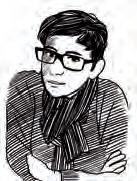
The Chocolate Factory
From Willy Wonka, the eccentric chocolatier brought to life by children’s author Roald Dahl in 1964, to the never-ending media fixation, we are constantly reminded of the magic of chocolate. Delicious and with real benefits for mind and body, chocolate is also a medium. And many now dedicate their life to creating art with it.
The background needed to enter the field seems to vary from art to culinary schools, as Christine Taylor, director of Choccywoccydoodah in England explains,: “My team of artists and sculptors are all required to have art degrees in illustration, design or sculpting. I am not interested in their experience, just in their potential to create beautiful things from chocolate, once trained to understand chocolate as their medium.” All of her chocolatiers are trained in-house and she deliberately employs people who can be trained by her and start with a clean slate. The training, however, can also be culinary, as Natascha Schwarzer, director of the Barry Callebaut Academy in Switzerland explains. “It is different in every country. I started with a 10-month baking and pastry college course in Canada, but knew I wanted to live and work in Switzerland as they are known for their pastry and chocolate. I was fascinated by the product and did a bunch of private courses in chocolate showpieces, pralines etc., throughout my apprenticeship and now career.” Another great way to break in is to work for the chocolate giants, like Lindt. This will give you the chance to visit cocoa plantations, take technology courses and deepen your knowledge and skills. Ernst Knam, German maitre chocolatier who has worked with Italian cuisine institution Gualtiero Marchesi says, “The very best thing is to learn the art of patisserie, ideally through apprenticeships that exist in countries like Ger-
many, France and Switzerland, where you have one day of work in a patisserie and one day of school where you learn theory. This lasts for three years, and every six months there are exams.” Carma Chocolate Academy focuses on professionals and offers further educational courses, Schwarzer explains. “The academy offers Level 1-4 courses, which start at the very beginning: where does cocoa come from; how does it become chocolate. It then moves on to the skills needed to work with chocolate, and finally to the creation of hollow figures and ganaches/truffles, decorations, etc. For more advanced professionals, we offer recipe technology courses, special bon-bon courses, sculpting, showpieces, desserts, for both buffet and a la carte, pastries and gateaux; and currently there’s a very new course on design and presentation, as well as on how to make ‘healthy’ or ‘special,’ as in glutenfree, chocolate desserts. All courses focus mainly on chocolate.”
In Italy, there are also options for those who want to become chocolate sculptors at the Italian Master Chocolatiers Academy, as Mirco Della Vecchia, maitre chocolatier and founder of the academy explains. “The academy organizes 3-month courses for aspiring professional sculptors, as the art of sculpture is difficult to learn, and you need to assess properly whether people are prepared or not. After that, it just takes hard work and passion.” There are also professionals such as Christina Tantsis, creative director at Sisko Chocolate in Australia, who claims, “When it comes to chocolate sculpting, the best way to learn is through
master classes hosted by MOF chocolatiers. Most culinary schools would have such master classes.”
NO REAL SKILLS NEEDED
Being a chocolatier doesn’t require particular practical skills, says Christine Taylor. “Patience, the ability to work in a team, and independent and original thinking are required. One needs to enjoy chocolate, eat cake everyday, understand the importance of creating a gift as a statement, and take pride in what the job entails, whether it’s washing up or baking for Whoopi Goldberg.” Schwarzer and Della Vecchia are likeminded. According to both, there are no inherent skills. One must be creative, passionate about chocolate, and patient. Della Vecchia adds: “Sculpture requires many hours of work.” According to Ernst Knam, other important “soft skills” include respect, punctuality, and an artistic flair. “It also helps to speak many languages!” It should be added that an understanding of gravity and pressure points is critical. “An eye for design is essential for a visually pleasing piece, but without the basic knowledge of chocolate’s limitations and how far you can push it, your design may not be structurally possible,” adds Tantsis.
EVERYBODY LOVES
EATING
CHOCOLATE, AND MAKING IT Maitre chocolatiers can’t find many disadvantages working with chocolate, since they’re all driven by passion. But the disadvantages described by many



46 Work Style — #12.13
Illustrations by Yihsin Wu, Taipei, Taiwan
KEYWORDS Unusual Job
➜ Creative outlet
➜ An eye for design is essential ➜ Take pride in what the job entails ➜ Days are very varied
include the time-consuming nature of the work and the difficulty in estimating the time needed to finalize an original design. Also, chocolate, “unlike wood or ice, is very expensive,“ says Della Vecchia. And the work doesn’t always pay well. The advantages, on the other hand, are many. “It’s my creative outlet. I love creating pieces for clients, knowing that it has a special meaning for them, or that it’s for a special occasion and will be enjoyed with colleagues, friends, or family,” says Tantsis. According to Schwarzer, everything is an advantage when working with chocolate. “You make people happy. You can be creative and see your results.”
IT’S A BEAUTIFUL AND DIVERSE DAY
Days are never the same; that’s what you hear from many maitre chocolatiers. “When we are shooting our television show, it’s a full day in front of the camera, sometimes at work, sometimes on location,” says Taylor. “Then there’s the day-to-day running of the business. Other times, I am working closely with my team to get the new season’s collection designed and underway. I am also very strict about looking at most emails and correspondence that come into the company.
At least once a week, I'm on the shop floor, meeting customers, chatting, and getting a sense of whether or not we’re moving in the right direction.”
There are marketing shots, recipe preparation, teaching, and organizing events. “I have my dream job, and for me there is no typical day, but great variety where I can use my creativity and skills differently each day.”
For Della
Vecchia there also is no typical day, but a typical week, often filled with travel. “Flying somewhere in the world, encountering new people and new customs, adjusting within the first two days and then leaving with a sculpture that, on average, takes ten working hours for three to four days, depending on the difficulty—that’s typical.”
A LOT OF HARD WORK, BUT ALSO REWARDS According to Knam, the most rewarding experience is watching the eyes of a child as he enters his lab and sees the chocolate fountains. That’s when he asks if he can dip his finger into it. “Their eyes become so bright and so big--that’s the best part. It’s like being in the Chocolate Factory movie.” Since chocolate is beneficial for the mind, it is no surprise that maitre chocolatiers are emotional. “I love hearing the oohs and aahs when people walk into the studio,” Tantsis says. “I love hearing people discover something new, something they have never seen before.”
As a boss, Taylor finds the people rewarding.
“My staff, who have all come to me from different walks of life, some through a tricky journey, are loyal, proud of what they do, and in love with each other. And my customers, many of whom are as maverick as the Doodahs, are great. Many are quite emotionally involved with the company. We give love and joy, then get it back in waves. Who
wouldn't find that rewarding?” Della Vecchia’s perspective is practical. He thinks that the most rewarding aspects are the ability to travel and see the world, and he enjoys the fame that comes with the job.
A LAST CUBE OF ADVICE
Whether you want to be the next maitre chocolatier, own a patisserie, or work with chocolate for pleasure, here is some advice. “Keep playing with chocolate,” says Christina Tantsis. “Get comfortable with it and then start the creative process. Be your own person and create a style that reflects you.” Ernst Knam reminds you to “keep in mind that it’s a very demanding job. You are forced to stand for many hours when creating designs. Also keep in mind that, although it’s a profession that will never die, chocolates are still luxury goods. We’re not making bread!” Mirco Della Vecchia, who seems to have a much more pragmatic approach, advises you to do a good assessment of your ability, patience, and commitment before spending money on courses. He adds: “If you think you’ve got what it takes, do a course. Learn sculpting first, since once you know the technique, you can use it to create art.” Finally, “Whatever the question is, chocolate is the answer,” declares Taylor. •


[W barry-callebaut.com carma.ch choccywoccydoodah.com corsidicioccolato.it eknam.com marchesi.it meilleursouvriersdefrance.info siskochocolate.com.au]


Work Style — #12.13 47
Best Practices in HR Management Joining the Company
By MARTHA TINTIN
Mercenaries
Nowadays, with an increased number of former conflict zones, we are seeing a growing trend of people undertaking new career paths as private security officers, sometimes referred to as mercenaries.
The word “mercenary” should be used discriminately to describe those who work in the private security industry. Simon Chesterman, Dean of the National University of Singapore Faculty of Law, says, “Though the term ‘mercenary’ today means motivated chiefly by the desire for gain, until around two centuries ago, mercenaries were very much the norm in European armies. Indeed, the Pope is today guarded by a contingent of Swiss mercenaries first retained in 1506.”
A male executive at G4S, a British multinational security services company, who prefers to remain anonymous, explains, “They are not soldiers, but private security officers who work in a wide range of support tasks, generally for governments, commercial organizations, and/or for humanitarian organizations, such as the UN. Their key operations are to complete defensive activities and not offensive. True, they may be armed; but if they are, it’s for defending their customers, and not for offensive, military-style activities.”
In reality, mercenaries have been outlawed in many countries, South Africa being the first to do so. Contractor companies now use different names. “In Britain and the US, it is unproblematic to hire a contractor to go to Iraq and do the laundry in the barracks, or hire perimeter security officers. But what do these people really do? Although illegal to use mercenaries in war action, they’re often hidden behind other job descriptions, so that those said to be perimeter security officers might in reality be leading military actions,” Chesterman concludes.
TO DO LIST
The range of tasks that are carried out
by private security officers can significantly vary. “The extent of their ventures can be anything from protecting individuals and property belonging to a range of customers as well as providing guards; their job may be to provide risk assessment and protection of individuals going from place to place, also known as journey management. That would be one end of it,” says Chesterman. “Another would be to secure facility management, which includes activities like protecting the proximities of a location that could be situated in a desert somewhere, for example an embassy.”
This is not all, as another set of tasks and activities includes, for instance, mine-clearance work or mine- action work, which consists of looking for, and then destroying, all stored armaments, such as mines, bombs, and/or guns. However, these professionals do not defuse bombs. That job requires specific military experts. Private security officers carry out this activity in zones where there has been a conflict, and the conflict is now over.
“Generally you won’t find these officers where there is a full-blown war. It is normally afterwards, because it is after a conflict that a country needs to be put back on its track and return to normality. So these employees need to ensure that life in such an area can get back to normal,” says the official. “For example, we worked in Cyprus, where there’s a huge amount of minefields, for over ten years. Our people’s job was to help remove mines from those areas.”
Those at G4S have also worked in an airfield in Afghanistan, as the executive recounts. “We were a mixed team of international experts and local mineclearance officers, and we were clear-
Statistics show the 10 most dangerous jobs of 2013
Skyscraper window cleaner
cable worker
wrestler
tamer
worker
remover
Construction worker
48 Work Style — #12.13
1
2 Helicopter
3 Alligator
4 Lion
5 Mine
6 Target girl 7 Lumberjack 8 Fisherman 9 Landmine
10
[W g4s.com
nus.edu.sg]
ing the Bagram airfield. We have also done operations in Southern Iraq. There were teams of international and local experts whose job was to clear the multiple areas where mines were planted, trying to reduce the risk that mines present, allowing companies to be restored and rebuilt, and restart their activity. This then helps to get the economy up and running.”
SKILLS AND TRAINING
The tendency is often to employ people with previous military experience, he explains. “Generally, this means people that have operated on a number of tours, which means that, for example, they have been down to Iraq or Afghanistan or elsewhere. What we want is maturity to do a job that’s primarily defensive. We want people mature enough to think and then act. The average age of our employees is about thirty-five, and our workforce consists of mainly British or Commonwealth soldiers who have proved themselves in operations before.”
This is not a simple job that can be done by any Tom, Dick, or Harry; and the people entering this line of work need to have previous operational experience.
“The last thing you want is people learning on the job. You want people who have been to complex environments, understand how to behave, and understand their skills. Everything is then seasoned with a high level of competency as well as a high level of integrity and a good level of teamwork,” says the official.
As far as training goes, there is nothing specific. All that is provided by the company is what is defined as incountry training. As the interviewee explains, “Clearly, every country and every situation where they’ll be operating will be different; therefore, we provide local culture training, but generally we expect people to be competent at that particular skill before they come to us.”
In order to become a private security
G4S
officer, there is no specific path to take, no particular studies or degree needed by someone choosing this professional career. “One doesn’t need a degree, but operational experience in the military,” claims the executive.
The selection process is fairly comprehensive and follows multiple steps.
“They have to undergo medical examinations. They are then interviewed, their references are thoroughly checked, and we also run a criminal check, to make sure there is nothing there.”
On the management side of business, where people work from the company’s headquarters, sometimes G4S does some headhunting.
“We have a fairly good network of people. But for the operational side, we rarely use that. We publish advertisements in sector magazines or go through reassessment services to make sure we get the best people.”
However as the activities vary, the process changes. “For example, if one is going to be in mine-clearance work, one must show relevant and significant experience in that line of activity. However, if one wants to be a normal private security officer, one needs to apply to the companies or go to reassessment fairs. Once this is done, they are going to be interviewed; their references and previous experiences are going to be reviewed; and if that person is considered to be experienced enough, they’ll be hired.”
THE ISSUES
According to Chesterman, there are a series of issues to keep in mind. First, due to an extreme lack of regulations in the market, “the Montreaux document, initiated by Switzerland and ICRC, has tried to establish guidelines for compliance with international humanitarian law and human rights. But they’re still not sufficient, and many others are fragmented and completely unsuccessful.”
In his opinion, this is due to the fact that governments might not be interest-
G4S plc is a British multinational security services company headquartered in Crawley, United Kingdom. It is the world's largest security company measured by revenues and has operations in around 125 countries.
ed in regulating the industry, because oftentimes they use private contractors for their military actions or in war zones. Another issue is accountability. As Chesterman explains, “During the latest war in Iraq, the second highest number of casualties was of contractors who to the outside wouldn’t appear as, for example, British or American soldiers. Using contractors means tolerating people using lethal force. It is naive to think that all military officers have morals, as it is naive to think that contractors are all immoral. However, it is one thing is to give the power of life and death to people who represent the authorities of a country, and another to give it to common people, in this case private military contractors. That’s a completely different story.” Last, but not least, is legality. Chesterman notes that “It is frequently asserted that private military companies operate in a legal vaccum, but this is simply not true. In theory, at least, they’re subject to the law of the land where they are operating; but in practice these companies operate in places with weak, not to mention dysfunctional, legal systems.”
MONEY-WISE
There is no average salary, and it is really hard to figure out how much these professionals are making a year. The executive says, “As for the pay, it is really hard to provide an average because there are too many factors to consider. It depends on the job and on how much experience one has in the job. And then it also depends on how one carries out that specific job, as well as on the risks entailed in doing it.”•
KEYWORDS Joining the
Company ➜ Two centuries ago mercenaries were the norm in European armies ➜ Need for people who have been to complex environments ➜ Using contractors means tolerating people using lethal force
Work Style — #12.13 49
Private Eye
The Business Side of Style
50 Work Style — #12.13
The International Interior Design Association (IIDA) is a professional networking and educational association with more than 13,000 members practicing worldwide in more than 50 countries. IIDA advocates for Interior Design excellence, nurtures a global Interior Design community, maintains high educational standards, and supports its members and the profession with visionary leadership. IIDA has helped reveal new Design talent through a variety of trade show involvements and Interior Design/Architecture competitions honoring national and international talent, including the Interior Design Competition, Global Excellence Awards, and Hospitality Product Design Competition.
The INDEX & Office Exhibition Product Design Awards honors manufacturers and designers for excellence in product design for the residential and commercial office industries. The 2013 winners, starting with the Best of Competition Award, are as follows:




Work Style — #12.13 51
OF COMPETITION and BEST OF CATEGORY SEATING 1 Product: In_Motion Manufacturer: GUIALMI Designer: Rita Cruz CATEGORY: CASE GOODS AND FREESTANDING OFFICE FURNITURE 2 Best of Category Product: Eleven Manufacturer: OFS Brands Designer: Daniel Korb CATEGORY: FLOORING 3 Best of Category Product: Avant Signature Flooring Manufacturer: Avant Enterprises Designer: Avant Enterprises CATEGORY: TABLES 4 Honorable Mention Product: Optima Air Manufacturer: DAS Business Furniture Designer: Rob Jones [W iida.org] DESIGN for Work 1 3 2 4
BEST
PEOPLE to Watch
Agnese Gullotta

“The only disadvantage I’ve found in popularity is always feeling judged. In my case, it’s as if everything I cook must be an amazing explosion of flavors!”
Agnese (1989) is a psychologist, food blogger, and amateur chef from Sicily. “I am ambitious and always willing to get out there and improve myself,” she asserts. “I’m very close to my traditions, and it also shows in my dishes. I start from the ingredients traditional to my Sicily to create something new and innovate," she says. Agnese got her passion for cooking from her mother, from whom she learned everything. She remembers, “I loved to watch her cook; I loved the smells and to plunge my hand into the dough for the bread that was prepared for the family’s Sunday lunch.” When not studying, cooking, writing, or attending food events, Agnese loves to jog and cycle, “especially in the summer. It’s a way for me to relax and keep in shape, you know, with all the tastings I have to do!” Agnese’s life motto is a quote of John Stuart Mill: “All good things which exist are the fruits of originality.” She recalls, “Once I was reading this book, and I found this quote. I fell in love with it. To me, as a creative person, it expresses what I believe, that in everything I do there’s a distinctive signature that makes it my unique creation.” Her future, however, promises a lot of travel. “I feel the urge to travel and to know new cultures and experiment with new things in other countries.” Next stop: Brazil.

52 Work Style — #12.13
twitter.com/Agnesegullotta virginiagullotta.wordpress.com]
Photos by Dave Yoder, Milan, Italy [W

Work Style — #12.13 53
PEOPLE to Watch
Anna Guschina
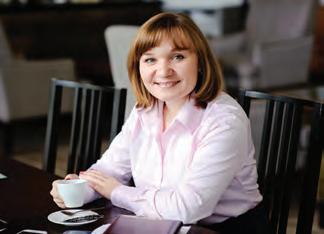

“They’ve never tried to influence me, because they wanted me to find my own way; but it happened! When I was seven, I decided I would become an economist.”
Anna (1975) is a Russian economist. Her mother and grandmother both are economists. Guschina is very keen to create professional courses in financial knowledge and skills. “I think it’s important to live by the concept of life for learning. You have to learn for your whole life because it’s very important in current society; it’s very important to upgrade your knowledge.” For Anna, a knowledge and understanding of finance is now critical in Russian society. “When the Soviet Union was destroyed, I remember how many changes we had in our country. People were lost because they didn’t know how to operate in the new economy.” For this reason, she is working as a business trainer for a company, Awara Eduhouse Training, where she designs training programs and courses and does corporate training and public seminars. Besides her new projects, there is a new company, a kind of startup managed with a friend, for business assistance in Russia. Often she starts her days with yoga. “I really love yoga. I think it helps me manage work stress.” Nowadays she is happy with her life. “I really love what I do, and my personal life and work are balanced.” For her future she sees herself “as a good wife and a good mum, but always as a working mother.”
54 Work Style — #12.13
[W awaraeduhouse.com]
Photos by Olga Guseva, Moscow, Russia

Work Style — #12.13 55
PEOPLE
Antonnione Franco Leone Ribeiro

“When I was a kid, I always wanted to create. I had everything I wanted, but nothing was more fun to me than a pen and a paper to write or draw things and a camera to take pictures."
Antonnione owns a studio in Belo Horizonte (Minas Gerais), the third most populous urban agglomeration in Brazil, where he creates graphic designs, environments, technologies for accessibility, and theater set designs. He doesn't like to describe his workplace as an office. He thinks studio is a better word. "A studio is where you study; you do experiments and develop things," he points out. In 2011, Leone Ribeiro took part in the Minas Raizes project, an art project of the Minas Gerais University. As a member of the audiovisual team, he provided advice to local craftsmen based on design methods. Among his hobbies are music and theater. "I was a member of an orchestra for ten years, but unfortunately I had to give it up," he tells us. Now he sings in a rock band whenever he has free time. "It's fun; during the day I have to wear serious clothes and at night I go to the concert and I become a rockstar." He uses music to relax. "The best part of my day is when I'm singing. When I sing, I express more. It's like a spontaneous creation. It's another character; it comes from my soul," he explains. At the age of twenty-nine, he has finished three different degree programs--graphic design, visual arts, and social communication--and a master’s degree in Design, Innovation, and Sustainability. But he would like to continue studying.

56 Work Style — #12.13
Photos by Paula Melo, Minas Gerais, Brazil
[W uemg.br]
to Watch

Work Style — #12.13 57
PEOPLE to Watch
Mshinwa Edith Banzi
"I like growing and eating my own food and fruits. I have planted different varieties of tropical fruits and want to keep my garden as ecological as I can."

Mshinwa has been the managing director of Illumination East Africa since 2010. “It is a social enterprise aimed at reducing poverty and making a profit while caring for people’s health and the environment. Being a woman adds value to your business. Most women in business have been able to bring a lot of change from the household level to the community and national levels. Women are hardworking; they take care of the family’s development and are committed to whatever they do." Banzi also runs a small lodge with her husband, Kilimanjaro Eco Lodge. It is an ecologically and socially responsible resort located at the foothills of Mount Meru, on the western outskirts of the city of Arusha, and near Mount Kilimanjaro. "The place is attractive for people who want to climb the mountains or go on safari, as it is very near the Arusha National Park,” she explains. Edith Banzi invests her free time in growing her own fruits in a small garden. "My dream is to become successful in my business, but what’s most important is to bring change to the lives of people around me. If I’m able to help young women and men become responsible citizens and hardworking adults, then I will consider myself a successful woman in Tanzania,” she concludes.
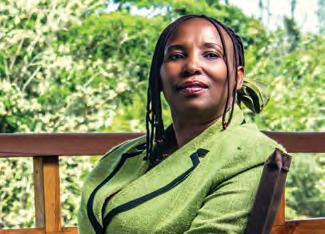
58 Work Style — #12.13
[W illuminationea.com kilimanjaro-ecolodge.com]
Photos by Gavin Gosbert, Dar Es Salaam, Tanzania

Work Style — #12.13 59
PEOPLE to Watch
Olivier Haski

“I opened my first restaurant when I was twenty-five. After that I opened several restaurants in Paris.”
Olivier (1972) is a French entrepreneur in Dubai. “The Dubai market only wants concepts that have been tried elsewhere. So we thought it best to open something like a franchise. After a quick study, we realized that the sushi industry provided a good opportunity there, so we decided to bring a franchise of SushiShop to Dubai.” Now he is one of the owners of the biggest SushiShops in the world and he is planning to open a second with his partner. “After two months, we realized it was going to be really profitable. My partner and I managed to get the franchise for the whole Middle East for the company, so we are going to open the second one at Dubai’s JBR beach, using the new open, outdoor concept. Life in Dubai is amazing. You can go to the beach every weekend; the weather is perfect; and the lifestyle is fantastic,” he says. Even so, he doesn’t see himself in Dubai ten years from now. “I don’t think I will be in Dubai then. I will probably stay here for five to ten years. I see myself maybe in Los Angeles. I’ve always wanted to live the American Dream. It’s like a childhood dream that I have.”

60 Work Style — #12.13
[W
]
Photos by Michel Sedaghat, Dubai, United Arab Emirates
mysushishop.ae

Work Style — #12.13 61
PEOPLE to Watch
Rebecca Chan


"I have to dedicate a lot of time to this activity because I'm the administrator, the accountant, the wedding planner. I play all the roles."
Rebecca is a wedding planner as well as a special events manager for a charity called Yonge Street Mission based in Toronto. From 9:00 A.M. to 5:00 P.M., she fundraises for people living in poverty. After 5 P.M., she becomes an angel for brides. "It was my mum who recommended that I start the wedding planning business," confesses Rebecca. "I have to dedicate a lot of time to this activity because I'm the administrator, the accountant, the wedding planner. I play all the roles," she says. Her other life is in the nonprofit sector. At Yonge Street Mission, she does fundraising, public relations, and marketing events. She loves working there because there is a great work environment and also because the job has taught her a lot. "My work with weddings is one thing; but on the charity side, I've had great opportunities that I wouldn’t have had otherwise, like hosting an event for Prince Charles." In her spare time she plays Ultimate frisbee as a way to relieve stress in her worklife. At present, she wouldn't change a thing in her life. "I'm pretty happy with where I am, and I know who I am today because of the experiences I’ve been blessed with. I’ve always lived by the motto “do what you love and the rest will follow.”
62 Work Style — #12.13
[W
ysm.ca]
Photos by Robert Rafton, Toronto, Canada
rebeccachan.ca

Work Style — #12.13 63
MOVIE for Work
The film is set in a dream company, Google. It’s like Wonka’s chocolate factory, but in Silicon Valley. It’s a world where the average age is thirty, and it is impossible to distinguish a manager from a trainee. Everyone seems happy. People ride on Google bicycles, eat free Google sandwiches, and chill out in relaxing Google spaces. This is a fantasy of thousands of guys with big black eyeglasses, who endeavor to become part of the company. Now is the perfect time for two cute, funny forty-year-old men to appear. Formerly successful agents for a watch company, they’ve lost their jobs and are looking for a new opportunity. They finally got an online interview with the great San Francisco company, which considers them "unsuitable" but decides to give them a chance anyway.
They end up in competition with dozens of other trainees, who know the terminology and computer systems well--unlike them. But both manage to come up with original solutions to solve problems, relying more on their own experience to build a winning team than on the ability to recognize a system bug.
The film is a real product placement, in which the American company is glorified as a heterogeneous system, full of value, where two eager forty-year-old men can work to become part of it, overcoming their limited knowledge with experience and talent to motivate colleagues to reach the goal. Will it happen?
01—03 Billy McMahon
(Vince Vaughn), Nick Campbell (Owen Wilson)


02 Billy McMahon (Vince Vaughn)
The Internship

Gen X vs Gen Y: Digital natives give a hard time to two former agents for a watch company who lost their jobs but are ready for the battle to get into Google.
Review by Carasoo There are two Generation Xers and a group of nerds. The first two lost their jobs because the traditional watch company they were working for went bankrupt. To add fuel to the fire, one of them has been left by his wife. The Google nerds live well and spend a lot of time organizing sports events. Meanwhile, Samsung is busy launching Galaxy Gear, a digital watch, while our two dinosaurs, former traditional watch sellers, try to put emotions center stage. I will have to see the film again, because I didn’t get it the first time!
Photos are courtesy of Twentieth Century Fox Film Corporation.
Characters Vince Vaughn (as Billy McMahon), Owen Wilson (as Nick Campbell), Rose Byrne (as Dana), Aasif Mandvi (as Mr. Chetty) and Max Minghella (as Graham Hawtrey).

Created by Vince Vaughn and Jared Stern. Directed by Shawn Levy. Produced by Vince Vaughn.
[W theinternshipmovie.com]
64 Work Style — #12.13
03
04
02 01
A Touch of Sin
Four characters, four lives follow each other sharing two common denominators: a job and a dire social situation, where poverty, ostentation, discrimination, and depression trigger the usual response.
By FRANCESCA TONEGUTTI
Dahai is a mineworker who rebels against the corrupt system of bosses to fight for the rights of people in his village. A lonely and abandoned man, forced to work apart from his family, he feels a growing anger inside and indifference toward others. A young receptionist in a local sauna is obliged to endure advances and violence from customers who think they can buy anything with money. A young boy looking for a reason to live goes from one discouraging job to another, from manufacturing companies to a brothel for wealthy businessmen.
Here is a real cross-section of contemporary China, which emphasizes the fast-paced, booming industrial development characterized by sprawling housing developments and new infrastructure alongside wooden huts.
The country handles the large demand for employment, but is also marked by a deep social malaise that provokes all the characters to react to their condition with marked violence against others and themselves.

The search for a fair and equal life is represented in a scene where a horse, who’s beaten bloody, is “freed” by his torturer and runs away with the cart; or where the receptionist, though accused of murder, is able to build a new life just where the story began.
01 Lanshan Luo (Xiao Hui)
02 Yu Lik - Wai is a cinematographer in the film's production crew.


03 Wu Jiang (Dahai)

04 The movie poster
Review by Carasoo This is not a happy movie. Some are dead, others murdered and there are suicides. Today, in China, many are rethinking society. But beyond the darkness, the film portrays the human search for beauty; amidst the deaths and dying there is an emphasis on style and elegance.
Characters Wu Jiang (as Dahai), Tao Zhao (as Xiao Yu), Baoqian Wang (as Zhou San) and Lanshan Luo (as Xiao Hui). Created by Zhangke Jia and directed by Zhangke Jia. Produced by Yu Lik-Way.
[W atouchofsin.com]

Work Style — #12.13 65 04
03 02 01
Rewiews
BOOKS for Work
Al Gini, Ronald M. Green
Ten Virtues of Outstanding Leaders: Leadership and Character [Wiley-Blackwell, 232 pp, £14.99]
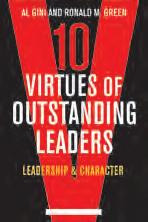
The most common good leadership qualities are honesty, diligence, fairness to name just a few. But this is not always so straightforward. Al Gini and Ronald M. Green claim that the ability to lead is based first and foremost on an individual's character, their ethical principles, and their desire to be of service to others. Despite what other books may tell us, great leadership does not follow a set of rules or theories.

Exciting New Releases
Find 40 interesting new releases and six unique interviews for fresh ideas on HR and business trends.
12 disciplines of leadership excellence: how leaders achieve sustainable high performance [McGraw-Hill Professional, 240 pp, $24.00]. This book talks about how to master the 12 disciplines of powerful leadership and lead the organizations to greatness. The authors assert that great leaders are made, not born. Everyone has the ability to shape himself or herself into the kind of person who enables and uplifts others to reach their highest potential. This text reveals exactly how to achieve it.

Henry Cloud
Boundaries for leaders: Results, relationships and being ridiculously in charge. [Harper Business, 272pp, $28.99]. With this book Dr. Henry Cloud leverages his expertise of human behavior, neuroscience, and business leadership to explain how the best leaders set boundaries within their organizations to improve performance and increase employee and customer satisfaction. Dr. Cloud provides practical advice on how to manage teams, coach direct reports, and instill an organization with strong values and culture.

Barbara Trautlein
Change Intelligence: Use the Power of CQ to Lead Change That Sticks

[Greenleaf Book Group Press, 250 pp, $24,95]. A research-based guide to managing organizational change. Barbara Trautlein (who has helped leaders and organizations create change that sticks for more than 25 years) walks readers through evaluating their leadership style and offers practical ways to implement successful and sustainable change.

Phil Buckley
Change with Confidence: Answers to the 50 Biggest Questions that Keep Change Leaders Up at Night

[Jossey-Bass, an imprint of Wiley, 251pp, £29.95]
This book addresses the 50 biggest questions that change leaders ask time and again, and provides the context, examples, and advice to answer them well, and to enable successful, sustainable change. Author Phil Buckley offers practical, experience-based advice for the difficult and stressful challenge.
twsm What is the meaning of the book’s title?
pb The book’s title reflects the weighty challenges leaders face when implementing big change in their organization. In working with leaders over twenty years, I' ve discovered that their skills and experience don’t necessary serve them well in managing large change and disruptions, such as buying or reorganizing a company or securing cash. I found that leaders often panic when faced with the kinds of change that are new to them. And when they panic, they tend to lose a lot of sleep and make poor decisions. So my book shares my experiences and those of other leaders.
twsm What is the first advice you would give to a change leader?
pb I would advise the leader to take stock of available skills and capacity to support the change and to determine where further support is needed. He must review past experiences and successful changes and analyze what made them successful, including his own role in the success. He should also check in with peers within his company as well as across the broader industry and its network to leverage the skills available there. And finally, he must articulate the benefits of the change alongside a vision of and blueprint for the organization’s future. A leader must show his employees how the change, based upon a strong foundation, will benefit them as well as the organization in ways that will provide a better experience than they now enjoy.
twsm What are the essential skills and abilities needed to make a great leader?
pb Great leaders have a destination in mind, and their role is to lead their teams forward. They have to develop an empathy for where the organization is now, and where the gaps are that must be closed. They must see where the organization is strong and where it needs improvement. A vision from the executive level is important, but leaders must also climb down into the gaps, so to speak, to understand them. The ability to then move the organization into change is essential, as is seeing the specific change in the context of an envisioned and articulated future success. Determining how to position the organization in the markerplace, understanding its comparative advantage and supporting its competitive agenda are all key. Finally, leaders must be excellent leaders of people. •
66 Work Style — #12.13
Brian Tracy and Peter Chee
Susan S. Raines
Conflict Management for Managers: Resolving Workplace, Client, and Policy Disputes [Wiley, Jossey-Bass, 496pp, £47.50] . The text is divided into four sections and provides opportunities for interaction and skill practice. Susan S. Raines shows an overview of the ways in which conflict management techniques and concepts can and should be applied to improve management and performance. Also the book deals specifically with internal and external business disputes as well as addresses disputes between regulators and the regulated.

Mitch Joel
CTRL ALT DELETE: Reboot Your Business. Reboot Your Life. Your Future Depends on It [Business Plus, 288 pp, $28.00] . Today's Internet economy is always changing, and because of that we have to be up to date and try to adapt our business to every single alteration. In order to keep up, marketing specialist Mitch Joel desperately urges all businesses and individuals to reboot their everyday assumptions on how to compete in the new landscape. Joel shares his insights on how to take advantage of changes happening now and how to act on them immediately.

In Chip Heath and Dan Heath
Decisive: How to make better choices in life and work [Crown Business, 336pp, $26.00] . This book exposes what’s wrong with how decisions are made by our political and business leaders, and by us individually in our personal lives. The Heath brothers uncover the latest psychological research to show why our brains are wired to make foolish decisions and how we can overcome our cognitive biases by using techniques mastered by decision makers of all stripes including judges, politicians, designers, military and business leaders and branding experts.

twsm For whom was this book written?

km I think it’s for anyone in business who wants to improve customer experience and is looking for a way to differentiate his business from its competitors. This is usually the main concern of the small business owner who may not have a big marketing or advertising budget, but knows he can improve every customer’s experience day by day.
twsm Do you think we are losing face-toface communication?
Kelly McDonald Crafting the Customer Experience
For People Not Like You: How to Delight and Engage the Customers Your Competitors Don't Understand. [Wiley, 197 pp, £16.99]

This is a practical guidebook that shows readers how to break the onesize-fits-all habit. Kelly McDonald explains why a customized approach to customer experience works best for growing business, generating loyalty, and creating "brand ambassadors."

Albert J. Bernstein
Emotional vampires at work: Dealing with Bosses and Coworkers Who Drain You Dry [Mc Graw Hill Education, 256 pp, $ 22.00] . Clinical psychologist Albert Bernstein points out how to identify and categorize the Vampires at work. To protect themselves from emotional vampires at work, people must recognize the various types of vampires, step into their world by understanding their stereotypical patterns of thought, and then step out of the pattern by doing the unexpected. This is one of Bernstein’s key techniques for rendering vampires confused and powerless to harm you.

km There is no question that people are doing more business online. I don’t believe it’s going to change, but the customer experience is still relevant, including the face-to-face part that all of us deal with. If you have an online business, the navigation of your website must provide a good experience. It is important to remember that digital communication is now just as important as face-to-face communication.
twsm Is customer service very important in a company? Why?
km I think it is very important because, with technology, many businesses have products of a similar quality, substance, or price as other companies. So it’s very difficult to differentiate yourself. One way businesses are distinguishing themselves from competitors is by carefully shaping the customer experience. This is more important than ever since it’s the one area completely within the control of the company.
twsm What advice would you give to deliver a better experience to every customer?
km There are two related pieces of advice: identify the high-potential customer you are not reaching but could; identify the needs of this customer and a way to satisfy them.•
Work Style — #12.13 67
Illustrations by Hanna Melin, London, UK
BOOKS for work
Riva Froymovich
End of the good life. How the financial crisis threatens a lost generation and what we can do about it

[Harper Perennial, 228 pp, $14.99]
Since the financial crisis is of concern for people everywhere, Riva Froymovich has conducted in-depth research and interviews around the world. This book chronicles the impact of the financial crisis on Generation Y and promotes innovative reforms to build a better future.
Harry M. Jansen Kraemer Jr.
From Values to Action: The Four Principles of Values-Based Leadership [Jossey-Bass, 224 pages, £18.99]
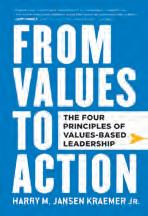
Kraemer demonstrates that the journey to becoming a values-based leader begins with self-reflection, which is the first of four fundamental principles that guide leaders to make choices that are aligned with their values. As his explains in his new book, because of today’s economic and political environment, the global economy becomes even more competitive and values-based leaders are needed more than ever.
Adam M. Grant, Ph.D
Give and Take: A Revolutionary Approach to Success. [Viking, 305 pp, $27.95]. Adam Grant reveals how the way we choose to interact with other people defines our success or failure. Grant shows how helping others move beyond zero-sum logic to create opportunities for for everyone is important and why this kind of success has the power to transform not just individuals and groups, but entire organizations and communities. This text presents an approach to work, team building, productivity, and profitability that is nothing short of revolutionary.

twsm Why did you decide to write Intelligent Leadership?


jm After years of working with leaders and future leaders, it was pretty clear to me that there was not a real road map for leaders to achieve a better understanding of strength and development needs. Over a hundred thousand copies or a hundred thousand books I have seen about leadership and everywhere I couldn’t find a road map. Still this is the phrase I prefer, since it is indeed a map that will help leaders, present and future, formulate a plan to become even better leaders.
twsm What are the essential skills a great leader must possess?
Marilyn Tam
The Happiness Choice: The Five Decisions That Will Take You From Where You Are to Where You Want to Be [Wiley, 188 pp, £16.99] . The book is filled with stories, tips, and insights on how anyone can live the life they've dreamed of living. It includes personal experiences and advice from experts in the fields of business success, relationships, health and fitness, spiritual and community relations, integrated into relevant chapters to strengthen and broaden the perspective and tools available for readers.

John Mattone
Intelligent
Leadership: What You Need to Know to Unlock Your Full Potential
[AMACOM, 256 pp, $27.95]
One of today’s most respected experts on identifying and developing high-potential leaders, John Mattone defines great leaders by the strength of their strategic and tactical capabilities as well as their character.
jm To become a great leader you must develop nine skill areas. These include, critical thinking, strategic thinking, emotional leadership, change leadership, and a drive for results. What I describe in the book and tell future executives in coaching sessions is that employees form their judgment about you and your skill level as a leader by carefully observing how you exhibit expertise in the nine skill areas. Since your expertise, or lack of it, is on display, you must work constantly to build these competencies.
twsm Describe the highly successful leader
jm I have discovered that great leaders begin with a strong inner core consisting of a solid character, a robust value system, and a quiet self-confidence. It is clear that they and their team can work through any challenge. The inner core, of course, is connected to those nine critical skill areas, which compose a second core. And that’s rare. There are certainly many good leaders. But if you examine the worlds of education, politics, organizations (both public and private), and governments across the world, you will find very few extraordinary leaders. This simply proves that excellence in leadership is a never-ending pursuit. You have got to be committed to be your best every day.
twsm For whom was this book written?
jm This book is written for two groups. First, I’ve addressed the managerial class of any organization, including managers, subadvisers, and senior labor executives. No matter where you work, if you play a leadership role, this book is for you. Second, it was also written for the younger generation who have great potential for leadership but lack a guide.•
68 Work Style — #12.13
Nigel Nicholson
The I of Leadership: Strategies for Seeing, Being and Doing.

[Jossey-Bass , 322 pages, £18.99]
Professor Nicholson is a leading authority on leadership and organizational dynamics. With this book he shows the importance of understanding the risks of a self-centered perspective for today’s leaders. The text, which ranges across the whole of human history, explores the lives and choices of leaders and shows how the capacity of leaders to see what others do not see frames their actions and allows them to transform, build, destroy or stabilize.
Michael Abrashoff
It’s your ship: management techniques from the best Damn ship in the navy [Grand Central Publishing, 240 pp, $27.00]

The author offers a tale of top-down change for anyone trying to navigate today's uncertain business seas. When Captain Abrashoff took over as commander of USS Benhold, he thought it was like a business that had all the latest technology but only some of the productivity. With this book he helps people change the course of their ship, no matter where their business battles are fought.
Orrin Woodward and Oliver DeMille
Leadershift: A Call for Americans to Finally Stand Up and Lead [Business Plus, 208 pp, $25.99]
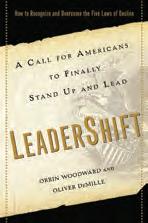
This text tells the story of how David Mersher, the successful CEO of IndyTech, sets out to discover why the United States is losing its leadership edge and what he can do to turn things around and make America truly great again. Mersher and his colleagues discover something few business leaders or citizens of free nations have yet to realize: Our world today is on the verge of a momentous LeaderShift.
twsm Do you think that manner of speech is an important skill for a worker?

Paolo Guenzi and Dino Ruta
Leading Teams. Tools and Techniques for Successful Team Leadership from the Sports World.
[Jossey-Bass, an imprint of Wiley, 340pp, £24.99]
Based on the authors' work with top sports coaches and corporate executive programmers at the Bocconi Business School, this book offers an original and alternative way of explaining the model of team leadership, using the methods and practices taken from the world of sport.
 R. Stoker
R. Stoker
OVERCOMING FAKE TALK: How to Hold REAL Conversations that Create Respect, Build Relationships, and Get Results

[McGraw-Hill Professional, 276pp, $20.00]
This is a practical guidebook to turn any sensitive, emotional, or confrontational workplace conversation into a positive exchange that provides benefits for both sides. The text offers serious exercises to prompt you into thinking about what you really want.
js Yes, absolutely. If a leader can’t communicate clearly, he will never get the desired results. Recently I was at a meeting where an issue arose that became a problem. Some said to others, “Why did you bring this up?” When I asked why they had raised an issue that was difficult for certain individuals, they gave such explanations as: well, I didn’t know that it would hurt their feelings; I just don’t like conflicts, so it was easier to do it myself. I think these answers were really excuses for not holding conversations. So part of my challenge is to help people look at their way of thinking, so that they can understand that the way they think about things drives their behavior.
twsm What advice would you give to a manager who wants to improve his conversation?
js If you want to build a house you need three things: the blueprint, the tools, and the materials. In conversations, the tools are the skills that managers need to have the conversation. The blueprint is the process for using those tools. And the materials are obviously the content or the subject of the conversation. I think that everybody has the subject, but some struggle because they don’t know what skills they should use and don’t have a process for using them. So they try as best they can, but it doesn’t work or they have a bad experience.
twsm What do you think is the most common mistake people make in conversation?
js We are so preoccupied with what we think or want that we really don’t listen very well. In my book, I divided listening as a skill into two elements: hearing as an auditory function; and attending, which is about presence. I don’t think we do a good job with that. We may hear what people are saying--that’s the auditory part--but we don’t attend.
twsm Whom is this book addressed to?
js The principles in the book are universal. I think there are ten personal examples and over forty business examples. •
Work Style — #12.13 69
John
BOOKS for work
MEAN GIRLS AT WORK: How to Stay Professional When Things Get Personal [Mc Graw Hill Professional, 256 pp, $24.00] .

This text offers 70 distinct scenarios ranging from a colleague excluding you from a meeting to coworkers spreading lies about you. Each scenario describes a behavior, how the recipient of this conduct might feel, what she’ll be tempted to do in reaction, and what she needs to do to stay professional and manage the situation.
Chris Johnson
On Target Living: Your Guide to a Life of Balance, Energy, and Vitality. [Wiley, 320 pp, £14.99]. Drawing from his success with training thousands of companies and individuals to live a life of balance, Chris Johnson reveals that decreasing company spending while enhancing employee productivity can be as easy as taking simple steps to get adequate rest, exercise and nutrition to reach one’s greatest potential. The solutions presented will improve employee performance, change company culture and lower health care costs.

Gary Keller and Jay Papasan
The one thing: the surprisingly simple truth behind extraordinary results [Bard Press TX, 240 pp, $24.95] The authors explain the success habit to overcome the six lies that block our success, beat the seven thieves that steal time, and leverage the laws of purpose, priority, and productivity. This text teaches how to want more productivity at work and how to reach a better lifestyle. The ONE Thing delivers extraordinary results in every area of your life—work, personal, family, and spiritual.

Michael S. Deimler, Richard Lesser, David Rhodes, Janmejaya Sinha
Own the Future: 50 Ways to Win from The Boston Consulting Group [Wiley, 384 pp, £23.99]

The book is part of BCG’s Game Changing Program—a year-long endeavor engaging leaders on how to navigate shifts in business and the global economy. At the book’s core is a manifesto for radical transformation that has been BCG’s underlying mission since its founding 50 years ago.
twsm For whom was this book written?
dc “Reinventing You” is intended for two types of readers. The first is career changers, people who would like to move to a new job or field and want to find a strategic way to do that, to really make the best case possible for themselves. The second type of reader is someone who would like to stay at his current job or company but feels that his talents are being insufficiently recognized. "Reinventing You" provides a roadmap to help them ensure that other people recognize and understand the contribution that they can make.
twsm How can a worker achieve something different and better in his professional life?

dc There are three steps involved in Reinventing You. The first is recognizing how your career is viewed by others, knowing your reputation. The second is thinking carefully about what you would like your reputation or your personal brand to be. How would you like others to think of you; what would you like to be known for. And the third piece is manifesting that brand in your day-to-day life. Whether in leadership positions that you take on or in your activity on social media, how do you ensure that when others think of you they have the image in mind that you would want?
Dorie Clark
Reinventing You: Define Your Brand, Imagine Your Future. [Harvard Business Review Press, 240 pp, $25.00]

Dorie Clark wants to help workers at all stages of their careers, workers who want something different and better in their professional lives. Clark argues that it’s no longer possible to sit back and count on getting noticed for your hard work alone. She mixes personal stories with engaging interviews and examples from well-known personalities.
twsm Why did you decide to write a book to help people in their jobs?
dc I actually have changed jobs many times myself. I didn’t realize it at the time, but this was the beginning of the decline of the newspaper industry in the US, and it was very hard to find another position. I had to think creatively about what I could do moving forward, and so over the ensuing decade I took on radio jobs and other jobs as well. I was a presidential campaign spokesperson, a non-profit executive director, and a filmmaker. Through those experiences I came to realize that you could be strategic about how you shape your career, and that more and more people were having to do it. So I realized there was a need for a book like this. twsm What is the meaning of the book’s title?
dc The book is called “Reinventing You” because I believe that in this economy more and more people will need to reinvent themselves professionally, either by choice because there are different jobs and careers they’d like to try, or by because companies and industries are changing so fast. It’s critical that we modernize our skills to keep up and stay competitive. •
70 Work Style — #12.13
Katherine Crowley and Kathi Elste
Own the Room: Discover Your Signature

Voice to Master Your Leadership Presence
[Harvard Business Review Press, 240 pp, $25.00].
Leadership presence is the ability to consistently and clearly articulate your value proposition while influencing and connecting with others. The aim of this book is to help people to develop their leadership presence with a simple and compelling framework, as well as to offer practical advice about how people can develop their own personal presence.
Susan Cain
Quiet: the power of introverts in a World that can’t stop talking. [Broadway Paperbacks, an imprint of Crown Publishing Group, 352pp, $16.00]. Susan Cain charts the rise of the Extrovert Ideal in the twentieth century and explores its far-reaching effects. She talks to Asian-American students who feel alienated from the brash, backslapping atmosphere of American schools. Cain draws on cutting-edge research in psychology and neuroscience to reveal the surprising differences between extroverts and introverts.

Lee J. Colan and Julie Davis-Colan
Stick with it: Master the art of adherence [Mc Graw Hill Education, 176pp, £16.99].


This book discusses building competence and igniting passion in order to achieve business success. Initially, you may not see tangible results, but rest assured, growth is occurring under the surface. The authors combine real-world stories with cut-throughthe-clutter tools so you can convert this rapid-read book into fast results.
Chatham Sullivan
The clarity principle: how great leaders make the most important decision business
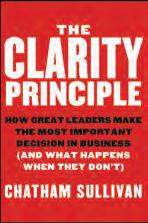
[Jossey-Bass, 240 pp, £18.99]
This book argues that when the purpose of a business becomes confused, it is the leaders' responsibility to restore clarity. Featuring compelling stories of leaders who have succumbed to and successfully resolved their organizations' identity crises, The Clarity
Principle bridges the gap between leadership and strategy and demonstrates the tremendous gains to be achieved by leaders willing to make tough choices.
twsm do you think some companies should change their way of thinking?
ew Yes, I do. Companies talk about innovation and creativity, but historically what I’ve found is just a lot of talk. Innovation involves risk, doing things that haven’t been done before. And for companies that are bound by bottom lines, shareholder value, and based on performance, it’s more comfortable to do what they’ve done before, especially if it’s been successful.
twsm what tools facilitate creative action?
ew First, try to recapture the innocence of childhood. As children, we have that incredible ability to imagine endless possibilities, endless solutions. Then at school we are taught to answer questions the same way, to sit still and observe rules, to color within the lines. As adults assuming responsibility,,we become more risk-averse-- almost to the point of being put to sleep as if locked into a system. To unlock, to unleash our creativity, we need to rethink; we need to return to those childhood roots of boundless imagination and to explore new ideas and concepts from that perspective.
twsm how can somebody find his creative potential?
UNthink: rediscover your creative genius [Crown Business, 224 pp, $ 23.00]
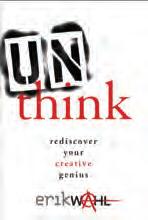
This is a book that will lead every reader to realize that we are capable of so much more than we think. It offers a new approach and describes tools to facilitate the creative process. UNthink is a clarion call to radically change the way you think and live.
ew The individual must unearth and explore what he is passionate about and then let go, have faith in the process. Another metaphor would be "pushing the boat further away from the dock." We have been trained to keep boats tied to the dock so they don't drift away. But I'm encouraging people to untie the boat and push it out to see and discover what true majesty the ocean has to offer.
twsm for whom was this book written?
ew It was intended as a business book for entrepreneurs and for organizations, but I intentionally wrote from a broader perspective so that executives buying the book or using it at a corporate meeting, where I might be speaking, would take it home to their children, families, and communities. I hoped it would go viral. It’s not simply about leadership or customer service; it's not about one element of business.•
Work Style — #12.13 71
Erik Wahl
Amy Jen Su and Muriel Maignan Wilkins
BOOKS for work
Marina Gorbis
The nature of the future: Dispatches from the Socialstructed World.

[Simon & Schuster, 256 pp, $26.00]
Gorbis explains how individuals are filling gaps and solving intractable problems by reinventing business, education, medicine, banking, government, and scientific research. She argues that this social economy is emerging because new technologies now offer so many capabilities to individuals that it has become possible to invent radical new types of organizations and services, accomplishing things previously only large institutions could.
Michael Benklifa
Think Like an Option Trader: How to Profit by Moving from Stocks to Options. [FT Press, 208pp, $35.99]

Michael Benklifa, drawing on his experience trading millions of dollars in options every month, reveals this market’s radically different dynamics and shows exactly how to take full advantage of them. With practical and simple examples, this text will help you understand how to build trades that earn profits and control risk.
Daniel H. Pink
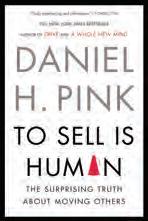
To sell is human: the surprising truth about moving others.
[Riverhead, 272pp, 26.95]
Every day more and more people earn their keep by persuading someone else to make a purchase. To Sell Is Human offers a fresh look at the art and science of selling. This book is a perceptive and practical book–one that will change how you see the world and transform what you do at work, at school, and at home.
Robert Steven Kaplan
What you’re really meant to do: a road map for reaching your unique potential [Harvard Business Review Press, 219pp, $25.00]

Drawing on his years of leadership’s experience, Kaplan proposes an integrated plan for identifying and achieving goals. This book discuses the critical issues people need to address in order to reimagine their future and achieve their dreams. The text outlines specific steps and exercises to help people understand themselves more deeply, take control of their career, and build their capabilities in a way that fits their passions and aspirations.
What Got You Here Won't Get You
There: How Successful People Become Even More Successful [Hyperion, 256 pp, $24,95]
The corporate world is filled with executives who have worked hard for years to reach the upper levels of management, but not all of them will reach success. As executive coach Marshall Goldsmith shows in this book, subtle nuances make all the difference. The author gives advice to change small transactional flaws.

Leonard S. Greenberger
What to Say When Things Get
Tough: Business Communication Strategies for Winning People Over When They're Angry, Worried and Suspicious of Everything You Say. [MC Graw Hill Professional, 256pp, £13.99] . Leonard S. Greenberger, a partner at one of today's most successful public relations firms, offers verbal and nonverbal skills for handling communication crises in any public forum. The text provides communications strategies, skills and techniques that all business professionals can use to win people over when they’re angry, worried and suspicious.

[DMG Books, 262 pp, Rp 75.000]
White Ocean Strategy is a new way to drive any type or size of business, from the smallest family shop to the biggest multinational. This strategy places the emphasis on every aspect of society in harmony with the surrounding business, social and natural environment. With the courage to declare the truth against mainstream economic principles, this book has ignited significant change in Thai society.

Corey Sommers
Whiteboard Selling: Empowering Sales Through Visuals.
[Willey 244 pp, £19.99]
The author draws on his experiences of designing more than 500 whiteboards and training more than 50,000 sales people worldwide for the creation of Whiteboard selling. With the aim to offer practical guidance for salespeople and marketers, Sommers and Jenkins employ this book to provide explanations, exercises and other activities to teach people how to create a whiteboard discussion framework.

72 Work Style — #12.13
Marshall Goldsmith and Mark Reiter
Danai Chanchaochai
White Ocean Strategy. A powerful paradigm.
All the President's Men
Catch--22 02 Vibram 5-Finger Running Shoes 03

Whichever one that gets me through security quickly, ... The Duchamp in California's Sonoma Valley
Back to the Future It'is greatest movie of all time
Shantaram Motorbikes
Emirates
Shonga Game Lodge in Kruger
Constantia Uitsig Restaurant, Cape Town
Macbook Pro (bought for my wife) or her engagement ring
Vernazza in Cinque Terre
Butch Cassidy and The Sundance Kid
How they blew it –written by the owner of Antal Blackberry Continental airlines
The Killing Fields 01

The Quiet American by Graham Greene


Plasir De Merle Cabernet Sauvignon, Franschoek 04

Parador de Sigüenza
Lur Maitea, it is also a place of memories A trip to my parents Doing nothing at the beach with my kids El Coto
My red orchid El Al The Grand Hotel, Warsaw 05
Les Associes, Crouch End, North London
One of my wife's pictures
My 5-week holiday in India when I was young and carefree
Bordeaux from the Medoc region 06

Work Style — #12.13 73
Movie Book Object Airline Hotel Dinner Gift*
Wine
James
Nick 01 05 06 04 03
Craft A whole weekend I like snow Turley Zinfadel
Vacation
Alex
Leticia
*
significant
02 OUR CHOICE for Work
Alex Barnett — Comedian, writer and social commentator, James Cussen — Director, ICE Art, Leticia de la Herrán — Managing Director, Antal International Spain, Nick Kochan — Writer, Consultant and Speaker.
for one’s spouse or
other
To three friends…and their optimism. This is an out-of-section double page. It is dedicated, as usual, to sharing our joys and sorrows. Today is a day of joy.
The spark: FIRE
In December 2012, a fire destroyed the photographic studio and its contents of Francesco di Loreto, Paolo Mazzo, and Mimmo Visconti.

The evaluation: GIVING UP. In a single blaze, twenty years of professional experience acquired through sacrifice and dedication was wiped out. These three photographers had long been united in a single endeavor and by a single passion: to
express their unique vision in a form and industry known for its solidarity-- photography. So after many years of shared experience, professional and personal, and in the face of such a devastating loss, one might have expected a sense of defeat.
74 Work Style — #12.13
The decision: DON'T GIVE UP!
But no. With their studio still smoldering, these three indomitable spirits decided to build a set on a simple white table, in the midst of the ruins, photographing as many of the burned items as they could identify.

Result n°1
Wanting to transform negative energy into an opportunity for a new beginning, they used this artistic project born in the ashes to find a new studio and reclaim their passion: photographers they were and always will be.
Result n°2
The final chapter was 1st Place at the 8th Black and White Spider Awards in the Still Life category. Photographs beat fire.
[W thespiderawards.com/gala8th/ winners.php?x=p&cid=231]
F38F via Pietrasanta, 14 20141 Milan T +39 02 58313900
E f38f@f38f.it W f38f.it
Work Style — #12.13 75
FASHION for Work
Charming Neckties

Neckties have always been a symbol of sophistication. The most important personalities wore suits with ties as a sign of social status. Despite the fact that men are becoming increasingly casual in their manner of dress, we can be sure of something: the tie is an emblem that will never die.
USES
The cravat is the most personal piece of clothing in a male wardrobe. “A man chooses the tie he is going to wear because of his morning mood,” Stefano Bigi, co-owner of Bigi Cravatte tells us. It is an accessory characteristic of a man who values classic tradition while paying careful attention to the latest developments in fashion trends. But what criteria might be used by a manager when it’s time to choose the necktie? Gianni Cerutti, co-owner of Passaggio Cravatte claims that “there are no rules for a tie choice, or, better, there is only one rule: instinct. I always say that necktie choice is a true gesture of instinct. I like it or I don’t. The truth is, when you are opposite the mirror, and you don’t know what necktie you should wear, there are several factors you consider: humor, scale of vanity, weather, the importance of the day’s events.” The necktie is a piece of clothing you can always wear, whether you have a job meeting or you are going out with friends. As Giorgio Ricciardi, owner of Giorgio Napoli, says, “Necktie choice must be absolutely rigorous in form, color, design. But it’s obvious you can feel free to choose a holiday of colors or design when you are wearing it in your free time.”
PRODUCTION
There is not a standard length of time for making neckties. The average is around forty-five to sixty minutes, but every brand has its own manufacturing times. Stefano and Paola Bigi, co-owner of Bigi Cravatte, calculate an average time of thirty-five to forty minutes for each tie. “The entire process is about thirty-five to forty minutes, but it could change depending on the number of labels we want on the tie, or if hand-rolled edges are required. The cleverness—experience--of the needlewomen is also very important,” they tell us.
Different phases are required in necktie manufacturing, as Maria D’Ambrosio, owner of Nodi d’autore, explains. “Ours is a handmade product. The first stage is the cut of the weave, and the second is the cut of the lining. Then the inside is cut (soul) with a machine known in Italian as "rasofilo." Then follows the ironing with the insertion of the soul (lining). When the necktie is finished, it has to be bended and manually sewed with a single thread. In the last stage, the keeper loop and the label will be put in place.” Costs of production include three areas: fabric, design, and labor. “Production costs depend on composition and com-
Our choice
Work Style Selection
We researched producers and designers of ties until we had approximately 90 brands. Then our jury, including fashion experts, fashion bloggers, and fashion PR experts voted on the ties. The jury was composed of • Marta Scetta, Editor at the Work Style Magazine • Cristina Milani, Chairwoman, Gentletude Onlus • Maria Silvana Pavan, Independent Music Professional • Paolo Aicardi (Chairman), Commercial Director at Fondiaria-Sai and
Peter Conrad, Managing Director Head UHNW Segment Wealth Management
Palle Ellemann, Senior Consultant at GES
Sandro Lombardi, director of AITI for twenty-four years (1988-2009)
Jerzy Potocki, President of AIMS International Poland.
[W bigicravatte.it cravattificiodiana.it drakes-london.com edwinpireh.com giorgio-napoli.com markroscoedesign.com nodidautore.it passaggiocravatte. com quarantalocatelli.it]
76 Work Style — #12.13
01 MAURIZIO MARINELLA 02 GIORGIO NAPOLI 03 LESTER 04 PINEIDER 05 NODI D'AUTORE 06 AMADEO LOCATELLI OUR TOP 6
•
•
sports commentator at Telelombardia • Rosario Imperiali, founder Studio Legale Imperiali + Alliance Deloitte-Imperiali
• Emmanuel Maindron, independent journalist and freelance consultant
•
•
01
plexity. Jacquard woven silks are the most luxurious and expensive types of silks to use. This type of silk is considered heavy so as to provide a reliable body. The complexity of the design is another factor, as each color represents an individual yarn fed into the loom,” David Pireh, PR and CRM at Edwin Pireh tells us. In the majority of cases, fabric costs exceed labor costs. As Amedeo Quaranta, owner of Amedeo Quaranta Locatelli says, “In the making of a tie, various costs are involved, especially raw material costs (silk, wool, and cotton). These elements account for seventy percent of the total expense, and you have to add the labor costs (thirty percent).”
NUMBERS
Making a handmade necktie is a process that needs the participation of different professionals, beginning with the choice of fabric made by a designer, followed by the production, and ending with the finishing touches. This slow process will not result in a large number of final products. At Drake’s, for example, “we pro-





duce around 2,000 ties a week,” Jamie Ferguson tells us.
CHOOSING THE WEAVES
Often the company owners make the style choices. At Bigi Cravatte, for example, Paola and Stefano choose their own collections. “We count on our own experience; we research with just the help of our archives.” The situation is quite different for Passaggio Cravatte, where Marta Passaggio, co-owner and Gianni Cerruti choose only vintage silks. “We are always on the lookout for silks. We don't have a collection because vintage silks are endangered. We show what we find to our customers. Touching a silk from seventy years ago makes us feel so excited. To be used at Passaggio Cravatte, a silk has to thrill us,” Cerruti tells us. A different approach is used at Cravattificio Diana, as Silvana Bressan, E-sales Manager, explains. “The style is followed by our style office who provide inputs to our designers. When designs are ready, they are sent to production, where they are colored, and where “blankets” are made; immediate-
Thanks
We, at Work Style, want to thank all the brands that have taken part in the article:
• Quaranta Locatelli. Amedeo Quaranta. Italy. (Europe)
• Bigi Cravatte. Stefano e Paola Bigi. Italy. (Europe)
• Canali. Claudia Catalano. Italy. (Europe)
• Cravattificio Alba. Rocco Cazzato. Italy. (Europe)
• Cravattificio Diana. Silvana Bressan. Italy. (Europe)
• Drakes. Jamie Ferguson. United Kingdom. (Europe)
• Edwin Pireh. David Pireh. New South Wales. (Australia)
• E. Marinella. Maurizio Marinella. Italy. (Europe)
• Giorgio Napoli. Giogio Ricciardi. Italy. (Europe)
• Lester. Carlos Satrustegui. Spain. (Europe)
• Mark Roscoe Design. Mark Roscoe. Indiana. (USA)
• Nodi d’autore. Maria D’ambrosio. Italy. (Europe)
• Passaggio Cravatte. Gianni Cerutti e Marta Passaggio. Italy. (Europe)
• Pineider. Linda Zamboni. Italy. (Europe)
• Salvatore Ferragamo. Laura VereHodge. Italy. (Europe)
• Soloio. Davide Lonoce. Spain. (Europe)
• Tiesolution. Antonio Gea Sánchez. Germany. (Europe)
• Toptie. Giuseppe Consolo. Italy. (Europe)
Work Style — #12.13 77
02 05 06 03 04
Super-Luxury Artisan
Maurizio Marinella (photo): the Neapolitan king of handmade neckties



Marinella represents the pinnacle of necktie art. Since 1914, he has “continued doing ties in the old-fashioned way, where the materials are designed and patterned in England with a limited edition of the weaves.” This is an old-fashioned method at a time when everything is fast and technological.

Manufacturing time is also very slow. Each necktie requires an average of forty five minutes for cutting, stitching, and finishing touches. The designer of the company is also the owner. The laboratory is located two buildings beyond the shop in Naples. This is not hightech manufacturing or an industrial laboratory. “Maximum production is about 120 pieces per day,” though the marketplace “requires double that. But we make only the amount we can.” The esthetic quality of the production is the best, and the prices are unique. Those are parameters that “need specialized staff who look after every single detail.” It’s useless to look for the e-shop--it doesn't exist, since designs change continually. On Marinella’s website, it is easy to find the addresses for his shops located in certain world capitals. The choice of the tie is “always made by first impression and persists over time.” As Marinella says, “a customer may have hundreds of neckties, but he always wears the same four or five.”
ly afterward, the company picks the most suitable colors for the brand, which are sent to the final stage of production where samples and traces are made. These samples are shown in the boutique, and we then produce what we sell to customers.”
RELATIONS WITH CUSTOMERS
Since a cravat selection is very personal, there is a close relationship between customer and tie seller. “I personally know most of my clients, since each tie is custom-made,” Mark Roscoe, owner of Mark Roscoe Designs, emphasizes. The seller should know about customers in order to show them the weaves that will be most appreciated by them. At Edwin Pireh, for example, “a purchase is not just a purchase, it’s personal. Every item we make is handmade, which means every item we have is one of a kind. Therefore, we like to keep in constant contact with our clients to ensure they love their item as much as we do. With Edwin Pireh bespoke, Edwin actually visits the client (anywhere in the world) and over a period of time will work with them from concept to completion stage,” David Pireh concludes.•
History
Derived from the word “Croat,” the first “cravats” were worn by Croatian mercenaries during the Thirty Years' War (1618–1648).
French King Louis XIV took up the fashion of neckerchiefs after seeing them on victorious Croatian legionnaires. From that moment, the necktie has become an important sign of elegance in business life. But not all businessmen trust it.
They wear neckties …
• Bernard Arnault has been the chairman and CEO of LVMH Moët Hennessy • Louis Vuitton S.A. since 1989.
• Bill H. Gates is chairman of Microsoft Corporation, the worldwide leader in software, services, and solutions.
• Carlos Slim is the chairman and chief executive of telecommunications companies Telmex and América Móvil.
• Henry Ford created the Ford Model T car in 1908 and went on to develop the assembly line model of production.
• Li Ka-shing is the Chairman of the Board of Hutchison Whampoa Limited (HWL) and Cheung Kong Holdings as of 2008.
• Volkmar Denner is Chairman of the Board of Management of Robert Bosch.
They don’t wear neckties …
• Amancio Ortega has been founding partner of Inditex (whose main company is Zara) since 1963.
• Phil Knight is Chairman of the Board of Nike and has been a director since 1968.
• Ingvar Feodor Kamprad is the founder of IKEA.
• Jeffrey Preston "Jeff" Bezos is the founder and CEO of Amazon. com.
• Sergio Marchionne is the CEO of Fiat S.p.A., Chairman and CEO of Chrysler Group LLC, and Chairman of Fiat Industrial S.p.A.
78 Work Style — #12.13
A woman wearing a tie is very chic






Paolo Aicardi has an extensive management background at the Italian company Fondiaria-Sai and is a well-known sports commentator at Telelombardia. He is a staunch defender of ties. “For me the tie is an essential piece of clothing in a man’s wardrobe. I couldn’t imagine there being no neckties.” Aicardi has more than six hundred of them. “I always wear a necktie, except when I am on the beach--although I don’t dismiss the possibility that someday I will wear it there too!” His favorite shops are Marinella in Naples and Finollo in Genoa, and he has his own criteria for tie choice. “When I need to buy a necktie, I consider the occasion for which I’ll wear it and whether it will complement my suit and serve my personal style,” he says.

2 5
3 6
Work Style — #12.13 79
Annie Hall (in which Annie wears a tie) is a 1977 Woody Allen movie.
The production phases of a handmade necktie:1 The paper pattern with measurements requested by the client is laid on the vintage silk
2 The silk is cut 3 Checking the perfection of the design and the cut4 The three silk pieces that make the tie are put together 5 Silk is wrapped around the core of the tie 6 The silk is fully wrapped around the core of the tie and is secured with pins.
1 4 [W finollo.it marinellanapoli.it mediapason.it]
80 Work Style — #12.13
banking reloaded www.syzgroup.com Banque SYZ & CO SA Via Cattori 4 | CH – 6601 Locarno | Tel. 058 799 66 66 Ginevra | Zurigo | Lugano | Locarno | Londra | Lussemburgo Milano | Roma | Madrid | Bilbao | Vienna | Nassau | Hong Kong
Private
HR EVENTS for Work
Creative Talks
We concluded the series of Creative Talks for this year on October 28 at Beste SpA. We met many professionals and workers whose ideas and opinions led to the conclusion that maybe scientific principles are truly applicable to a company's organization.
THE FORMAT
PRESENTATION
Creative talks are a series of events to share ideas about the application of scientific principles to the business reality.
OBJECTIVES
1) identify similarities among those processes analyzed by physics and other disciplines (such as biology and chemistry) and the working world; 2) use instruments, solutions and scientific models in order to better understand business phenomena.
MODERATORS
Massimo Temporelli, a physicist, active in the communication field, whose interest in the relationships among society, science, and technology draws on his former experience and current insights.
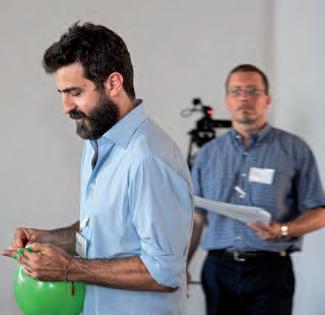
Stefano Guandalini is a civil engineer, lent to Creative Talks. His main activity is managing a planning team at ITECSA, a Swiss company, which plans and manages major public works all over Europe. •
CREATIVE TALKS ARE AN EFFECTIVE METHOD TO OPEN YOUR MIND TO CREATIVE THINKING
Work Style Creative Talks offer efficient and persuasive suggestions on how to solve business problems.
Using best practices, you can be part of a global community of people interested in the changes occuring in the working world.
Through Creative Talks you can make friends and strong contacts because of the careful management of the Talks, which encourages everyone's participation. Through the many open events, Creative Talks turns perspectives around by creating a unique environment. It is usually difficult to attract qualified speakers to business events (they are always the same, too boring and too many). Creative Talks are the smart, engaging and definitely below-standard price benchmark of business events alternative.
Creative Talks are carried out in the local language of the country in which the event is hosted.
THEMES 2013
• The company: open or closed system? How can the environment influence our business trends.
• Measurement of disorder. Entropy: from thermodynamic systems to chaos.
• Darwinism and Business organization How much to differentiate survival or extinction.
• Relationship between machine and behavior. From Charlie Chaplin to the postindustrial man.
REFERENCES
The strength of Creative Talks lies in the presence of concrete contents that are
Thanks to all those who took part in our initiative and enlivened our Talks, and to all the companies who hosted and supported us in this endeavor.
1 BESTE (Ponte di Colle Cantagallo, Italy) [W beste.it]
2 FAULHABER MINIMOTOR (Croglio, Switzerland) [W faulhaber.com]
3 F38F (Milan, Italy) [W f38f.it]
4 PINI SWISS ENGINEERS (Lugano, Switzerland) [W piniswiss.com]
5 REGAZZI (Gordola, Switzerland) [W regazzi.ch]
6 SANDRO VANINI (Rivera, Switzerland) [W sandrovanini.ch]
7 TETRAPAK (Modena, Italy) [W tetrapak.com]
8 THUN (Bolzano, Italy) [W thun.it]
2014 is coming up and so is the new series of Creative Talks!
For information about these events, visit our webpage workstyletalks.com or write to: welcome@theworkstylemagazine.com. Get in touch!
useful to companies and people who work, and of stage contents. The metaphor of science is used to let the audience think about the significant topics of work as scenic. It is a clever scenic design aimed at the target audience who is able to catch the meaning of the experiments and transform them into ideas for debate. Contents are developed each time by the audience with the aid of moderators and start from a scientific experiment. The didactic agenda of each meeting is a mix of performance and concreteness.•
Work Style — #12.13 81
[W workstyletalks.com]
01
01 Massimo Temporelli and Stefano Guandalini
The Company: Open or Closed System?
THE COMPANY AS A SYSTEM
The concept of company as a system has been accepted for some time. Human existence is characterized by the continual presence of subjective states of necessity or dissatisfaction called needs. The needs determine the desire to obtain goods and services which could eliminate, mitigate or prevent a state of discomfort. The products and services can only be obtained through a production process. Consumption is the appropriate act to meet the need.
PRODUCTION AND CONSUMPTION
Production and consumption are two phases of economic activity. The fundamental characteristics of modern companies are:
• The stable organization (every company is established to last for a long time);

• The resources (people and goods).
COMPANY SYSTEM

The assumption from which this Creative Talk develops is based on the observation of the company as if it were a system with relations between elements and various types of aggregates. The reports are based on conditional variables and/or constants, reports and changes.

DIFFERENCE BETWEEN SET AND SYSTEM!
Definition of Set: group of elements that do not interact or whose relationships are weak. Definition of System: group of elements that interact.
THE EXPERIMENTS
If we accept that a business is a system made of a set of elements (to simplify: the various directions it may take) that dialogues with given external variables (the market) and unexpected ones (changes such as a recession), the set theory teaches us how an open organization accustomed to constant change is more solid within a medium-term perspective than a closed organization that is vulnerable to internal and external critical factors.
•
82 Work Style — #12.13
How can the environment influence our business trends?
Alberto Riganti, Francesco Rossi and Alessandro Foletti
Pini Swiss Enrgineers (Switzerland), at AlpTransit, Sigirino. Alp Transit San Gottardo SA is the client commissioning the new alpine railway on the route of San Gottardo, a level ground railway crossing the Alps. Pini Swiss Engineers is one of the main planning companies.
F38F (Italy) is a photographic studio in Milan put together by three professionals, who are active in different fields of photography and in different cultural events.

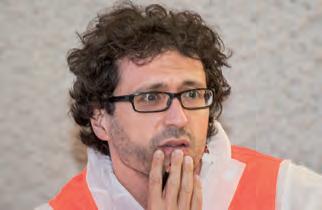
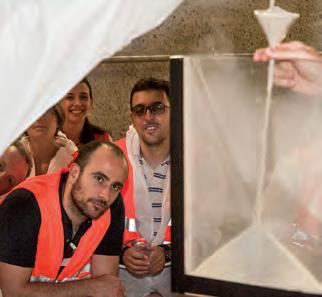











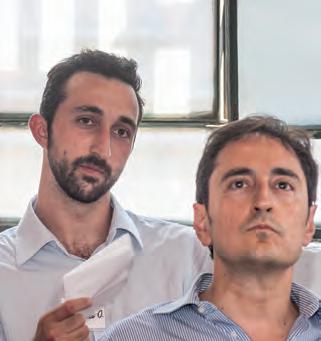





Work Style — #12.13 83
Pini Swiss engineers observe with attention
Massimo Temporelli
Francesca Sestan
Paolo Mascia
Marco Bravo
Elena Davsar
Santo Pirrotta
Christian Eberli
Matteo Ordanini and Diego Fulco
Alessandro Foletti
Donatella Villano
Alberto Riganti
Luca Iozzia and Sandra Musso
Sophia Los
Francesca Romana Allamprese
Albina Gabellini Pucci
Annamaria Cavazzuti
Elio Carmi
Gabriele Ghinelli
Mario Castagna
Measurement of Disorder
Entropy: from thermodynamic systems to chaos.
CHAOS
Can we make it simple? A company is often a a tangle of misunderstood dynamics. Sometimes we accept them without knowing what they mean; sometimes we think we know the meaning but are "too navigated" to deal with the consequences of order. The chaos theory is the study of physical systems through mathematical physics models, which exhibit an exponential sensitivity to initial conditions. Chaos leads to chaos; evolution can be driven by an empirical randomness. In fact, random behavior is only apparent.
ORDER
The company often conducts reorganizations with the goal of reaching a state of order or an acceptable standard. In fact, physics teaches us that disorder is the most usual status, while order is always only a temporary condition. Managing the dynamics between order and disorder brings a great energy, mostly positive, for the company.



INTERNAL/EXTERNAL
How many companies have been in a constant reorganizational state for decades? Organizations evolve, whereas relations with the market change. There are in fact variables within the same organization which impose change and external variables that affect the organization and determine its change.
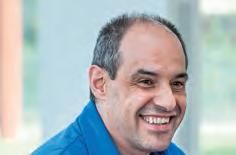
EXPERIMENTS
The experiments performed in these Creative Talks relativize the hypothesis that order is better than disorder, enhancing the process of change as a preferential status, where a dynamic company lies. The audience is informed about the long periods of stability, which are seen as a condition in which a company's proposal does not evolve, which puts itself in a weak position with respect to the dynamics of chaos.•
84 Work Style — #12.13
Carlo Leardi
Paola Cicogni
Regazzi TPS (Switzerland) is a company specialized in the production and sale of building materials, in particular products for sun protection.
Tetra Pak (Italy) is one of three companies in the Tetra Laval Group. It is a multinational which produces integrated systems for the treatment and packaging of foods.

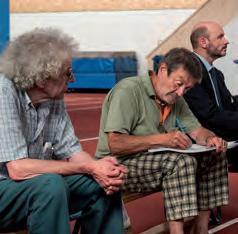



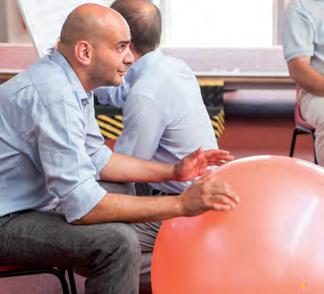
















Work Style — #12.13 85
Davide Borghi
Ignazio Crasci
Carlo Marazza
Luca Maiocchi
Giorgio Pellanda
Christian Vitta
Enrico Ratto
Cesare Sinigaglia
R. Carazzetti, P. Pedroli
A. Ciani, A. Senijad and R. Siccardi
Claudio Morandi
Roberto Siccardi
Graziano Gianelli
Giancarlo Cotti
Nicola Ferrari
José Luis Moral
Dario Piccaluga
Emanuele Saurwein
Sara Spinelli
Federico Ott
Gianmaurizio Cazzarolli
Daniela Monaco
Darwinism and Business Organization

How much to differentiate? Survival or extinction.
DARWIN
Charles Darwin (1809-1882) assumed that the evolution of a species followed an evolutionary dynamics based on three fundamental premises:
• Reproduction: all living organisms reproduce at a rate such that, in a short time, the number of individuals of each species could not be in balance with the environment and food resources put at their disposal.
• Variation: between individuals of the same species there is a wide features variability.

• Selection: there is a constant struggle for survival between individuals within the same species and with other species.
MODALITY OF CHANGE
Darwin stated that the evolution of new species occurs through a gradual accumulation of small changes. Each species has its own adaptation to the environment that has in turn evolved through natural selection.
CHANGE OR DIE
Isn't it true? Is the need for change only valid in certain sectors?' Some very successful products have always been the same! These are some false statements collected during the Creative Talk dedicated to Darwinism and in a subordinate position to change. Every successful company is a promoter of change. Even Nutella, the hazelnut cream reknown throughout the world for its “stability” actually changes pairings, packagings, methods of use, and advertising because without change it would become an old product.
VELOCITY OF CHANGE
Experiments teach us how the velocity of change is dictated by the evolution of the market in which products live. Thus the culture of constant comparison (with the market and with competitors) is the best insurance policy for each enterprise. •
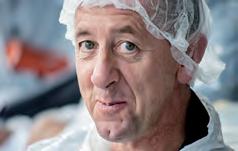

86 Work Style — #12.13
Beste, (Italy) a Prato-based company, boasts of a large textile collection, ranging from outerwear materials to fabrics for shirts and jerseys, as well as cottons and natural fibers, but also synthetic ones and the most innovative polymers.
Sandro Vanini (Switzerland), has been manufacturing with traditional methods all kinds of candied fruits since 1871. Its production includes candied fruits, marrons glacés and other exclusive fruits specialties.
Michele Tonani
Massimo Collura
















Work Style — #12.13 87
Gabriele Perrucchetti
Beatrice Fasana and Nadia Ghisolfi
Nicola Pini
Orlando Campopiano
Giacomo Caratti
Sara Maccanti
Valter Tettamanti Massimo Temporelli explains an experiment to participants.
Sara Capecchi
Matteo Santi
Graziano Gianelli
Silver Nava
Ugo Ferroni
Enrico Giorni
Federico Pagliai
Stefano Fantappiè
Relationship Between Machine and Behavior
From Charlie Chaplin to the post-industrial man.
THE MAN IS THE MACHINE
It is known that our era lives in the sign of the machine. The Italian scientist and popularizer Boncinelli highlights the ambivalence that runs through the concept of car and that of artificiality: possibility and decadence. No animal is able to produce a device capable of supporting engineering and, in certain cases, to replace man in daily work, both for what concerns work and communicative space.
The author sees a fundamental dynamic in the birth and progressive improving technique, starting from the choice of a particular man's discretion, concentrating the potential, energy, and decreasing the time of realization. Moving from early inventions to our time, Boncinelli denotes an increasingly refined formation of the concept of purpose.

EVOLUTION OF THE MACHINE
The phase running between the birth of the first utensils made from branches, bones, stones and nanotechnology today is the path of fusion that technique and society have had; the cultural evolution of tools accompanies the increasingly refined expression of the human brain and the bond between "knowing" and "know-how". Thus an alternative plan to logic has emerged that separates the object identified by its potential, its usefulness, providing humans with the constantly improvable resolution of the problems caused by the limits of the human mind and body.
INSIDE THE COMPANY


The question is: which limit do we want to impose on knowledge? Does an obligation to know the most used machine (the computer) exist or can we use it without knowing it rationally? Does knowing a computer mean knowing how to use it? •

88 Work Style — #12.13
Thun (Italy) is an Italian company producing and distributing handmade collector’s items. The organization is headquartered in Bolzano and also runs a non-profit organization, active in social sponsorship, amongst other things.
The company Minimotor (Switzerland) belongs to the Faulhaber Group and has been working in the implementation of innovative, high precision drive technologies for more than 60 years. These have unlocked new opportunities for plenty of cutting edge applications.
Alessandro Bonanno
Luca Melchionna
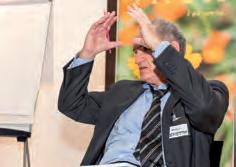




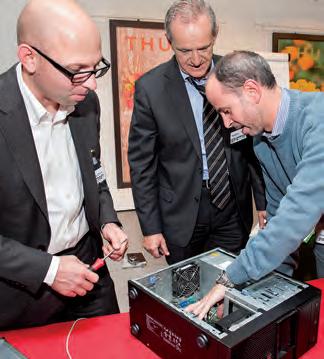









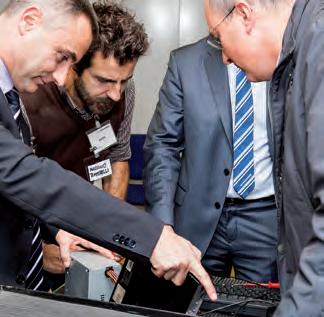

Work Style — #12.13 89
Gabriella Bernardi
Marco Repetto
Michele Libori
Lucia Adamo
Stefano Donati
Raffaele Ape
Michele Matis
Alessandro Sannicolò
Martino Gorno
Diego Caccavale
Silvio Taraborrelli
Valeria Adami and Silvia Franceschi
Lorenzo Marcotullio
Michele Matis and Massimo Temporelli
Alessandro Sannicolò, Martino Gorno and Massimiliano Paganini
Daniel Tocca and Luca Guadagnini
Christian Pezzei, Marco Repetto and Alessandro Zuech
HR EVENTS for Work
REPORTCountry: PORTUGAL
City: Lisbon
What: 2013 EMEA
Expatriate Management Conference
Date: 11 - 12 April, 2013
Who: Mercer Web: mercer.com
This annual event enabled attendees from across Europe, the Middle East, and Africa to network and compare their expatriate management strategies. The expatriate mobility landscape is evolving fast. The prediction of a decrease in the number of traditional, costly expatriates and their replacement by local employees has not materialized. Instead, companies are witnessing the emergence of an even more complex expatriation landscape.
It is true that for an increasing number of moves that might be considered easy, moves within Western Europe, for instance, employers are more reluctant to offer a full expatriate package. Cheaper options, such as transfers to terms and conditions in the host location, are being considered whenever possible.

And yet the rise of emerging markets ensures that traditional long-term assignments supported by a comprehensive benefits package are not disappearing. The ongoing search for commodities and lowcost manufacturing destinations leads companies to hardship locations. While a costly expat package might not be justified for a move from London to New York, an employee relocating from London to Luanda, Angola, with family, justifiably expects comprehensive support and significant incentives. Furthermore, regionalization is accompanying globalization as an increasing number of moves resulting from globalization are “lateral moves” — that is, moves between emerging markets. This change forces companies to reassess their policies and examine whether their approaches are compatible and cost-effective for this new mobility
pattern. One of the early consequences of various types of expatriates coming from and going to emerging markets was that large employers found it increasingly difficult to have only one policy covering all international assignments. Employers are increasingly segmenting their expatriation policy, not just by assignment duration (long-term versus short-term) but also by expatriate assignment purpose (strategic assignment versus developmental moves or moves requested by the employees themselves). In the context of budget constraint, this segmentation is a way to shift the budget from less essential moves to assignments that are critical to the business.
In a rapidly changing world, employee mobility is more than ever a core component of a multinational company’s global talent strategy and not just an administrative function. The global talent landscape is one of great contradiction, a mix of shortages and surpluses. The global war for talent, once focused on key engineering skills, is spreading to a greater variety of positions and skills across all industry sectors.
Country: USA City: San Diego
What: ERE Recruiting Conference and Expo Date: 15 – 17 April, 2013
Who: ERE Web: ererecruitingconference.com
ERE Media held one of its two big events for in-house recruiting leaders in the spring of 2013 in San Diego. The event was filled with big company speakers-- recruiting leaders at large and global corporations. Spring speakers covered such hot trends and topics as video interviewing, recruiting with mobile devices, and implementing a social media strategy. One of the most interesting sessions was a keynote session about robotics, and how that’s going to change the future of the workforce. Another interesting thing about the conference was the roundtables, an opening session where the attendees divided up into discussion groups on one of about twenty-five topics of their choosing. You could see right away that the “big data” table was standing room only, with people crowded around to discuss what to make of this buzzword that’s all the rage. Just as interesting was the ERE Recruiting Excellence Awards, an annual look at which inhouse departments are getting great results. Ernst & Young was the winner in three categories: branding, referral, and college recruitment .
Country: AUSTRIA
City: Vienna
What: 3rd Global HR Leaders Date: 19 – 20 September, 2013
Who: EBCG Web: ebcg.biz
Attendees of the 3rd Annual Global HR Leaders conference came from Spain, Finland, Austria, Turkey, Estonia, Switzerland, Portugal, Ukraine, Czech Republic, Bulgaria, Russia, Serbia, Hungary, Germany, Slovakia, Slovenia, Lithuania, Poland, Georgia, Holland, Belgium, Romania, France, Croatia, Denmark, and the UK. The HR experts gathered to discuss latest trends and best practices in talent management and employee engagement. What were the most interesting nuggets from the talks? Adrian Cojocaru from EBRD noted that fifty percent of workers will soon be Gen Y, while most people in powerful positions are Gen X or boomers. We were also reminded that many of us in Europe will eventually work in one way or another for companies run from China, India, and other emerging countries. During the employee engagement session, a “What engages you most and why” survey was taken by John Smythe from Engage for Change. As elsewhere in the world, people mentioned space, freedom to act, being myself, working beyond my normal team, being visible, clear boundaries, and visible support. Remarkable notes on strategies for talent management were shared by experts from Ericsson, Grundfos, BAT, and Tesco. Assessment and development tools were shared by speakers from Lenovo, Santander, UniCredit, and Toksoz Group. The atmosphere was lively and featured an inspirational talk on embedding poker strategy in management decision making, with practical exercises during a networking evening reception.
Country: SINGAPORE
City: Singapore
What: HR Summit Singapore Date: 24 – 25 April 2013
Who: Key Media Web: hrsummit.com.sg Report by: Rafiq Jalil
On April 24 and 25, 2013, STJobs HR Summit 2013 hosted 4,129 HR and related business professionals from every major industry. Organized by Key Media and held at Marina Bay Sands Singapore, the Summit is Asia’s biggest and most popular yearly HR event. Close to one hundred local and international speakers gave exclusive presentations covering a wide range of HR topics, issues, challenges, and opportunities from employee learning and development to talent management and innovation. Leaders of top global companies such as Carl Zeiss,
90 Work Style — #12.13
AGENDA 2013.2
Ottmar listens. His people trust him to be a leader who stays in touch. How does he do this so well? He was taught to lead differently.

Work Style — #12.13 TheSLIIExperience.com Learn Different. Be Di erent. Lead Di erent.
FROM ANYWHERE: +1 760.489.5005 • EMEA: +44 (0) 1483-456300 • ASIA: +65 6775 1030
Facebook, Google, Barclays, and 3M shared insightful case studies and human resources best practices.
Adapting Workforce Strategies. A highlight of this year’s conference was the CEO Think Tank & Panel Discussion on “Overcoming Singapore's Talent & Staffing Challenges,” where forward-thinking CEOs discussed how they were adapting their workforce strategies to fit a rapidly changing talent landscape in Singapore. The session featured esteemed panelists such as Kensaku Konishi, President & CEO, Canon Singapore; Jan Smits, CEO Asia, Middle East & Africa, InterContinental Hotels Group (IHG); Eric Teng, CEO, Property & Hospitality, The Straits Trading Company; Helene Auriol, Managing Director, Microsoft Singapore; and Khoo Seng-Thiam, Managing Director, FedEx Singapore. International speaker and author Anja Foerster concluded the STJobs HR Summit 2013, with a powerful message on how companies can identify growth opportunities and gain an ultimate competitive advantage. All New STJobs HR Summit 2014. The HR Summit will be back next year, offering first-class presentations, discussions, and case-studies from distinguished speakers such as Dave Ulrich, HR guru and management expert, and Vineet Nayar, Vice Chairman of HCL Technologies and author, as well as CEOs and high-ranking HR practitioners from Coca-Cola, BT Global, Groupon, IBM, Mastercard, Samsung, Shell, Unilever, and many others.
Country: THE NETHERLANDS
City: Amsterdam
What: HR Tech Europe 2013 Date: 24 – 25 October, 2013
Who: Pan-European HR Network Web: hrneurope.com
The winner of this year’s iHR 2013 Award was Dutch start-up Appical, and it was great to see a European win this year. Appical Founder, Gerrit Brouwer, posing as an airline pilot, made the case for turning new employees on to cutting-edge technology and social media. Companies that have tried the technology claim to have reduced employee onboarding costs by 30 percent and raised productivity by 50 percent, a sign of a winner. It was a close competition. The runner-up was Zao, who was only one point behind, and third was ConnectCubed, only two points behind. The next four were Apploi, jobFig, Macromicro, and Good.co. All did a great job, and we wish them, and indeed all winners, every success going forward. In the three years we have run the competition, the score now stands at Europe 2, US 1. Let’s see if the US will close the gap next year or if Europe will pull away with a clear lead! From the moment Costas Markides opened the conference with an outstanding presentation to the moment Dan Pink finished his equally exceptional closing keynote, we had a truly excellent program. There are too many highlights to mention them all, including Mark Hurd’s pre-lunch session. But kudos must go to Naomi Bloom, Thomas Otter, Jason Averbook, Leighanne Levensaler, Josh Bersin, and Gretchen Alarcon for their support this year. Out in the HR Tech stream, Vinzenz Kremer, Jan Willemse and Sarah White were speaking to a packed room,
while many of the sessions in the Learning, Talent, Social, and Future of Work streams were filled to capacity too. Looking ahead, next year should see continued improvement and development as we strive to ensure that our program for that event delivers more and better.
Country: USA City: Washington, D.C. What: 2013 Nonprofit HR Conference Date: 20 – 22 October, 2013 Who: Non Profit HR Solutions Web: nonprofithr.com Report by: Leslie Walbridge
For three days in October, over 150 human resource professionals and executives from nonprofit organizations located in twenty-four states and two provinces of Canada came together to focus on one theme: shattering the status quo. This idea is crucial in the HR field within the nonprofit sector because there is an imperative to recruit talent and to keep those employees engaged in and passionate about their work, so that the sector remains robust and mission-driven.
All of the plenary speakers used their own terminology and experience to inspire attendees to make changes in their organizations. Jason Lauritsen from Talent Anarchy led an innovation session where he taught attendees to “hack” their practices to make them “more awesome.” Later, Sam Cicotello from The Motley Fool described how her staff always strives to “top it,” which means to take an idea and make it better, or propose a completely different and superior idea. For Pratichi Shah of Flourish Talent Management Solutions, shattering the status quo means building the table rather than asking for a seat at it. NPR’s Jeff Perkins presented the strategies his team used to rebuild and rebrand HR by “being the company.” During these keynote sessions as well as breakout sessions, and even during meals and breaks, it was clear that these nonprofit leaders were looking for practical ways to break from norms and traditions and change not only how they do their work but also how it is seen and understood by others, both within and outside their organizations and sectors.
UPCOMING
Country: CANADA City: Vancouver What: 52nd Annual BC HRMA Conference & Tradeshow Date: 15 – 16 April 2014 Who: BC HR Management Association Web: bchrma.org
This is the largest HR event in Western Canada, with insightful keynote presentations, concurrent tracks of sessions, peer-to-peer dialogue, and the opportunity to earn continuing education credits. The 2014 conference will feature closing plenary presenter Col. Chris Hadfield, recently retired Canadian astronaut and former commander of the International Space Station.
Country: UNITED KINGDOM
City: Manchester
What: Manchester HR Summit Date: 27 February 2014
Who: Forum Events Web: forumevents.co.uk
The Manchester HR Summit is a highly focused one-day event that brings the Human Resources industry together for interactive seminars, discussion groups, business meetings, and networking opportunities. This event is a relaxed and stress-free way to discover essential industry knowledge and make valuable business contacts, providing benefits for future HR development.
Participants can attend topical seminars hosted by industry specialists, exchange views, ideas, and experiences with their peers, and meet with their choice of HR service providers, who are experts in offering solutions to the issues that face the HR industry today.
Country: INDIA City: Bangalore
What: Bangalore HR Summit Date: 13 – 14 December 2013
Who: Institute of HRD Web: hrsummit.in
At this HR Summit, over 250 Human Resources professionals from India, Asia Pacific, Africa, and the Middle East are expected to deliberate on the theme of Futuristic HR Practices for Enhancing Organizational Competitiveness. The HR Summit will witness presentations and deliberations by eminent CEOs, Senior HR professionals, researchers, and academics. HR has over the years changed according to the needs and requirements of the organization. Seen decades ago as an administrative function and now as a business function, it’s important to consider how HR will be positioned in the future, especially how various HR functions will work toward fulfilling a company’s business goals.
Country: USA City: New York, NY
What: Executive Coaching Conference Date: 6 – 7 March 2014

Who: The Conference Board Web: conference-board.org
The 2014 Executive Coaching Conference will continue to deliver current research, best practices, innovations, and coaching experiences for senior leaders responsible for coaching in their organizations. The benefits of attending last year’s conference included key learning from seventeen companies on the current state of internal coaching, latest industry-wide research on coaching from around the globe, distinctions between and best uses of group and team coaching, what it takes to prepare managers to be “good career coaches,” case studies and examples of building a global mindset, as well as coaching the Whole Leader. The Executive Coaching Conference is a valuable source of information and insight for those in Coaching, Leadership Development, Human Resource Management, Training and
92 Work Style — #12.13




















Work Style — #12.13 SPONSORS HR Networking Cocktail HR Awards Ceremony & Dinner HR Conference Silver Silver Silver Silver Silver Gold Gold Gold Photography by Electric Car MEDIA PARTNERS 11TH HUMAN RESOURCES GALA Luxembourg - November 21st gala.hrone.lu Register now on: with your personalized access code from our partners Work Style : 1WOS13* *Personal invitation for HR Conference & Networking Cocktail only, exclusively addressed to Top management and HR professionals. Can not be used by a services provider. 1.000 HR PROFESSIONALS CONFERENCE: THE CHANGING FACE OF HR with Xavier Molinie, Dell Thomas Edig, Porsche NETWORKING COCKTAIL & HR AWARDS CEREMONY
HR EVENTS for Work
Learning Development, OD, Mentoring, and Line Professionals looking to implement coaching programs in their departments.
Country: UK
City: Birmingham
What: HR Directors Business Summit Date: 4 – 5 February 2014

Who: World Trade Group Web: hrevent.com - hrdistinctionawards.com
The HR Directors Business Summit is a senior meeting place for the HR and business community, specifically directed at strategic HR and business performance. Now in its twelfth year, the HR Directors Business Summit will focus on achieving and aligning business strategy by ensuring that people are at the heart of your business. This summit provides the ideal platform for the most senior thinkers and practitioners to come together to share experiences and to network and benchmark with their peers. Here are a few topics that will be discussed at the event: strategic HR and business performance, engagement, retention and rewards, social HR and policies, and employment law. In addition, The HR Distinction Awards celebrate the outstanding contribution that innovatively designed and superbly executed HR strategies make to business performance and the bottom line. The awards winners will be announced at a black tie Awards Gala Dinner, hosted at the HR Directors Business Summit at the ICC in Birmingham on 4 February 2014. The evening will include a champagne reception, three-course dinner with wine, the awards presentation, and entertainment.
Country: LUXEMBOURG
City: Luxembourg
What: HR One Gala Date: 21 November 2013
Who: Farvest Web: gala.hrone.lu
HR One Gala is the event for Luxembourg HR professionals. This B2B event gathers about a thousand professionals in the HR industry. It is traditionally made up of three events: a conference, a networking cocktail, and a gala dinner. Each year renowned personalities give keynote conferences and participate in a round table. Such leaders have included: Dorothée Burkel (Google), Carole Wainaina (Philips), and Sylvia Ayyoubi (Roche Group) who took part in 2012. The event in its eleventh edition will address "The Changing Face of HR.” Guest speakers include Xavier Molinié, Executive HR Director EMEA at Dell and Thomas Edig, Executive Vice President of Human Resources and Deputy Chairman of the Executive Board of Porsche.
Country: CZECH REPUBLIC
City: Prague
What: HRD International Summit Date: 24 – 25 April 2014
Who: IEM World Media Ltd Web: hrdevent.com

The summit will offer key presentations, panel discussions, case studies, and interactive workshops. Top industry professionals, who are actively implementing HR services and strategies within their corporations, will describe the ultimate in benchmarking experience and will offer best practice insights. Emerging challenges in HR and development strategies to achieve superior and dynamic business results will also be addressed. Global forces of change, whether political, economic, or social, are powerful shapers of HR strategies. New and innovative thinking is needed. It’s not enough to just follow and react to the news; proactivity is key. Economic slowdown directly affects currency movements and globalization, which in turn have ramifications for mergers, takeover issues, and expansion strategies. More than ever, it is essential for today’s director to be aware of developments and best practices to design new, effective strategies in engagement, talent acquisition, leadership development, and administration. Also key are change management strategies to achieve success in this challenging environment. Learn about best strategies to recruit and retain staff, develop leaders, produce reward schemes, and deal with the challenges of change management. In an exclusive environment tailored for quality, the HR Directors International Summit 2014 is designed to provide the best in facilities and in applicable knowledge. Focusing on workable strategies and solutions leading to improved real-world performance, the summit will faciliate your efforts to maximise and achieve corporate goals.
Country: USA
City: Las Vegas, NV
What: RPI Annual Conference Date: 12 – 16 January 2014
Who: Recognition Professionals International Web: recognition.org
The event will focus on the importance of recognition for successful businesses. With a wide range of subtopics, the event gives a broad perspective on how significant recognition can be. Breakout sessions cover such topics as: how to strengthen manager and employee relationships through recognition; how to make marketing an essential part of your new recognition program's success; linking employee recognition to customer service scores; leveraging social media for employ-
ee peer-to-peer recognition programs. One session is titled “Take your T.H.A.N.K.S. to the Bank: Why Employee Recognition and Engagement Matters.” Speakers include Terry Byrnes, VP of Total Services, Caesars Entertainment; Tyneeta Morris, Director, Human Resources, Greyhound; Gail Ann Rawlinson, Human Resource Advisor, Recognition Services, Alberta Health Services; and Tina Weede, President, USMotivation.
Country: USA
City: New York, NY
What: Talent Management Strategies Conference Date: 5 – 6 February 2014
Who: The Conference Board Web: conference-board.org
Organizations strive to develop leaders and a workforce who can deliver business results in an increasingly global, technologically-enabled, and competitive marketplace. A solid foundation of culture and talent practices can enhance an organization’s ability to innovate and compete, regardless of business strategy and unplanned business events. Organizations that develop a talent strategy aligned to their culture and business model can proactively engage employees to deliver significant business value. In this conference, attendees will discuss the role of culture in anchoring talent and business strategies and learn how talent professionals use data and leverage technology to provide proactive talent solutions They will explore ways to engage employees to transform their businesses and deliver results. And they will learn to network with talent management professionals in order to strengthen their skills as talent management practitioners.
Country: INDIA City: Mumbai
What: World HRD Congress Date: 15 – 17 February 2014
Who: World HRD Congress Web: worldhrdcongress.com
The congress will be an executive-level retreat in which participants will review “Evolving Trends in HRM” that could change their paradigm on leading people at work. It will provide an opportunity to acquire skills to maximize competencies and become a more knowledgeable contributor in the organization. Besides networking opportunities, the conference offers unique in-depth approaches to understanding important workplace issues that affect an organization's viability in today's fastpaced business environment. This congress brings several global personalities under one roof.
94 Work Style — #12.13
Global HR Leaders
...in Talent Management


19th & 20th September 2013 VIENNA, AUSTRIA
Over 100 HR leaders from corporations operating all around Europe and beyond will meet in Vienna on 19th & 20th September. Join them and expand your knowledge at our annual Global HR Leaders meeting. Two days filled with presentations, panel discussions and streams of case studies will provide you with information necessary to move your organization forward.
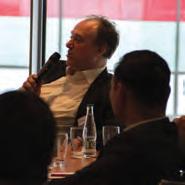




• Join to discuss creation of a successful organization plan as a powerful framework for attracting and developing the right people • Hear the tips on getting young talents on board and still creating a value proposition appealing to multiple generations
Established in 2010, European Business Conferences Group (EBCG) is a privately owned business intelligence company active in Western and Central Europe, creating and promoting strategic conferences, professional training, in-company training, and webinars. Our mission is to provide our clients with premium business intelligence insights to maintain and improve their competitive advantage and business relationships. Our vision is focused on creating a better future through our innovation and creativity. We are experts in helping you brainstorm your way to real results. Participants can expect


• Compare which strategies for talent management can work globally and when you can make the most of local specifics • Learn strategies for talent assessment, development and motivation…

About EBCG
to come away from one of our conferences with (at least) a couple of big ideas and several new key contacts. If you are a sponsor of our conference, you can anticipate leaving our event with several quality business leads. That’s how we contribute to the business communities we serve. We provide our clients with a serious competitive advantage. The company maintains the highest standards of quality and service in research, technology and product development. Our commitment to service and quality are the basis for our reputation as a premier business intelligence provider.
Quote: WOSTM Special Discount: 20% off
4 ways to contact
hr@ebcg.biz
ENJOY THE Global HR Leaders CONFERENCE AND 4 COLLOCATED EVENTS: Become a Great LeaderPersonal and Organisational Leadership Employee Engagement Excellence Master Negotiation Strategies, Tactics and Hidden Tips and Tricks Master Public Speaking and Presentation Skills 18th – 19th September 2013, Vienna, Austria
us: www.ebcg.biz
Tel.: +421 2 3220 2200 Fax: +421 2 3220 2222
A Good Place to Work in Central Europe
CANTON TICINO, SOUTH OF SWITZERLAND
Companies collaborate with universities and vocational schools for the development of products and production processes. The needs and expectations of business are high. The quality of life is also supported by well functioning public transport, and a primary quality roads network. The stability of the country is a central element for local entrepreneurs. Ticino is a good place for those in search of a stable working experience.
CRITERIA
Work Style has outlined certain criteria for those eager to enter the ranks of the 100 best cities for work in the next decade. We start from the premise that the ideal city should have a population of fewer than 500,000. Then, a strong business environment should be reflected in the presence of international businesses and a solid work ethic. Of course, quality of life, ease of housing, and access to leisure activity are important, as are a low level of corruption and a high level of commitment to the environment and to respect for workers. All of which, of course, have been recognized in Ticino.
PARTICIPANTS
“At a company level the advantage of Ticino is its diversification of activities,” says Stefano Modenini, Director of Aiti (Ticino Industries Association), who in the 20-minute documentary supports another dozen entrepreneurs who lead local companies (see list on the right).
He adds: “From mechanics to plastics processing, from electrical engineering to techno-medical--in this space, major brands can take advantage of the infra-

structure, services, research in specific areas without overlapping in the same market.” In additon, the fact that Ticino has become more attractive to business and entrepreneurs is reflected in the recent comment of Giorgio Squinzi, President of Italian industrialists. “Over the last year, 170 companies from Lombardy have relocated in Ticino.”
WHY TICINO?
It is an Italian speaking region situated south of the Alps, near Milan (circa 80 km). The city of reference is Lugano. The weather is nice throughout the year, influenced by two large lakes, the one of Lugano and the Maggiore of Locarno. Lugano is the third financial center of Switzerland, and Locarno hosts one of the major internationally acclaimed film festivals. Bellinzona is a city of artistic value with three medieval castles and is the capital of the Canton. Last but not least is Mendrisio, an industrial area with many international businesses.
PUBLIC TRANSPORT. In terms of public transport the real driver is Swiss precision: timetables are respected and prices are balanced to the quality offered. Connections with two important airports, to the south Milan Malpensa Airport, and to north Zurich Airport, are easy.
TOURISM. The canton is an all-yearround touristic destination. For the summer, there are mountains and lakes, and it is close to the Italian seaside. For winter, there are several ski resorts close to the main Swiss and Italian resorts. The offer is completed by various cultural and artistic initiatives such as museums and events.
FOR THE FAMILY
Families who move to Ticino describe the territory as quiet and suitable for raising children. The level of schools, from kindergarten to university, is very high. The level of crime and corruption are among the lowest in the world. The media inform the public correctly when the Canton experiences a media overload, which sometimes reduces the quality of each product. Media outlets are forced to simplify and produce a lot to stay on the market.
COST OF LIVING
Switzerland is an expensive country compared to the rest of Europe. However, the levels of quality of service and wages are commensurate with the value of rents and services. Taxes for enterprises and workers are not suffocating, and the job market is very free.
INTERNATIONAL RELATIONS
The geographical situation positions Ticino as a natural place of passage and exchange. The Italian population is large, and there is a significant presence of other nationalities who live in Ticino for work reasons.
RULES
In Ticino rules are clear. As in the rest of Switzerland, a law is a law. It is respected and normally does not change frequently. The relationship with public bodies is simple, friendly and very effective.•
96 Work Style — #12.13
Report
Special
Ticino Switzerland
Production Team Leader Mario CASTAGNA
The Canton of Ticino has begun to attract businessmen and the business world. It is a quiet and convenient place to settle and raise children.
[W where-to-work.com aiti.ch]
Discover a place to work in the next decade

We met:
• BSI, Franco Polloni
• Regiopress, Matteo Caratti
• ALSCO Swiss, Stefano Bianchini

• Schurter, Pietro Nizzola
• Faulhaber Minimotor, Paolo Croce, Silvio Taraborrelli


• Tenconi, Fabrizio Lucchini, Giovanni Leonardi
• Imel Energy, Franco Donati
• Adaxys, Antonio Diana, Paolo Ghidetti, Mirko Thalmann
• Erbicol, Luca Romelli
• Zambon, Sandra Giagnoni, Giampiero Roncoroni, Stefano Pellegrini

• IBSA Institut Biochimique, Antonio Melli, Enrico Gasperotti
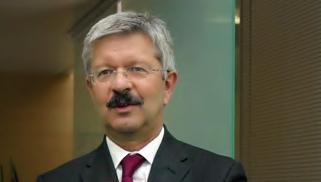


• Helsinn Chemicals, Riccardo Braglia
• Chocolat Stella, Gastone Farolfi, Alessandra Alberti

• AITI, Stefano Modenini
• Precicast, Franz Mernasconi
• Mikron, Federico Fumagalli, Daniele Pigat
• Tensol Rail, Roberto Ballina
• Credit Suisse, Alberto Petruzzella
• Università della Svizzera Italiana, Gianluca Colombo
• Früh & Pagnamenta, Ugo Früh, Luca Pagnamenta
• Antico Grotto Ticino, Peter Raith
• Museo Vincenzo Vela, Gianna Mina
• Ferrovie Luganesi, Giorgio Marcionni
• Ente Ospedaliero Cantonale, Luca Jelmoni
• MG Immobiliare, Gianni Mastroddi
• Alfonso Passera
• Agnese Balestra Bianchi
• Giovanni Merlini
[W adaxys.com aiti.ch alsco.ch bsibank.com credit-suisse.com erbicol.ch eoc.ch faulhaber.com flpsa.ch grottoticino.ch helsinn.com ibsa.ch imel.ch laregione.ch mikron.com museo-vela.ch precicast.com schurter.ch swisschocolate.ch tenconi.ch tensolrail.com usi.ch zambon-ch.ch ]

Work Style — #12.13 97
01 Riccardo Braglia 02 — 09 San Gottardo Region 03 Sasso Corbaro Castle, in the region above Bellinzona 04 Alessandra Alberti 05 Gastone Farolfi 06 Paolo Ghidetti 07 Antonio Melli 08 Franco Donati 10 Fabrizio Lucchini. 09 10 07 08 05 06 03 04 01 02 Lugano Switzerland
Communication for HR Managers
A series of interesting newsletters that can be of use to managers all around the globe. We investigate carpal tunnel syndrome and the Turkish revolution and present a homage to the great scientist Margherita Hack.


CARPAL CRAMP? NOT JUST PINS AND NEEDLES
Last Work Style newsletter:
#14 The relaunch of Detroit
#13 Cooking in the office
#12 Rules and Passion
#11 The video of Dakar is online
#10 Where to work: Dakar, Senegal
#09 A Comet named Margherita
#08 Where to work: Ticino Canton, Switzerland
#07 Quick Report on Work in Istanbul
#06 Paper #3 for free: Carpal cramp?
Not Just Pins and Needles
#05 Take part in Work Style Talks
THE POINT
by Francesca Morelli
TARGET
Each month Work Style sends a newsletter in English to 40.000 HR directors and managers all over the world.
AIM
We inform our readers on changes in the working world through interviews, journalistic articles, documentaries that we film exclusively. Our products provide factual content, are useful for companies and always put people at the center.
DOCUMENTING
Papers are written around two editorial ssectors: health (developed by Francesca Morelli) that deals with risk factors in offices and factories; and Where to Work that covers cities geared to the discovery of ideas, innovation, and teaching.This editorial feature is linked to the project 100 Work Cities, developed for Work Style by Francesco Sapuppo in collaboration with Enrico Ratto and Paolo Mazzo for images.•
Carpal tunnel syndrome is a painful progressive condition caused by compression of a key nerve in the wrist. It is not a rare condition. Approximately two of every one thousand workers in the United States will experience CTS each year, leading to significant medical expenditure and lost time from work. Giuseppa Pipola is an upholsterer at Duesse, a company in northern Italy: “I had to reduce my working hours at the sewing machine dramatically and take continuous resting breaks as the pain was quite strong and medicines did not cure the symptoms.” Vincenzo Melis, a warehouse worker says, “While working, I felt pain when lifting heavy stuff; it was like my wrist was about to come off.”
The risk of developing carpal tunnel is not confined to people in a single industry, but is especially common among those engaged in hand-intensive work requiring task repetition and forceful hand exertion. Jobs at high risk include
Follow us on: theworkstylemagazine.com
food processing, manufacturing and assembly line jobs. In addition to occupational risks, there are also personal risk factors, such as age, gender, obesity and other diseases. These may contribute to the development of CTS. There are eight small bones called carpal bones in the wrist. “A ligament (also called retinaculum) lies across the front of the wrist,” explains Dr. Charles Day, Chief of the Division of Hand and Upper Extremity Surgery in the Department of Orthopaedic Surgery at Beth Israel Deaconess Medical Center in Boston. “Between this ligament and the carpal bones is a space called the carpal tunnel. The tendons that attach the forearm muscles to the fingers pass through the carpal tunnel. A main nerve to the hand (median nerve) also goes through this tunnel before dividing into smaller branches in the palm. The median nerve gives feeling to the thumb, index and middle fingers, and half of the ring finger. It also controls the movement of the small muscles at the base of the thumb.”
The relationship between work and CTS is controversial. In many locations, workers diagnosed with carpal tunnel syndrome are entitled to time off and compensation. In the United States, carpal tunnel syndrome results in an average of $30,000 in lifetime costs (medical bills
98 Work Style — #12.13
[W bidmc.org globalhealthinsurance.net theworkstylemagazine.com]
HR EVENTS Newsletter
01
01 Illustration by Sergio Membrillas
A COMET NAMED MARGHERITA
by Mirko Nesurini
Margherita Hack was born in Florence, Italy, on June 12, 1922 and died in Trieste in June 2013. Her passion was unleashed by her first research on ‘Cepheid variable stars’, which led her to a degree in astrophysics in 1945, and inspired her to follow her academic path. Margherita was blunt when speaking of women’s liberation. “What counts in life is grit and competitiveness,” she says. After the war, Trieste became a ‘science city’ internationally. Emptied of its industry, fearing the Soviet Bloc that was only ten kilometers away, the vocation of the city became attracting men of science who leaned towards the rich and well-organized physics faculty. Margherita, who was not a part of that faculty, found a way to enter the field, and took the opportunity to launch her observatory,

thanks to the connections with her international academic colleagues.
“Changing the world of research was part of my job,” says Hack. When Margherita started her journey, Italian universities were in the hands of the so-called Barons, who were controlling the power.
The movements of ‘68 gave birth to a new era for the sector, and Margherita was one of the most determined scientists.
Margherita Hack was an extraordinary person. She talked to us for a hour sitting in her kitchen, with absolute clarity and simplicity. Without any notes, she opened the starry wonders of the universe in front of her. Margherita was a direct, cheerful, ironic person. She was dressed in colorful pants and a shirt, just like a teenager. We felt like she has always been our friend.
[W Download the complete interview with great scientist Margherita Hack on our website and discover her views on religion, astrophysics, politics and other forms of life in the universe.]
and lost time from work). Mark Sneed, Vice President at Global Health Insurance claims that his company doesn’t offer specific policies for this disease; however, some other policies include coverage for the illness, “assuming that it was not a pre-existing condition at the time of application,” says Sneed. If you wish to read more on Carpal Tunnel Syndrome, you can download the paper, written by our author, on our website for free. Learn about the symptoms, diagnosis and available treatments, as well as health insurance coverage.•
TURKISH REVOLUTION
by Thrasy Petropoulos
Work Style canvassed a number of professionals to ask how the crisis has affected them and their predictions for local businesses, both domestic and abroad. The reactions are perhaps more revealing than the report of any gas-masked foreign correspondent from Taksim Square. Filiz Katman, an assistant professor of international security and terrorism at Istanbul's Aydin University and president of the Energy Politics and Markets Research Center, offers a revealing insight. "Turkish business life has been experiencing a unique situation due to ongoing events in Turkey," she says. "As in all cases, it has both positive and negative effects." Bedriye Hülya, an entrepreneur who has opened the B-fit chain of gyms for women, acknowledges that there has been a dive in the number of new businesses starting up and a dent to notions of freedom.
"But this chaos is much needed in order to go forward," she says. "Over the last six months, the Turkish population has felt some threats against the fundamental principles of democracy and the secular republic," points out Mehmet Yildirim, of Phonak Turkyie, a leading supplier of hearing acoustics for the aurally impaired. "This has been a social explosion," says Serra Titiz, of Mikado Consulting. "The wall of fear has fallen down and people are voicing themselves, asking for freedom of expression. [Erdogan] and his government have been taken unreasonable decisions on behalf of the people and intervening in areas like abortion, drinking bans, greenlands.” •
[W If you want to read more on how the protest has affected business and their operations in Istanbul, download the paper for free from our website. You can read about the experiences of people living and working in Istanbul.]
Work Style — #12.13 99 [W
phonak.com.tr] 03
03 04
theworkstylemagazine.com aydin.edu.tr b-fit.com.tr mikadoconsulting.com
Margherita Hack 04 Illustration by GK Istanbul, Turkey
A Growing Fashion Place
In only a few years the capital of Senegal has become one of Africa's fashion capitals, a place of work where creatives, buyers, and manufacturers meet. We meet the best entertainers in the sector during the 2013 Dakar Fashion Week.
This year our arrival in Dakar was complicated by some confusion at Customs regarding entry regulations. But, no matter. In every other way, Senegal was a delight! This magazine covered Dakar Fashion Week just a year ago. It was there we met the enthusiastic Adama Paris. Now we're here again to cover the event, in its tenth year, and explore how a mid-size African city has managed to build a strong industry employing many and supporting factories that can supply clothing made right here in Africa.
START OF THE BUSINESS SECTOR
Adama is a fashion designer who has lived outside Senegal for a few years. The link with Paris (Senegal was a former French colony that became independent in 1960) is common for people who are looking for an international experience, as Adama was. The fashion industry existed before her. It was a small-scale sector, with many shops and artisans who sewed their clothes in local style. Adama Paris “I brought together many innovators and convinced some African and international designers to believe in my project” to animate the fashion industry (through Fashion Week) and mainly to put at the center of attention a world that wasn't emerging as expected. “Being followed wasn't easy, but we did it,” says Adama. Suggesting a new destination in the strict international fashion business, which is controlled by a few fashion capitals, many glossy magazines, and a couple of influential women “isn't easy!” Thierno Ndiaye is an African male fashion model who has been taking part in Fashion Week for a few years. He described the city as “ trendy place.”
CLOTHES AS MUSIC

Alain Ducournau is a French video-producer and trend setter who often visits Africa. He's knowledgeable of fashion and local cultures; according to him, “Africa today is a creative source for the whole world in all cultural and artistic fields.” He also notes a curious connection between fashion and music, as he defines clothes designed in Senegal as “harmonious they have a noticeable, strong, and identifiable rhythm, given by cuts and colors.”
LIGHTS AND COLORS
We're north of the equator here, where light is magic. The sun hits creates an inspirational environment for designers at 32.22 degrees Celsius. Colors are clear; they play with strong and sharp shadows. There's no confusion; nordic half-tones don't exist. Here red is red and green is green—as in the photo in the next double-page.
YOUNG FEMALE DESIGNERS

Virginie Ayssi says, “We generate dreams.” It is unclear how an African sector controlled by men is, in Senegal, all about women. Adama is blunt: “Men are time-wasters; the really innovative ones are pink.”
AFRICAN DESIGNERS GO BACK HOME
The strong push for people to move to cities has developed a greater need for discussion and then to have clothes. Bizou Ahouanmenou is a communication specialist and says, “The need to stand out in new great African cities is the challenge that many African designers, who trained in Europe, are catching, deciding to install a business here,” and adds that “Fashion has become a sig-
nificant industry that creates jobs and makes money. People have now noticed its potential and there's a strong awareness about the sector by the people who live in Dakar.”
PRIDE
Conceição Carvalho is an international fashion designer who participated in the Dakar Fashion Week this year. She sees a strong creative impulse in local colleagues motivated by national pride. “Senegalese give a lot of importance to their culture,” and in their work “They often highlight to be Africans, to be at the Fashion Week to claim their heritage and this attachment has become a powerful lever of success in the industry.”
TRAINING
Oumou Sy, one of the most famous local designers, is dressed in traditional clothes. She manages a local training school and says, “All the families send their children to me for training.” This means that, being a fashion designer, is now recognized as a profession like any other.•
[W adamaparis.com cuirshowroomprive.fr dakarfashionweek.com dorothyrhau.com eda.admin.ch eho-eho.com eliekuame.com esmod.com ifdakar.org]
100 Work Style — #12.13
Pout
Dakar Nimzat Kayar
Bargny Yoff Plateau Hann Bel-Air Special Report Dakar
Work Style Troupe in Dakar Photographer ROBERTO BENZI, Journalist PINA DRASKOVICH
101 Adama Paris founder of the Dakar Fashion Week
We met:
• Dorothy Rhau, Comedian, Canada
• Michèlle Ologoudu, is a designer founder of the brand Weni, Benin

• Virginie Ayissi, Designer, France
• Bibas, is the line of designer Conceição Carvalho, Guinea Bissau

• Evgheni Hudorojcov, Designer, Moldova
• Elie Kuame, Designer, Lebanon
• Lamine Diasse, Designer, Senegal
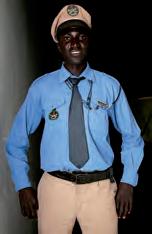

• Mer yem Boussikouk, Designer, Morocco

• Helmer Joseph, Designer, Canada
The city. Dakar is a hospitable city. Not a pretty one. Urban development is an ongoing project. There are good quality hotels. The beach is not iconic. The people, from Abdoul the security agent to Zaira the clearning lady, are kind. These are the positive entrance doors to a city that sees a chaos of nationalities in its main streets and even has conflicting ideas.
• Adama Amanda Ndiaye, aka Adama Paris, Founder of Dakar Fashion Week, Senegal
• Bizou Ahouanmenou, Agent, Benin
• Olivier Maurel, Restaurateur and owner of the African art gallery, France
• Thierno Ndiaye, AfricanAmerican Model, USA
• Alain Ducournau, TvProducer, France
• Oumou Sy, Designer, Senegal
• Muriel Berset Kohen, Ambassador, Switzerland
• Valerie Lesbros, Coordinator of the Africa Program, French Institute

• Stéphane Gnago, Head of Communication, Dakar Fashion Week, Ivory Coast.
Dakar
Work Style — #12.13
04 Adama Paris, Founder of the Dakar Fashion week 02 Swimming pool of the Hotel 03 Abdoul Tamba, hotel security
04 A typical street in the Dakar city center 08 Swiss Ambassador to Senegal Muriel Berset Kohen 09 Mr. Babatunde, street suits designer.
01 04 05 06 02 03
Fashion Week The event attracts African and foreign designers and has become an indicator of what's trending across the continent. Whether you are walking through the streets of Dakar, taking a sip of water, or at home watching the nightly news, commercials for the Dakar Fashion week are hard to miss.
Workers. From street shops to Occidental-style catwalks. People. Expats and local people, a mix that is working here.
Location. An iconic African city with its chaos and manifest cheerfulness.
Dakar Senegal
Detroit USA
Lugano Switzerland
Senigallia Italy
Plovdiv Bulgaria
Andalucia Spain
 Clothes exhibited on June 24, 2013 at the Dakar French Institute.
Clothes exhibited on June 24, 2013 at the Dakar French Institute.









104 Work Style — #12.13
Conceição Carvalho is of Portuguese origin and founded her own fashion house Bibas in Guinea Bissau in 1985.
Stéphane Gnago is a sales representative and communication officer at Adama Paris Fashion Events.
Lamine Diasse is a young stylist. He offers tailored clothing to a ready-to-wear price.
Oumou Sy is a designer who dresses the most famous singers from Senegal ( Baba Maal, Youssou N'Dour .. )
Meryem Boussikouk is one of the most famous Moroccan designers. She studied Fashion Design in France.
Dorothy Rhau was born in Montreal, Canada, in 1973. She's a comedian.
Helmer Joseph is a designer. He's Haitian and was raised in Canada. Joseph left Montreal for Paris shortly after completing his studies at Lasalle College.
Valérie Lesbros has been Coordinator of the Africa Program, Head of the Development of Fashion and Design at the French Institute.




Work Style — #12.13 105
Virginie Ayissi created a company that at the beginning proposed clothes of young designers.
Michèlle Ologoudou, in 2008, after a degree in fashion design at ESMOD (Paris), created Weni, a Female Young Designer Brand.
Evgheni Hudorojcov created the new Chic’n’Shock pret-a-porter collection "eho-eho."
Elie Kuame is a fashion designer. He was born in Belgium and raised in the Ivory Coast. Kuame rapidly developed a contemplative gaze on women in his family, particularly his mother. In 2006, while he was living in France, Kuame merged his artistic talents with his passion and founded his own line Elie Kuame Couture.
DOCUMENTARY FILM
This documentary film can be watched online: theworkstylemagazine.com/ archive
See on:
#10 Where to work: Dakar, Senegal
Text: Pina Draskovich
Video: Roberto Benzi
Edit: Roberta Zanchi, Pina Draskovich
Interviews: Cristina Milani
Staff: Marta Scetta, Elisa Irene Colombo, Awa Gaye
Music: Africa by Ori Vidiskavski

THE PHOTOS
Available on Work Style's website there's a selection of photos taken by Roberto Benzi in Dakar. workstyletalks.com/portfolios/ dakar-vertical-talk-2013
The tailors who work in the center of Dakar produce clothing for the local market. These are traditional clothes; the fabrics are not of the highest quality, but are very colored.
The three images on these pages were taken in the same street of the center where you find dozens of small handicraft shops frequented by local women. The look of the shops is minimal, and the houses are often walled with makeshift roofs.
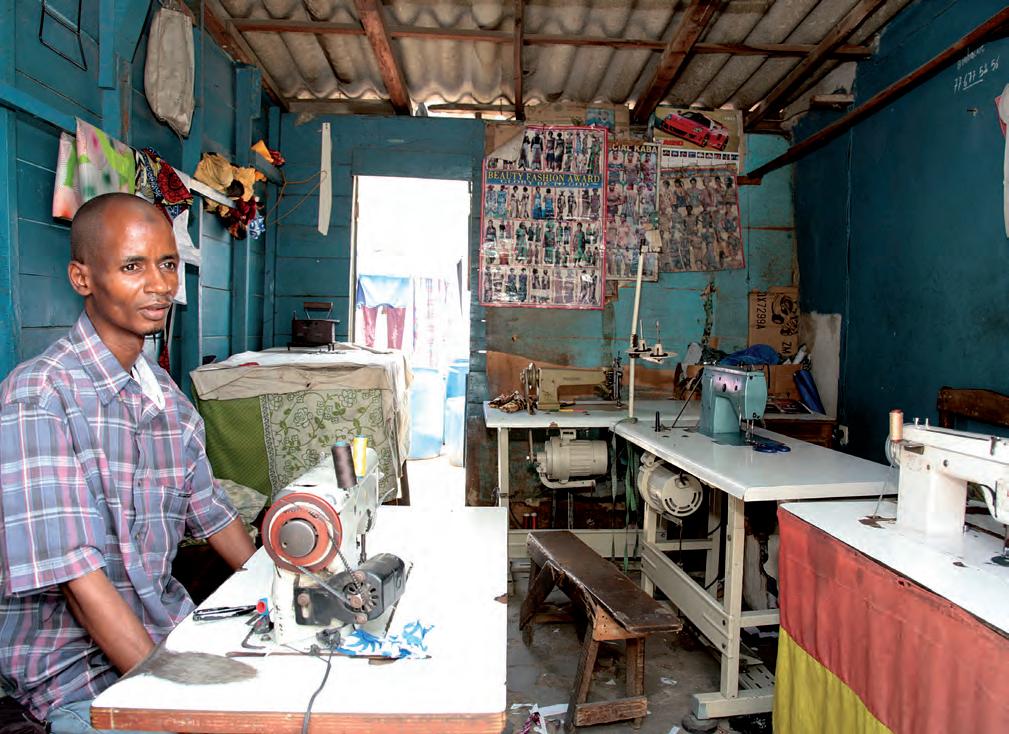
106 Work Style — #12.13
Women's dresses are traditional and very colorful. The gender of the local tailor is predominantly male. The shops are usually managed by a tailor with his apprentice and some workers. The work is spontaneous. There are no patterns (the paper pattern of traditional tailors); everything takes place on the basis of the historical memory of the tailor shop that, handing his apprentice the basics of the trade, ensures the continuation of a tradition that goes way back.


Work Style — #12.13 107
Special Report Rules and Passion
By MARTA ADRADOS GARCIA

Working with Horses in Spain
Our profession is based on explaining what the labor market is all about. We proceed with a critical point of view and with a focus based on fact never cold and distant. Work, as we conceive it, is made up of a variety of ingredients, with the main one being people, including their needs and aspirations. This is followed by the product and the place of work. The “people, product and place” trio, when correctly regulated, produces an excellent workplace.
AUTHENTIC RURAL WORKPLACE
An optimum workplace is one where you enjoy working. One visualizes a workplace where respect for the person is shown—without causing conflict— where workers feel good about what they are doing, with their colleagues and with the market.
The workplace we have in mind allows us to be ourselves even though we are working. Perhaps you are thinking… what does this mean? We always aspire to be ourselves! But this is not the case. Unfortunately, many people are forced to limit their personality, behaving in a way that is instrumental for professional success, even if that means not being happy with oneself. In some cases, companies promote the well-being of their workers, offering a favorable atmosphere, something that improves their ambitions and places them in the center of the interest of shareholders to consequently benefit the company. What I am talking about is not an utopia. Research shows very clear results: companies with an optimal work atmosphere are those that gain greater income and grow within the market. Therefore, well-being means better professional and economic performance. In the spring of 2013, we contacted ANCCE and with them, we started the project
“Rules and Passion”. It is a story based on the Purebred Spanish Horse work world, which we have reproduced through interviews with well-known breeders and members of the Association, including the president, Javier Conde and the vicepresident, José Juan Morales.

THE STORY
The result is a story that you could easily describe with a prism. You can look at it from different perspectives, through optics that, from time to time, highlight the different aspects of this fascinating world.
The project “Rules and Passion” involves a book, a documentary film, and a photographic display that will be presented at the International PRE Trade Fair (SICAB 2013) from the 5th to 8th of December in Seville. The photographs and the videos are by Roberto Benzi and Paolo Mazzo—two excellent professional photographers—while the music is by Maria Silvana Pavan, an Italian pianist and composer.
THE TITLE
The title of the project, “Rules and Passion,” is a synthesis of Álvaro Domecq to whom tribute must be paid for the clarity and content of his intervention in the documentary. The same can be said about Antonio Domecq, Ignacio Candau, Manuel Novales de la Escalera, and the other breeders whom we met during this journey through the Purebred Spanish Horse workplace.•

In collaboration with:
01 Roberto Benzi is a photographer and videographer with a career in the editorial industry. He has published his works in main magazines.

02 Paolo Mazzo is a photographer who specializes in architecture. He has exhibited in the best galleries and has worked with some of the world's archistars.
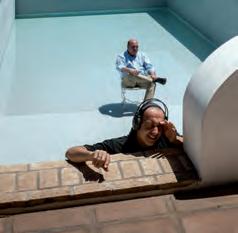
03 Mirko Nesurini, is a branding specialist who has worked with many companies of the Fortune 500 ranking all over the world. He is the founder of the Ex Brand Institute in Switzerland.
[W ancce.es cortijoeltoril.com clubhipicolamimbre.es ganaderiasalvadorcortes.es jerez.es realescuela.org rmcr.org torrestrella.com yeguadacandau. com yeguadaescalera.com yeguadamillanherce.com yeguadaquerencias.com ]
108 Work Style — #12.13
There are passions that become jobs and jobs that can’t be done without passion…
One of these jobs was the spark for this report.
01 02 03
A common project by:
04
A Symbolic image: Work and Passion
Horses. PRE genetic development. Selection and taming in different disciplines.


04 Ignacio Candau Cruz-Conde in his office 05 One-year-old foals go back to their outdoor area, Yeguada MF de la Escalera, 06 Group portrait, a Professor and alumns of the Real Maestranza de Caballería de Ronda, 07 Access to the indoor riding school from the plot, Yeguada Candau, 08 The Book "Rules and Passion (ISBN: 978-88-906114-0-7).

Cover price 24 Euros, Published by GWH (SA).

The job of the Fundación Real Escuela Andaluza del Arte Ecuestre is that of transmitting and spreading the great qualities of our magnificent horse. This task can’t be carried out without a deep passion for this wonderful animal, with whom we feel fully identified in the essence of this book. A book of emotions, where images provide, on each page, a pile of unique sensations: the art, the nobility, the harmony and the PRE’s temperament, so that our work can be fully understood in each of its manifestations.
Summary of the history Carthusian horses were born in the monastery of La Cartuja in Jerez de la Frontera (presentation by Manuel Barroso, Architect), and they have unique morphological characteristics that emphasize its elegance (breeder Cristóbal Cortés). The strategies to improve the genetics of the Pure Spanish Horse (veterinarian Millán Herce). The relationship between horse and bull in Andalusian culture (breeder of horses and bulls Álvaro Domecq). The selection and taming for different disciplines (Antonio Domecq). The studbook of the Pure Spanish breed (Javier Conde, ANCCE President, National Association of Pure Spanish Horses breeder). The steps of the Royal Andalusian School of Equestrian REAAE Art with olympic rider Rafael Soto The different competitions commented by Juan José Morales, Vice President ANCCE. The architectural environments and landscapes (breeder Ignacio Candau). The professions within the horse industry illustrated by the director of the REEAE Juan Carlos Román and the technical director of the Real Maestranza de Caballería de Ronda Juan Heredia Díaz del Riguero. The role of women in the industry with Belén Bautista Sánchez, Professor at the REEAE and breeder Desireé Lang. The personal experience of rider Javier Ruíz and the tradition of “following one’s father’s footsteps” of Manuel Novales de la Escalera, director of the oldest breeding farm in Spain. Other professions told by the voice of those who do them, such as blacksmith Manuel Grandal

Work Style — #12.13 109
[W All the information on the
are
on workandpassion.com]
project
published
05 06 07 08
The Landscapes and the relationship between horse and bull in the architecture of farms in Spain.
People. Interview with breeders. Presentation of equitation schools.
Lugano Switzerland
Andalucia Spain
Ethiopia Africa
Special Report Rules and Passions
Horse Breeding Absorbs Significant Manpower
Unlike other types, it employs many people for a small number of animals. In the bovine industry, a hundred cows require one or two cowmen, whereas ten horses need four people: a breeder, two stableboys, and a rider, not to mention the expertise of other professionals, such as veterinarians and blacksmiths.
INNOVATION
Antonio Domecq has matured professionally alongside his uncle Álvaro.
“Like my father, he follows the traditions established by my grandfather for the farm and horse bullfighting. He is a proud lover of this world.” The atmosphere at Torrestrella (the family farm near Medina Sidonia) seems frozen in time. Numerous workers are busy perfecting simple tasks, and work seems to advance as rhythmically as the hands of a watch. One thinks of a cogwheel passing energy as it turns, in order to generate a forward movement of the horse or bull. Nonetheless, innovation exists a type of innovation that respects tradition, just like the old motto Novare Serbando. “The topic of the bull is conservative, the objective to maintain the caste developed on the farm.”

As for horses there have been innovations. “The snaffles were very hard and big, today they’re small so the horse becomes submissive and tame. In the past the horse was used for work. Today we we strive to “understand the animal from the inside.”
HORSEBACK RIDING SCHOOLS
The most famous and esteemed school in Spain is the Fundación Real Escuela Andaluza del Arte Ecuestre directed by Juan Carlos Román López. The entrance exam for students takes place annually in September. It is divided into five specialties: horsemanship, stable hand, equine clinical assistant, saddlery, and harnesses. Entrance exams are given during one week and are followed by four-year courses for horsemanship and three-year courses for other specialties.
Thanks for working on the project
Ayuntamiento de Jerez: Manuel Barroso Becerra; ANCCE (Asociación Nacional de Criadores de Caballos de Pura Raza Española): Javier Conde Cerrato, José Juan Morales; Dehesa Las Navetas: Enrique Temblador Villalta; Fundación Real Escuela Andaluza del Arte Ecuestre: Belén Bautista Sánchez, Ignacio Rambla Algarín, Juan Carlos Román, Rafael Soto Andrade; Manuel Grandal Reyes, Herrador; Yeguada Candau: Ignacio Candau Cruz-Conde; Ganadería Salvador Cortés: Cristóbal Cortés Bueno; Yeguada Escalera Dª María Fernanda de la Escalera: Manuel Novales de la Escalera; Yeguada El Toril: Gabriel Durán Martínez; Hacienda la Estrella: Antonio Moya Almendral; Yeguada Millán Herce: Millán Herce Muñoz; Yeguada Querencias: Desirée Lang; Álvaro Ruiz, Herrador; Yeguada Sarmiento: Jacinto Gil Muñoz, Jacinto Jr. Gil Sarmiento, Jesús Melero, Francisco Pérez Montero, Lola Romero Carmona; Yeguada Torrestrella: Álvaro Domecq Romero, Antonio Domecq Domecq, Javier Ruíz Garrido; Real Maestranza de Caballería de Ronda: Juan de Heredia Díaz y el alumnado de la Escuela, Marta Adrados García, Roberto Benzi, Alessandro Baglioni, Bloompix Italia, Francisco Fernández Maldonado, Kathleen Friedman, Manuel González López, Stefano Guandalini, Juan Panedas Galindo, Celeste Olmo, Inmaculada Rodríguez García, María José Rodríguez Hierro, Paolo Mazzo, Mirko Nesurini, Maria Silvana Pavan, Angelo Racz, Marta Scetta, Francesco Secchi, Roberta Zanchi.

01 Juan Heredia Díaz del Riguero, technical director, RMCR
02 José Fernández Yegüero, Ganadería Salvador Cortés
03 Mayoral Lorenzo Rodríguez standing on the entrance stairs of the manor. Yeguada MF de la Escalera
04 Antonio Domecq in the saddlery, full body view, Yeguada Torrestrella

110 Work Style — #12.13
03 02
01

Work Style — #12.13 111 04
TRAINING COURSES
The objective of the school is “to integrate all professions that are part of the world of horses.” Of the four most prestigious equitation schools in Europe (Vienna, Paris, Lisbon and Jerez de la Frontera), “the school of Jerez stands out for the doma vaquera, a discipline formerly used to herd animals in the fields.”
At the edges of Andalusia, in the mountains north of Seville, sits the legendary and most ancient horseback riding school of Spain, the Real Maestranza de Caballería de Ronda. The technical director Juan de Heredia Díaz, a person of great experience and sympathy, introduced us to an important topic that is often overlooked. This former soldier, an upright character, aims for a mixed training for his pupils, jockey, sports-rider and training-rider. “Each of these areas must be equally stressed in the training of students.” Juan de Heredia points out the importance of broad education, beyond technical learning.
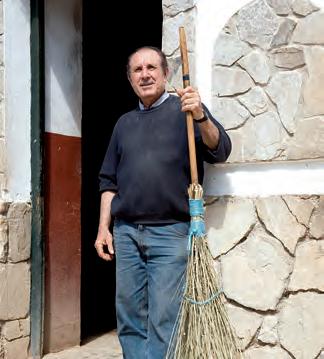
“The technical part of equitation is very important, but no more than 40% on a scale of priorities. In a rider, trainer, professor, manager or facility director, the brain must work well. It’s a question of discipline, values, and psychological control that must work perfectly!”

WOMEN IN THE SECTOR
In the Real Escuela, “women are the majority,” says Juan Carlos Román. “We stand at 60% women in perfect synch with other equitation schools in Europe.”




THE PROFESSOR
Belén Bautista Sánchez is the only female professor at the Real Escuela, and she confirms the important role of women, justifying the trend with an all female touch: “Women can be more sensitive with animals.” Personally, she is “committed to horses,” with “a passion that also enables her to bring home the bacon.” She hopes “to be able to compete in the future at an international level… we’ll see!”
112 Work Style — #12.13
05 — 06 07 — 08 09 —10
05 Riding stable’s clerk at REAAE 06 Cristóbal Sánchez, stable boy at Yeguada Torrestrella, 07 Riding stable’s clerk. REAAE 08 Juan Chico, stable boy at Yeguada Torrestrella 09 Rider teacher at REAAE 10 Anthony Pelling on Napoleón at Yeguada Candau 11 Manuel Grandal Reyes in front of his workshop-van

Work Style — #12.13 113 11
THE BREEDER
A blond, tall, happy woman who welcomes you with “meine lieben sind die Pferde” couldn’t be anything other than a breeder…a German one. Desirée Lang moved to Spain to breed PRE in 1989. Her Yeguada Querencias


12 Andrea Martín, saddling on Armas Quiebro, RMCR 13 María Bobis, pupil with Duque JLE. RMCR


14 José Barrios, chauffeur of the horses truck, Yeguada Torrestrella, 15 Paso español, Horse Verdad with professor. REAAE






16 Impaciente brushed by the pupil Daniel Roldán, RMCR.
17 Vice Chairman ANCCE, Juan José Morales in front of the stallions stable, Hacienda La Estrella 18 Jose Antonio Sánchez does maintenance works in the outside bullring,Yeguada Torrestrella 19 Mercedes Salguero, horsewoman, Yeguada Torrestrella 20 Steffi Perle with Mago 21 Corbeta whit Primoroso, REAAE 22 Álvaro Romero, rider, Yeguada Torrestrella 23 Cristobal Cortés Bueno, Ganadería Salvador Cortés 24 Cervantes YQ, Presentador José Antonio Gómez Prados, Yeguada Querencias 25 The teacher prepares the horse before entering the track for the show, REAAE 26 Antonio Monge, rider at Torrestrella
114 Work Style — #12.13
13 14 — 15 16 — 17 19 —20 21 12 18
This book is an ancient treaty published by UAIPRE, the Italian reference association for PRE horses.
Written by Cesare Fiaschi and dedicated to Enrico II of France, this manual (1556) is for horse lovers who want to know the origins of Alta Escuela and how it developed.






The book is well refined in form, text and illustrations. Here bellow we see one, which represents how proportions of a bite and a hand were curiously adopted to establish distance.

Work Style — #12.13 115 22 —23 24 25 —26
[W uaipre.it]





116 Work Style — #12.13 28 — 31 27




Work Style — #12.13 117 35 32 33 —34
The Italian tradition of equestrian art for the Renaissance and following centuries

“The Italian Renaissance is well known because of its art, literature, music and architecture; but there is a knowledge (until now considered marginal) very important for the training of European modern culture: the equestrian art”. This is how Giovanni Battista Tomassini introduces his book Le Opere della Cavalleria. Equestrian art is a very old Italian old tradition that has been handed down through the centuries but is also the plot of this book, which contains wonderful illustrations. This work contains texts of great

118 Work Style — #12.13 31
“Le Opere della Cavalleria”, by Giovanni Battista Tomassini
[W worksofchivalry.com]
historical interest but also with intrinsic esthetic value. For the first time, this patrimony of knowledge is studied in a systematic and complete way in order to rebuild the story of an eminence that had marked the equestrian practice. The sage analyses the historical and cultural reasons for equestrian art flourishing in Italy during the XVI century, remembering previous works dedicated to horses from the classic period. This book counts also as an iconographic plan which offers illustrations of the main Italian and foreign equestrian treaties. The publication is not only addressed to professionals in the field but also to people interested in knowing an important chapter of European culture and in particular for the numerous equitation lovers.


is nestled in the park opposite Ronda, a fantastic and creative place, just like its owner who has built a team of very nice and professional collaborators. Her dream is clear: “The foal Cervantes IQ can become a champion. It’s important to me and I believe it.” The philosophy of the farm is to give time to time, without exaggerating with the number of animals, aiming at quality rather than the quantity. If this breeding farm were a movie, we’d give it the highest rating: five stars.
THE MOTHER
Before Dª María Fernanda, acquired part of the Yeguada Escalera, the question of family inheritance was, according to Manuel Novales, “a lap, where men were owners of the breeding farms.” Actually his mother “has proved to be good at it.” The family De la Escalera is the most obvious example of how an old matter always managed by men could become – without any problem – a question of success. Of course we need women who know what they want and who understand that the era when the first son would inherit everything is behind us.•
27 Manuel Novales , Yeguada MF de la Escalera 28 Teacher Belén Bautista Sánchez, REAAE 29 Alejandro Moreno, maintenance, RMCR 30 Millán Herce, veterinarian 31 Álvaro Ruiz, blacksmith 32 Javier Conde, Chairman, ANCCE 33 José Antonio Sánchez, rider, Yeguada Torrestrella 34 Lola Romero, rider with the horse Doñana GS, Ganadería Sarmiento 35 Francisco Pérez Montero, horseman with an english saddle and its harnesses, Ganadería Sarmiento 36 Teacher and pupil in the saddlery, REAAE
Work Style — #12.13 119


120 Work Style — #12.13 Pini Swiss Engineers Lugano — Zurigo www.piniswiss.com
,
Pini
AlpTransit Sigirino work site, Ceneri Base Tunnel Our Top 6 projects • AlpTransit Ceneri base tunnel (15.4 km) • BLS AlpTransit Lötschberg base tunnel (34.6 km) • Kraftwerke Linth-Limmern AG Linth-Limmern hydro-electric power plant (1,480 MW) • SBB “4m” tunnel modernisation (4 m corridor between Basel and Chiasso) • ASTRA Highway maintenance projects (40.5 km) • BBT Brenner base tunnel (55 km) We look for growth opportunities for our young engineers. We like to think of ourselves as a promoter of state-of-the-art engineering skills.
Stefano Guandalini
Management Team at
Swiss, Lugano
FOOD for work
Lunch box for All
For workers who like homemade food, he has designed eight (easy to make) different lunch boxes for Work Style readers. One of the best ways to enjoy food at work is not to eat too much. Overeating can make workers feel stuffed and sleepy. They should eat light food that supplies enough energy to continue through the workday.
RECIPES
THE CHEF
THE CHALLENGE
To create in a matter of minutes a healthy packed lunch at home to enjoy later at the office.
MORENO CEDRONI, an Italian chef counting 2 Michelin Stars, has brought an avant-garde spirit to Italian cuisine. Born in Ancona in 1964, he opened his first restaurant, La Madonnina del Pescatore (regarded as one of the top 10 fish restaurants in Europe) in Senigallia, when he was only 20 years old.•

Fish and vegetables are the main ingredients of these recipes, which anybody can make at home without the kitchen of a great chef. There are eight recipes: four for seaside tastes, where the fundamental ingredient is fish; and four for those who are veggies or like vegetables. “It can be nice for those who love a highly tasty cuisine,” Cedroni says. To make a healthy cuisine, we first need quality ingredients. The first thing we must do before cooking is consider the season, then add the right amount of salt, fats, and proteins in proportions, that results in a balanced dish. Working people don’t have a long time for meals and tend to eat in haste, so they should invest the little time they have in eating good quality food. As Cedroni says, “Whether you eat at an unadorned table or whether you eat hurriedly standing up, if it is good, tasteful, and nice to look at, it will satisfy you and your stomach.”
INGREDIENTS
Moreno Cedroni has chosen a large variety of ingredients to make these lunch boxes, and he has reasons for that. “I have used white tuna--not the red because it is in danger of extinction--with quinoa. This is the year of quinoa,” he explains. He has also used octopus because “it is a mollusk known to everyone, so it’s easy to identify.” Cedroni made fish soup and fish lasagna too, which “are good if you need to warm them up,” he explains. In addition to fish, he uses vegetables as well. “I have made an aubergine cooked in a pan, which makes it very soft, and embellished it with tomato sauce and burrata, a type of mozzarella,” he says. With celery he made “sedano rapa bistecca.” This is a steak
01 Moreno Cedroni.
All photos are by Francesco (Chicco) Di Loreto, a photographer and director for the advertising and publishing industry. Besides shooting photographic images for a number of national and international brands, he has directed both commercials and documentaries. Currently working on a documentary about Japanese musician Damo Suzuki.
The eight recipes created by Moreno Cedroni exclusively for Work Style.
1 Soft Omelette
2 Celeriac with lime purée and arugula sauce
3 Lukewarm minestrone soup with pansies
4 Aubergines, tomato and burrata (a type of mozzarella)
5 Octopus with green sauce, boiled vegetables and tomato water
6 Tataki of white tuna, with sweet and sour quinoa, tuna sauce and Campari light broth
7 White Sea Lasagna, parsley sauce and grated lime
8 Fish and shellfish soup with star anise scents
seared in a pan with lime puree and arugula sauce. He cooked a vegetable soup too. “Nice, crunchy, and colorful, it goes with pansies that enhance the dish with tannin,” he says. The last recipe was an omelet (liquid and soft) with al dente Jerusalem artichoke and parsley oil.
TOP SECRET
To finish, Moreno Cedroni told us a secret. “If I had to choose one of these recipes, I would say the fish soup. As I was born in a region well-known for its fish and have eaten it since I was a little boy, even in my nursing bottle, I prefer that dish,” he concludes.
AN ADVICE FROM THE CHEF
“
For mere mortals, I would absolutely recommend a thermometer, a small investment, that allows us to comply with cooking times. If we want to cook octopus or celery at eighty degrees, we can control the temperature, something I find very important. In addition, we need to be very careful with the use of the flame, which has to be low, and cooks in the right way. We must also be accurate in the use of salt because a mistake could damage our recipe.”•
Work Style — #12.13 121
[W morenocedroni.it]
01 Detroit USA Lugano Switzerland Senigallia Italy Andalucia Spain
Africa
Ethiopia
1



SOFT OMELETTE




For the omelet mix together 200 grams of egg, 80 grams yolk (05) , 50 grams cream (02) , 1 gram salt (06) and a pinch of white pepper (01) . Peel 200 grams of Jerusalem artichokes (03) , dice it and cook it in a liter of boiling water with 5 grams of salt for about 8 minutes. Take 200 grams of tomatoes, wash them and slice them. Then put the tomatoes in a pan with 20 grams of extra-virgin olive oil (07) with 10 grams of grinded white onion, add tomato paste (04) , cover it for around 10 minutes and let it cook. Add salt to taste. Warm a non-stick pan, heat up two tomato teaspoons, pour two thirds of omelet to make it thicker. Once it is out of the fire add the rest of the egg to keep the omelet soft. Add Jerusalem artichokes dices and minced parsley. •








122 Work Style — #12.13
02 Cream 04 Tomato paste 03 Jerusalem artichoke 06 Cyprus Salt 05 Egg yolk 07 Oil 08 Oil and parsley 01 White pepper

Work Style — #12.13 123
2CELERIAC, LIME PUREE




AND ARUGULA SAUCE. Wash a celeriac (01) of about 500 grams, peel it with a peeler, slice it to 2 centimeters slices and boil in two liters of water with 12 grams of salt (04) . Boil them for 20 minutes; make them “al dente.” Drain them and put them into the fridge for a few minutes to halt the cooking, then warm a non-stick pan, pour a drizzle of oil (05) and braise celeriac slices in both of the sides with a little bit of salt. Then flavor with a spoon of salmoriglio (06) . For salmoriglio mince some rosemary and add to 50 grams of extra-virgin oil, sprinkle some lemon juice and a pinch of salt. For the purée (02) , simmer in water (without salt) 500 grams of potatoes and once cooked drip them, peel them, squash them in the potato masher and add 200 grams of diced butter, which will melt with potatoes high temperature. Mix it with a whisk and add 100 grams of hot milk. Finally grate the peel of a lime and add salt to taste. For the green sauce (07) , pour 50 grams of arugula (03) in boiling water for a minute, drip it and whisk it with 100 grams of cooking water, add 20 grams of extra-virgin oil and a pinch of salt. At the base place the lime purée, put the celeriac slices on the and add some fresh arugula. Add the green sauce at the end. •








124 Work Style — #12.13
07 Arugula sauce 03 Arugula 01 Celeriac 06 Salmoriglio 04 Cyprus Salt 02 Lime pureé 05 Oil

Work Style — #12.13 125
3 LUKEWARM MINESTRO -



SOUP WITH PANSIES

NE





Dice 200 grams of potatoes (09), 200 grams of carrots (06) , 100 grams of zucchini (02) . Then cut 30 grams of white onion, 20 grams of leek (08) , 20 grams of celery (05) , 5 grams of basil (10) , 5 grams of parsley, 50 grams of cherry tomatoes and 30 grams of chards into julienne strips. Put 20 grams of extravirgin olive oil (01) in a pan with onion and leek, add celery then potatoes and carrots, add, 300 grams of water, cover it and boil for 10 minutes. Then add the rest of the ingredients, add salt (03) to taste, leave the vegetables “al dente”, cool down and decorate with pansies and pour a drizzle of oil. •






126 Work Style — #12.13
10 Basil 09 Potato 07
06
02
03 Salt 01 Oil 04 Cherry tomatoes 05 Celery 08 Leek
Chard
Carrots
Zucchini

Work Style — #12.13 127
4 EGGPLANTS, TOMATO AND BURRATA







Slice (02) . 400 grams of eggplant in 5 cm slices. Heat up a non-stick pan and switch to low heat, place eggplant on the pan and cover so that the steam will soften the vegetables. Cook it for around 10 minutes until it melts inside. For the sauce take 200 grams of tomatoes, wash them and cut them in slices, pour 20 grams of extra-virgin oil (06) and 10 grams of grated white onion in a pan, add tomatoes and cook it covered for around 10 minutes, add salt (04) to taste and then whisk it. Slice 10 grams of burrata (03) . Flavor the eggplant with tomato sauce (07) , burrata and basil (01) •



128 Work Style — #12.13
06 Tomato sauce 05 Mozzarella 04
03
02 Aubergine 01 Basil
Salt
Burrata

Work Style — #12.13 129
5 OCTOPUS WITH GREEN

BOILED

SALSA,


VEGETABLES, TOMATO WATER. Take an octopus (about 1 Kg) (07) , rub it with salt (05) , wash it, and prepare a quart of bouillon with 5 liters of water, 25 grams of salt, 20 grams of celery and boil it. Add the octopus and boil it for about 2 hours and cool it down in the same liquid. Then drain it and keep it in the fridge for a couple of hours to keep the skin in place. For the green salsa (02) , cut 30 grams celery, 10 grams onion, 20 grams zucchini, 20 grams carrots, 2 grams parsley in bits. Add 30 grams of extra virgin olive oil (04) , 3 grams of white wine vinegar, 5 grams of desalted capers. Whisk with an electric mixer and add salt to taste.Dice 50 grams zucchini, 50 grams carrots, 50 grams green beans, 50 grams celery (06) and boil in a liter of water with 7 grams of salt. Stew vegetables “al dente.” Drain them and let cool down in the fridge to halt the cooking. For tomato water (03) whip 100 grams of tomato with 2 water spoons, a pinch of salt and 10 grams of extra-virgin olive oil. Place the green sauce at the bottom, add boiled vegetables, tomato water and finish with an octopus tentacle and a bread croutons (01) on top . •






130 Work Style — #12.13
05 Cyprus salt 06 Carrots, zucchini and green beans 07 Octopus 03 Tomato water 04 Oil 01 Bread 02 Green salsa

Work Style — #12.13 131
6











TATAKI OF WHITE TUNA, WITH SWEET AND SOUR QUINOA, TUNA SAUCE AND CAMPARI LIGHT BROTH. For the quinoa, cook 50 grams of quinoa (01) and 6 grams of salt (02) for about 20 minutes in a liter of water and then drain. Season with vinegar, sugar and salt melted together. For the tuna sauce (05), stew 25 grams of carrots, 25 grams of celery and 25 grams of onion with 30 grams of extra virgin olive oil (03) over a low fire in a covered small saucepan. Then drain and cool down. Whisk together a tin of white tuna (04) , desalted capers, anchovy in olive oil, and vinegar. For the light broth, whisk together water, Campari (06) , pink pepper, raspberry vinegar and a pinch of salt and filter it. Clean and wash some tender salad (08) . Scald briefly the white tuna filet in a hot non-stick pan marking all of the sides. Cool down and slice it. Place the quinoa at the bottom, add the tuna sauce and the white tuna slices. Place the light broth and salads on the side, add a little bit of salt. •



132 Work Style — #12.13
01 Quinoa 02 Cyprus salt 04 White tuna 07 Pink pepper broth 06
08 Different types of salad 05 Tuna sauce 03 Oil
Campari

Work Style — #12.13 133
7 WHITE SEA LASAGNA, PARSLEY SAUCE AND GRATED





LIME. For four people: 50 grams of extra virgin oil, 2 grams of grated garlic with 300 grams of grated cuttlefish (02) 100 grams of grated and shelled prawns 200 grams of egg pasta 50 grams of uncooked red prawns (05) , grated fresh parsley. Salt to taste. Make a soffritto with 50 grams of extra virgin olive oil (08) , 2 grams of grated garlic. Add 300 grams of grated cuttlefish and boil for about 20 minutes. Add grated parsley and salt to taste. Whisk half and join to the rest together with 100 grams of grated and shelled prawns. Aside, cook 200 grams of egg pasta in salted water for 4 minutes and briefly cool it down in water and ice, drain it and dry it. Grease a small plate, place a layer of pasta and fill with cuttlefish and prawns sauce, place another layer of pasta and add the fish sauce (07) . At the end place a last layer of pasta. Place it in the oven and bake for 15 minutes at 180 degrees. For the salsa, boil the parsley for a minute and briefly cool it down. Whisk with water, salt and some drops of lime. Cut and season 50 grams of uncooked red prawns with oil and salt, and place it on the top of the hot lasagna, put the parsley sauce (09) , on the sides with grated lime. Finally garnish with cuttlefish ink (04) •







134 Work Style — #12.13
03 Salt 06 Lime 09 Parsley sauce 07 Fish sauce 08 Oil 05 Prawns 04 Cuttlefish ink 02 Cuttlefish 01 Pasta

Work Style — #12.13 135
8 FISH AND SHELLFISH SOUP WITH STAR ANISE SCENTS.









For the broth (04) , put 5 grams of grated garlic (11) and 20 grams of grated white onion with 50 grams of extra virgin olive oil in a pan, sprinkle 20 grams of vinegar and vaporize it. Add 300 grams of a tin of San Marzano crumbled tomato hand crumbled and a star anise berry. Boil it for about 15 minutes and add salt to taste. Take a terracotta or a similar baking dish, pour a drop of oil and place pieces of circa 20 grams each of anchovies (13) , mantis shrimp (14) , calamari (07) , sole (08) , cuttlefish (01) and some mussels (03) and clams (10) . After, add a couple of spoons of broth and add a little bit of salt. Cover with aluminum paper and put into a oven at 180 degrees for 10 minutes. Take it out of the oven and add a slice of sea bass (06) , parsley (12) and a rotation of white pepper. For sushi rice soak 100 grams of carnaroli rice in 250 grams of water for an hour, and then in a small saucepan bringit to a boil and cover it with aluminum foil and place it in the oven for 12 minutes at 180 degrees. Then season it with 20 grams of vinegar and 3 grams of salt. •







136 Work Style — #12.13
14 Mantis shrimp 04 Broth 13 Anchovies 03 Mussels 12 Parsley 02 Star Anise Berry 01 Cuttlefish 09 Salt 10 Clams 11 Garlic 05 Oil 06 Sea bass 07 Calamari 08 Sole

Work Style — #12.13 137
Serbia
Europe Asia
Zaječar Bulgaria Ethnic groups 84% Bulgarians 8,8% Turks 4,9% Roma 2,3% Other
Pirot
Montana Sofia
Kyustendil Pazardzhik Blagoevgrad
138 Work Style — #12.13
Macedonia Greece Country Size 110,994 km2 NATO member since 2004 EU member since 2007 Population 7,4 million Inhabitants Africa
Craiova Negotin Vadin Belotintsi Vratsa Africa
Romania Bulgaria
Country Guide Bulgaria Country Guide Bulgaria
Sliven Burgas
Yambol
Edirne
Sveti Vlas
Dobrich
Varna
Nasebar
Turkey
Work Style — #12.13 139
Pleven Lovech Pazardzhik Plovdiv Svishotov Razgrad Ruse Giurgiu Bucarest Călărasi Shumen Veliko Tarnovo Stara Zagora Kardzhali
Where to Work Country Guide Bulgaria
By THRASY PETROPOULOS
Looking to the next generation
Bulgaria made the transition from a Soviet-style controlled economy to a fully-fledged European Union member with a market economy within two decades only to find the EU’s banquet table largely empty.
With nightly protests in the capital, Sofia, there is uncertainty both on the political and business scene, but there is also a clear desire by Bulgarians to earn their place in Europe.
Like most European countries, Bulgaria has been having a tough time of it lately. Economically, it is labeled the European Union’s poorest member. Politically, its recently elected Socialistled government has been the target of nightly demonstrations in the capital Sofia, sometimes blocking parliament. And socially, it has seen its population shrink by a staggering 582,000 over the last decade to reach 7.2 million as emigration – particularly of the young and educated – has cut deep. In the mideighties its population stood at almost 9 million. That certainly wasn’t the plan when it joined Nato in 2004 and completed its post-Soviet Union journey by joining the EU in 2007. In short, Bulgaria is learning the hard way that your past will always catch up with you, however committed you are to reform. It is also plain bad luck that after two decades of watching its southern neighbor, Greece, feast on the fast-moving EU gravy train only for the single currency to be all but derailed soon after Bulgaria’s accession to the single bloc. Unsurprisingly, funding has been in short supply recently, shorter still as Bulgaria has struggled to up its game to conform to a number of EU standards. In 2008, millions of euros of EU aid were blocked because of delays in tackling long-standing corruption. Two years later, France and Germany prevented the country’s inclusion in the passport-free Schengen agreement, saying the country needed to make “irreversible progress” in dealing with crime and corruption. It would be easy, therefore, to dismiss Bulgaria as a European pauper who reached the banquet it long hungered for only to find its table manners weren’t welcome and the kitchen was closed. That, however, would be to ignore the importance of
having former Eastern European bloc countries at the EU table, if for nothing more than to bring a sense of reality to the capitalist carvery. It is also unfairly dismissive of the incredible journey Bulgaria has already made towards European reintegration and the indisputable spirit for change that exists on the streets of Sofia, particularly among a youth keen to be seen on a par with their European contemporaries.
GENERATION F
Maxim Behar, a one-time journalist and now public relations expert who is CEO of the highly regarded M3 Communications Group, is unwavering in his belief that the daily protests in central Sofia do

not so much represent a society in despair as a new generation unwilling to tolerate corruption. “I called it Generation F in my recent book,” he says. “It is a generation that wants only one thing: transparency. On Facebook, Twitter, LinkedIn and right across all social media we’re all used to transparency and we want transparent politics. From that point of view society is changing. Look around the streets: young, intelligent, well-dressed, ambitious, well-educated Bulgarians and they will change the country for sure.” Behar points out that judging Bulgaria can only be done within the wider context of the post-Soviet experience of Eastern Europe and, in particular, the transformation from
Elena Dimova, HR Manager, Aurubis, an copper group and copper recycler. Aurubis has about 6,400 employees, production sites in Europe and the USA and an extensive service and sales system for copper products in Europe, Asia and North America. [W aurubis.com]
All photos, except those of Elena Dimova, were taken by Tsvetelina Anastasova, Sofia, Bulgaria.

140 Work Style — #12.13
Where to Work Country Guide Bulgaria

controlled economies to market economies. “This had never been done in all the history of the world,” he says. Bulgaria is not a different country now, it’s a different planet. None of us could even imagine that the changes would have such a deep effect on the economy. Bulgaria has gone its own way because, unfortunately, for a number of reasons a lot of the reforms were delayed. In Poland, Czech, in part of Slovenia and Croatia, many of the reforms were implemented rapidly – painful, yes, but at the end of the day if you have a fire in the house you try to stop that fire immediately. You don’t delay. In Bulgaria we were trying not to see the fire and were neglecting many of the details of the market economy. At the end of the day, however, in 2013 the country has a fully functioning market economy. The unfortunate thing is that it has come at a time of political instability – which we obviously can observe in many other countries, like Italy, Greece and Spain. I truly believe that economic reform can only be implemented if there is political stability in the country. “But we should not ne-
glect two important points of the reform: the currency board, which means the local currency is monitored by the IMF – meaning hyperinflation isn’t a possibility. In fact inflation is locked between 1% and 3%. I understand this is artificial but it gives huge predictability for foreign investors. The second is the tax policy which is the most favorable in Europe – 10% corporation tax, 10% flat fee for individuals, 5% dividend tax, which is unique in the world. Although it will naturally change soon because in the EU you cannot have a country with such a low corporate tax.” But as far as European Union membership is concerned, Behar is unstinting in his support: “A good thing, a very good thing. But also bad management of expectations. It was a huge disappointment to our society. For 15 years, politicians were talking about the benefits of the EU – based, incidentally, on the Greek example. Not only did entering the EU not bring miracles, it coincided with the onset of the global financial crisis. A lot of people expected change overnight which, in reality, wouldn’t have come even if they had spent billions. And we didn’t enter the
EU, we came back into it. The place of Bulgaria, not just as a territory but as an attitude, always was within Europe. Even under the Ottoman Empire. Right now, though, we should work to prove we deserve this place.”
AN INFORMATION SUPERHIGHWAY
And that perhaps is the greatest goal for Behar’s Generation F: to prove it deserves its place at the European table, even if the days of banquet are over. More than anything, the country is desperate to shed its “poorest EU member tag”, with an average gross monthly wage of 754 leva (386 euros), and be compared as equals. Or more than equals. Stilian Shishkov and Martin Petrov fit firmly into the latter category. The CEO and Business Development Manager of Sportal Media group are not just leaders in their field locally, but they can claim to be leaders in the regional online media presence, having established a portfolio of 40 website and 45 social media channels in six short years, most of them started from scratch. The group’s annual turnover notched 3.7 million euros in 2012 and
Gergana Gancheva, Project Leader, Aon Hewitt Best Employers Study, Bulgaria, a solutions expert in human resources, consulting services, benefits administrations & business process outsourcing. Aon Hewitt Bulgaria is launching the Best Employers Study in Bulgaria for 7th time in 2013.
“We possess the unique database of more than 500 companies participating, over 70.000 employees and 1.400 top leaders filled-in the questionnaires in Bulgaria.”
[W bestemployersbulgaria.com]
Work Style — #12.13 141
Senigallia Italy
Plovdiv Bulgaria
Andalucia Spain
Ethiopia Africa
Where to Work Country Guide Bulgaria
02
Kokimoto is unique in its own way, forever seeking, always different and provocative, a hit with young and old, insane child of the transition from one reality to another, handling the manipulative time in which he lives. Idealist with a clear sense of reality. Bordering kitsch commercialism and the cult of idols I expose my own personality. Born in 1979 and a product of the Veliko Turnovo University’s faculty of fine arts, Kokimoto is rapidly developing a high reputation both within Bulgaria and abroad as an artist worth following. His work is a combination of graphics, drawings, collages, photographs and installations. But at its heart he concentrates on examining what he calls idols in modern society.
He was asked by this magazine how he would like the world to see him. He answered: “like a very important part of world art scene. My life is my inspiration.”
01 Surprise Kinder 4, 2012,

02 Faith off! series, 2012, Acrylic on paper

03 Custom Toys.

Photography, acrylic paint on woodboard
All images are offered by Kokimoto.
142 Work Style — #12.13
[W kaloyan-iliev-kokimoto. blogspot.it] 01 03
Where to Work Country Guide Bulgaria
their staff has reached 110 employees. Claiming pride of place at their offices is a fully equipped TV studio and their 24/7 sports site sportal.bg attracts, they say, 2.5 million unique visitors a month (20% from outside Bulgaria), an astonishing number given the country’s population. Most interesting, however, is the insight the company gives into Bulgarian culture and media use. “Bulgarians aren’t inclined to pay-per-view, so our revenue is derived solely from advertising, and in this we are the best here,” says Shishkov. “When we develop a product we think of what the market actually needs and we develop it that way. Bulgaria is one of the top countries in terms of broadband access, with fibre optic to the home quite common. There are over 400 ISPs here and the country is small and easily accessible. We were delivering videos seven years ago and this is now central to our business. In fact, we develop and distribute thousands of videos a day. Our news website is on the street when people are protesting. Think of us as a TV.” He makes it sound easy and it undoubtedly isn’t. “No, it’s not easy to do business here, especially
with the situation right now,” he says. There are good things. In terms of taxes it's one of the best places to do business in the European Union, a flat 10%. In terms of connectivity, it's also good and internet usage is around 50% of the population. And there's a good level of education. Where it becomes difficult is on the political side. Things need to change, and they have needed to change for years.
“The first thing they need to change is the electoral law. There are fewer and fewer people going to vote because they are so disappointed. We need electronic voting where there will be much greater participation.” An example of political mismanagement, he says, can be seen in a recent law forbidding online advertising from unregistered gaming companies, designed essentially to try to raise taxes in this section. But without the necessary legislation in place to allow gaming companies to become officially registered, it has served to kill off a crucial source of revenue for all Bulgarian media at a time when advertising funding is down. “Over the last 4-5 years, international investments
in Bulgaria have dropped significantly,” says Shishkov. “The best years were 2005-2007 when a lot of big American and other international companies were investing in Bulgaria. But this has dropped because of the insecurity. Companies aren't sure what will happen tomorrow as far as changing laws are concerned. Having good taxes is not enough for a foreign company to invest. A business friendly environment is also important. And it should be an easy country to manage, given its 7 million population. It has a seaside along the Black Sea, there are mountains, there's a good level of education but the political decision-making has not been good.” Petrov puts it in even simpler terms: “The problem is that successive governments have been unable to follow one strategic direction. If you are driving and you keep turning left and right, you go nowhere. And this is what is happening politically in Bulgaria.” He gave a humorous but apt example. “Just yesterday the first highway connecting Sofia to the Black Sea was opened. It took 40 years to complete, mostly for political reasons. It's something like 340km
Daniela Dimitrova, marketing manager, BMW Bulgaria. BMW is a German automobile company established in 1917. BMW officially entered the Bulgarian market in 2007. BMW Bulgaria is the official importer for Bulgaria of BMW luxury and sports cars. It is headquartered in Sofia. [W bmw.bg]

Work Style — #12.13 143
Where to Work Country Guide Bulgaria
long and called the Thracian Highway because it goes through the Thracian Plain. There's a joke going round that it was named after the Thracians because they built the first kilometer.”
He added, “Business-wise, there are some very talented young people here, particularly in telecommunications. Bulgaria made a mistake 20 years ago when politicians wanted it to become a heavy industrial country producing machinery. We're simply not going to produce more cars than China, Brazil and Mexico. The country should be driven forward by concentrating on what it has: agriculture, tourism and IT. We should also build good toll roads that will take advantage of our location at the crossroads of so many countries in southeastern Europe.”
DIGGING FOR TALENT
This isn’t to neglect heavy industry. One such example is mining, which has declined in the post-Communist era but still represents an important sector in the country’s overall economy, particularly its exports, with the mining industry estimated to be worth around 570
million euros annually and employing some 120,000 people. One such employer is Aurubis Bulgaria, which operates the copper concentrate plant in Pirdop, around 80km from Sofia. The original company dates back to 1958 and it was privatized in 1997 as part of the Cumerio group when it was acquired by the German-owned Norddeutsche Affinerie Group. Under Aurubis Bulgaria, its name from 2009, it has become one of the largest copper producers in Europe. The description given by Elena Dimova, the affable and efficient human resources manager for Aurubis’ southeast European presence, gives her own interesting insight into the country, particularly as all but two of the plant’s 800-strong staff are Bulgarian.
“If we compare the Aurubis Bulgarian entity with, let’s say, other multinational companies in the country it’s a little different,” she says. “Firstly, because the first sell-off of the company, in 1997, was very successful and the company has always been owned by strategic investors who made many investments and improvements. Even during the years of crisis, between 2008 and

2011, the plant has never decreased operations. The smelter, which is the main production unit on the site, is currently the biggest in the Aurubis group, which comprises 18 sites. But what makes the difference between Aurubis Bulgaria and the other plants in the group is the technical side of operations. In other words, the efficiency and the capacity of the plant matters more than the labour cost. For sure, in terms of labour cost we are lower compared to Germany, or Belgium or even Italy, but it is not the major advantage, as it usually is in most multinationals. This is something specific to Aurubis. Actually, in Bulgaria, the engineering field generally was not considered particularly sexy in the years after the 1990s, in the so-called transition period. Bear in mind that the first multinationals in Bulgaria were sales representative offices, mostly focused on commercial operations. This encouraged people into some form of economics education. But over the last 2-3 years it has become easier to attract people to work in Aurubis, first of all because people see that a career in engineering is something at-
Maxim
M3 Communications Group, Inc. an established leader in the field of Public Relations & Public Affairs. The company was established in 1994 and since 2000 is a part of Hill+Knowlton Strategies Associates Group. [W m3bg.com]
144 Work Style — #12.13
Behar, Chairman and CEO at Communications Group
Where to Work Country Guide Bulgaria
tractive, well paid, and providing good opportunities for growth and development. On the other hand, people would still rather commute daily for reasons of family and schooling. Unemployment in Pirdop is negligible. Compare that to 5-6 years ago when the trend was that of people moving to Sofia – or the other main cities, Plovdiv and Varna – from the countryside.”
DRIVING THE COUNTRY FORWARD
There is also a clear mismatch between where many Bulgarians see themselves as far as their European social and financial evolution is concerned and their actual position. It was not just the economy that was controlled during the days of the Soviet Union but much of society too. It’s one possible explanation for the difficulty in getting people to agree to be interviewed and photographed for this article, even after they had agreed to do so. The openness and geniality of those who contributed was in stark contrast to those who flatly refused or who agreed to when originally emailed only to make an excuse or simply ignore follow-up emails. The expe-

rience was in stark contrast with all the other countries profiled in this series so far. But there can be no denying that Bulgarians see membership in the European Union as a positive move and an opportunity to raise their living and business standards. And it is precisely those aspirational qualities – not to mention largely virgin markets – which attracted many multinationals to Bulgaria in the 1990s and beyond. BMW is one such example, starting operations in Bulgaria in July 2007 straight after EU entry. There are now five full-fledged and two smaller BMW dealerships in the country as well as two service-only outlets. Sales in the first six months of the year put it seventh in terms of total sales in the passenger car market and the leader in the premium market, as it has been for the last four years. As Daniela Dimitrova, marketing manager for BMW Bulgaria, explains, “Entering the EU gave Bulgarians hope for and expectations of quick and positive changes on different levels – economic, country modernization, raising living standards, and possibilities for personal development within and outside the
country. Bulgarians look at the EU membership as a way to quickly overcome internal problems, with the younger considering it as a positive transition of the country.” She is candid, however, about the reality on the streets of Sofia. “Currently the political situation is very unstable. There have been protests on the streets for more than a month and this time it is the young and educated middle class protesting. I believe Bulgarians are tired of the corruption, the media manipulation and influence, and the lack of transparency. People are tired of the increasing difference in the lifestyle of Bulgarians and other EU citizens. The protests are for a normal life, for real life values, for clean and well-established political positions and for a better life for our kids.” She concludes: “I personally believe, nevertheless, that the success of these protests have made Bulgarian politicians learn that being arrogant is no longer an option; that their decisions will be carefully watched from now on; and that there is only one path for Bulgaria ahead… to do its best to become a proper member of the EU.”•
Martin Petrov, Business Development Manager at sportal bg, a sports media website. It was launched on March 15, 2006 in Sofia, Bulgaria. It employs over 40 journalists delivering over 300 daily news items from all over the world. It is the first Bulgarian website to launch its own web television service.
[W sportal.bg]
Work Style — #12.13 145
Refugees ... finding a job!
Finding a job is crucial for refugees finding their feet in a new country. But in Bulgaria, for most refugees finding a job and making ends meet is an arduous task. The Iraqi Palestinian family, Sammy and Maha Mahmud and their four daughters, buck the trend: they are among the few refugees in Bulgaria who have managed to set up their own business and run it so successfully that they are now self-reliant. On a dairy farm near the village of Ezero, some 15km from the Banya Reception Centre where they lived while waiting for their refugee claims to be decided, the family raises goats and cows to produce milk, cheese and yoghurt. Using traditional skills and knowledge she brought with her from Iraq, and an old family recipe, Maha makes cheese that attracts buyers from around the country. Some regular customers come from as far as Sofia, almost 230 km away, for the coveted Arabic version of white cheese, Djiben abiot. The couple is now

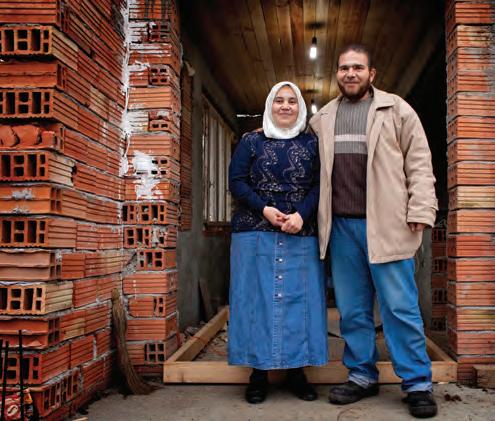
planning to buy more land, extend the business and open a professional dairy farm.
[W sopronyi.com unhcr.org]
Working in Bulgaria
Favorable tax conditions and good employee climate.
By Gergana Gancheva Project Lead, Best Employers Study Bulgaria.

The Aon Hewitt Best Employers Study has been carried out for the last seven years in Bulgaria and is part of a regional initiative involving another nine countries in Central and Eastern Europe. The main purpose of the survey is to measure employee engagement and motivation, along with satisfaction from different drivers of the working environment. Results from the 2012 study show that the
01 Sammy and Maher Mahmud
02 Daughters and dad
03 Sammy and his dough
04 Sammy Mahmud and his most productive goat, Farhad
05 Maher Mahmud smiles
06 Sammy Mahmud and one of his goats
07 Some refreshing tea
GANCHEVA
average employee engagement rate in Bulgaria increased to 67% from 64% in 2010. The biggest increase was seen in the area of satisfaction with benefits and their correlation with actual employee needs, and in the area measuring sense of accomplishment and recognition in general. Some 52% of all respondents fully agree with the statement: “Overall, my benefit
plan (eg commuting, meal, clothes, healthcare, telecommunications) meets my needs well, which is 7 percentage points higher than last year’s results.
Employees praise development opportunities. Not only do they gain useful experience and knowledge doing their job, but also training and opportunities for further education and development that their companies offer. Overall, employee satisfaction with the means being used by companies to attract and retain the right people needed to achieve goals is getting stronger.
Employees in Bulgaria are also more satisfied with the balance between their work and personal life. However, compared to the last year’s
results, the evaluation by employees of their top management has decreased by 4 percentage points. They don’t consider top management more accessible, visible, openminded and sincere. They feel that they are not being considered the company’s most valued asset and don`t think that senior leadership uniformly represent the management team’s decisions and lead the company in an effective way. New and big multinationals are investing in Bulgaria. They're bringing their policies and practices with respect to human resources, which the Bulgarian market is starting to implement very successfully. This is visible when we speak about measuring employee motivations.
146 Work Style — #12.13
GERGANA
01 02
Photo credits by UNHCR/G.Sopronyi
Ten years ago, this was absolutely unfamiliar for the companies. They would ask what it meant, why they needed to measure it. Now the situation is completely different, and such measurements are done not only by the multinationals but by Bulgarian companies as well. And the good news is that they are ranked among the “Best Employers” as well, which is welcome feedback for the Bulgarian employer in general.
Employers in Bulgaria look after their employees. It’s important for them to offer good working conditions so that they feel motivated to exert extra effort for better company results.




Lastly, the favourable tax conditions in Bulgaria make it an interesting
country for foreign investors. No change in this 10% corporate tax is expected for now. However we’re in a difficult times. There are strikes and negative feelings among Bulgarians towards the new parliament. In general, Bulgaria has a welltrained and educated workforce with language expertise. There are 51 universities in 6 different locations in Bulgaria: Sofia, Plovdiv, Bourgas, Varna, Blagoevgrad, Veliko Tarnovo. More than 40% of the country’s population is university-educated, with an average of about 285,000 university graduates every year. More than 10,000 scientists employed in the country hold Ph.D. degrees. Bulgarian IT professionals are welleducated and recognized globally.
That’s why employees working in these companies are very wellmotivated, and employers offer many incentives to retain them and develop them within the company. Elsewhere, there is a trend for young people from other isectors (automotive engineers, doctors, lawyers, and teachers) to leave the country.
Best BulgariaEmployers 2012
Large-scale

Work Style — #12.13 147
Tavex
Glaxo
Small-scale companies •
•
SmothKline EOOD • AstraZeneca Bulgaria
AE
Medium-scale companies • Telerik •
S Galabovo • Schneider Electric Bulgaria, Plovdiv FDM Plant • SAP Labs Bulgaria
companies • McDonald’s Bulgaria • Lidl Bulgaria
Aon Hewitt Bulgaria Mall of Sofia - Sofia Tower, 103 Alexander Stamboliyski Blvd., fl. 4 1303 Sofia, Bulgaria
05 06 07 03 04
T + 359 2 933 7800 [W aon.com bestemployersbulgaria.com]
Where to Work 3 Work City Guides
Work Cities Project by Work Style Growth
The 100 cities of the project are presented divided in 5 continents: Europe, Asia, Africa, America and Oceania.
STATE OF THE ART
The presentation of the first 100 cities of the project closes a circle we opened 4 years ago. We have analyzed hundreds of cities, passed them through our strict criteria, that we adopted with reasonable tolerance. They are the "first" cities, because from now the dialogue with governments begins. Some will leave and others will enter the ranking. Meanwhile, we continue to write and publish them on our APP that is gradually growing.
PHOTOGRAPHERS
The dialogue with the photographers participating in the project is everyday more intense. Paolo Mazzo (Head of the selection of professionals) is evaluating
images, projects as well as talents. While with Enrico Ratto (of Seven-days-in) we believe that the contribution given by photographers will be priceless for knowing the 100 cities. A photographer for each city will recount on our APP the relationship between living and working environments. We want to present the first photographers in the next issue of the magazine.
PROGRESS
The number of cities we reached is 29, we're at 1/3 of the journey. We're working on approximately 10 and during next year we'll cross the finish line of half project. A lot of enthusiasm comes from the fact that we have a
GIOVANNA SUSSINNA
We finished our research and defined the list of first 100 work cities of the project. In blue the guides we have already published.
EUROPE
• Mariupol
• Bergen
• Eketerinburg
• Ljubliana
• Manchester
• Marseille
• Oporto
• Thessaloniky
• Turin • Seville • Ghent
• Eindhoven • Augsburg
• Brno • Gdańsk • Pécs • Aalborg
• Goteborg
• Tampere
• Tallinn
• Kaunas
• Lugano
ASIA
• Kuala Lumpur
• Almaty
• Kyoto
• Izmir
• Beirut
• Amman
• Abu Dhabi
• Thimphu
• Battambang • Tbilisi
• Tel Aviv
• Irbid
• Hamhung
• Incheon
• Tripoli
• Caloocan
• Kaohsiung
• Bangkok
• Hanoi
• Hyderabad
• Chennai
• Kolkata
• Bekasi
• Shenzhen
• Qingdao
• Nanjing
• Novgorod
AFRICA
• Blantyre
• Lagos (Nigeria)
• Giza
• Cape Town
• Accra
• Nairobi
• Johannesburg
• Gaborne
• Liberville
• Tunis
• Dar El Salaam
• Windhoek
• Kigali
• Dakar
NORTH AMERICA
• Albuquerque
• Denver
• Seattle-Tacoma-Bellevue
• Oklahoma City
• Salt Lake City
• Houston-Sugar Land -Baytown
A WorkStyle Project
Our goal is to report on 100 work cities. We are on the right way and we've already made more than 26 city guides. During 2014 we are going to do more.
new collaborator who is committed to the project: Giovanna Sussinna, works with us from Catania in Sicily (Italy).

APP
The project has not been a walk in the woods. We're on it since 6 months. Being on it is not a nice expression but it describes clearly the attitude that we have taken with the IT guys. We're breathing on their necks, while waiting for them to release the version 1.3, the 2 previous versions have undergone a number of improvements. We now believe that we're "almost there."
CONTACTS
Contacts are the same, write to: 100workcities@theworkstylemagazine.com•
• Warren-Troy -Farmington Hills
• Cincinnati
• San Antonio -New Braunfels
• Austin
• Fort Worth-Arlington
• Milwaukee
-Waukesha-West Allis
• Detroit
• Kitchener
• Winnipeg
• Quebec City
• Edmonton
SOUTH AMERICA
• São Paulo
• Valparaiso
• Caracas (Venezuela)
• Bogotá
• Buenos Aires
• Salvador
• Belo Horizonte
• Brasilia
• Guayaquil
• Medellin
• San Jose
• Tegucigalpa
• San Pedro Sula
OCEANIA
• Sydney
• Melbourne
• Perth
• Canberra
• Auckland
148 Work Style — #12.13
[W 100workcities.com]
Where to Work 3 Work City Guide
Seville
is the capital of Andalusia, it is situated on the plain of the River Guadalquivir and is the only river port in Spain. Seville is the most populated city in southern Spain and has the largest GDP (Gross Domestic Product) of any in Andalusia. Seville's economy is dominated by the service sector, but industry still holds a considerable place, while agriculture dominates the economy of the smaller villages. Furthermore, Seville’s Old Town, the third largest in Europe, contains three UNESCO World Heritage sites: the Alcázar palace complex, the Cathedral and the General Archive of the Indies, which attract many visitors every year.
Beirut
is the capital of Lebanon and serves as the country's biggest and main seaport. The first mention of this metropolis traces back to the 15th century BC. Nowadays Beirut plays a central role in the Lebanese economy, with many banks and corporations that have their headquarters in the city centre. After the Civil War, Beirut underwent major reconstruction and the redesigned historic city centre has once again made it a tourist attraction. Beirut is also the focal point of the region's cultural and nightlife and has been ranked in recent years as one of the ten liveliest cities in the world.
Caracas
, officially Santiago de León de Caracas, is the capital of Venezuela. Caracas' central business district is Milla de Oro, which is nowadays one of largest financial districts of Latin America and is home to many companies. The city has a largely service-based economy, apart from some industrial activity in its metropolitan area. Petroleum is ranked at number one among the most important primary goods of the country and its distribution and export is one of the pillars of Venezuelan economy. Caracas is also Venezuela's cultural capital, with many theatres and museums that attract many visitors and audience every year.
Following in 2014: Tallin, Tunis, Detroit.
• Tallin is the oldest capital city in Northern Europe. The city was known as Reval from the 13th century until 1917 and again during the Nazi invasion of Estonia from 1941 to 1944. Tallinn is the financial and business capital of Estonia.
• Tunis is the capital and Tunisia's largest city. The economic focus is on textiles, carpets, and olive oil. Tourism also provides a significant portion of the city's income.
• Detroit is the most populous city in the US state of Michigan, known worldwide as the capital of automotive market in US. Today its economy is troubled.
100 Work Cities
The top 100 cities for workers over the next decade are profiled in a project put together by Work Style Company.
Free download of the guides of: Brazil: São Paulo Chile: Valparaiso France: Marseille Germany: Düsseldorf Greece: Thessaloniki Italy: Turin Japan: Kyoto Kazakhstan: Almaty Malawi: Blantyre Malaysia: Kuala Lumpur Nigeria: Lagos Norway: Bergen Portugal: Oporto Russia: Ekaterinburg UK: Manchester Ukraine: Mariupol USA: Denver, Albuquerque Slovenia: Ljubljana Turkey: Izmir Spain: Seville Lebanon: Beirut Caracas: Venezuela
Work Style — #12.13 149
USA Detroit Tunisia Tunis
Estonia Tallinn
Where to Work Focus on Japan
By PETER CONRAD
Heavy, Heavier: Japan
The high-tech headquarters with their glossy facades that house today’s giant Japanese companies do not convey the true essence of the social pact between employers and employees.
To understand this bond, based on the ancestral relationship between social classes, it is much more useful to watch one of Akira Kurosawa’s movies or read a book about the Tokugawa shogunate, which lasted for 250 years after the first Tokugawa shogun established himself in 1603. During that feudalistic time, similar to the European Middle Ages, society was strictly structured according to social class and conformed to rigid rules of power. The Shogun would force the next level of loyal subordinate, the Daimyo, to leave their families, becoming his de facto hostages. This system worked for more than two centuries in part because of the “smart” strategy employed by the Shogun of keeping Japan isolated from the world. In fact, it’s the same today.

WHY SELL ONE’S SOUL?
It is important to understand that the main pillars of Japanese society are obedience and loyalty. For the average Japanese salaryman, as well as his manager, the loyalty expected is not that of the non-competition clause typical of western corporations. Rather, loyalty translates to “give me your life; I will give you a salary.” Isolated from his family, and usually completely unaware of corporate management styles outside of Japan, he becomes a hostage of his company. So why would most Japanese agree to this diabolic pact?
A DESIRE FOR SECURITY
A desire for safety and security underlies every behavioral trait of the Japanese individual. Risk aversion is so deep that many prefer a lifetime of suffering to taking charge of their own destiny. They actually prefer a permanent though horrible employment experience to a better job that may be transient. Even when an employ-
ee’s performance is disappointing, most companies don't consider firing a viable option. The case of the madogiwazoku illustrates the cultural mindset. Redundant employees, instead of leaving, are put in a separate room in front of a window (mado) with no computer and are expected to pass their work days reading or just staring out the window. Technically, of course, they are still employees. They leave home every morning to avoid the humiliation of unemployment; they receive a salary. Japanese society is based on interdependence, on the collective, on the concept of amae, in which individual aspirations and needs (ninjo) are not valued and therefore must be hidden or kept private. Social obligation, giri, is comparable to the concept of unconditional love in Western culture. Giri toward family lasts until parents die. In the case of one’s employer, the case is much the same. The basis of the parent-child indebtedness relationship, on, also guides corporate life.
YOUNG EMPLOYEES ARE NOT ENTITLED TO WORK-LIFE BALANCE
Young employees suffer the most in corporate Japan. Ridiculously low salaries for unlimited overtime, pressure, and humiliation are part of the normal employment experience. It is taken for granted that
01
Painting artist Yoshida (Tokyo, 1963) comes from a traditional, conservative culture where the role of women is limited and the pressure to fit in left her feeling rejected and unhappy. Studying literature and working in fashion allowed her to hone her creative insight, but she remained unfulfilled. Over her father's objections, she enrolled in the Tokyo College of Photography. "Since I fled my homeland to escape the mortifying servitude and humiliating fate of the Japanese woman, I've expressed through my art a feminist protest against contemporary cliches of seduction, voluntary servitude, identity, and the stereotypes of gender."
Gallery. The Galerie Pierre-Alain Challier (Paris, France) opens its doors in a contemporary architecture of more than 400 square meters at n°8, rue Debelleyme – in the heart of the historic Marais. If you’re in Paris don’t miss the chance to see "Kimiko Yoshida: Pourquoi Venise ? " November 16, 2013 — January 15, 2014.
Self-portraits (Archival Digital Print on canvas, anti-UV varnish, 142 x 142 cm or 59 x 59 inches): 01 Painting (Venus by Veronese), self-portrait, 2010. 02 Painting (Condottiere Micheletto attendolo da contignola at the battle of San Romano by Paolo Uccello), selfportrait, 2010.
All artworks are by Kimiko Yoshida and courtersy of Kimiko and the Galerie Pierre – Alain Challier.

150 Work Style — #12.13
[W kimiko.fr pacea.fr]
the young and new employee will—and should suffer, that he or she will thereby become resilient and develop gaman (patience and endurance). A wish for work-life balance elicits disapproval.
In addition, changing jobs in the first few years of employment is perceived negatively by other companies. It suggests that the person was unable to bear the pressure, or is ambitious, or even worse—is motivated by personal life goals. Overall, working life in Japan is a heavy experience. It is taken seriously beyond belief. The company is God, and the office is the temple where a ritual of unconditional obedience is carried out.
THE FUN PART
Fun in corporate Japan is also designed by the higher-ups. For example, many boss-
es in Japan “invite” ( it’s compulsory) their team for nomikai, the tribal ritual of drinking together. The purpose of this exercise is to strengthen team spirit. Once everybody has become sloppy drunk, karaoke follows. Or the group crashes somewhere to wait for the first train at 5 a.m. to get back to the office on time.
Higher-ranking managers and presidents will indulge in other types of entertainment, such as squandering the company’s money in glamorous hostess clubs in Ginza, where the cost of an average evening surpasses a salaryman’s monthly salary. But where else would they get the cash?
DESPITE THIS MODUS OPERANDI, JAPAN WAS THE SECOND LARGEST ECONOMY IN THE WORLD
Despite this extremely heavy model, Japan

was once the second largest economy in the world, and still is a source of many innovations and new technologies. Now, in this very interesting phase of Abenomics, there are winds of change in Japan. It seems the fire has been rekindled and the economy can grow again after twenty years of stagnation. Indicators of a real economic recovery are increasingly visible. Corporate profits are surging, consumption is picking up, and more luxury cars are seen on the street. Will this change the traditional social pact or reinforce the idea that Japan must go its own way, isolated from the world? We’ll see.
Meanwhile, Ginza hostess clubs are enjoying a brisk business their best since the bubble of the 1980s.
Cheers!•
Work Style — #12.13 151
02
Where to Work Focus on Africa
By OLUMIDE TAIWO

Youth Unenployment and Population Aging in Ethiopia
The cohort of young people aged 15-29 generally referred to as the youth in Ethiopia are increasingly struggling to find gainful employment and income generation opportunities.

Despite robust economic growth, wage employment opportunities have not expanded enough to provide jobs for the teeming entrants into the labor market.
The sectors of the economy that driving economic growth are either not favorable to the youth or require skills and endowments that the majority of the youth do not possess. Agriculture is mainly rural, dependent on subsistence technology and is largely rain-fed, while the growing services sector requires education and skills that are out of reach to majority of the youth. While the workforce engaged in agriculture is aging, young people who should ordinarily be taking up employment in the sector are rather staying unemployed. Thus, sustaining economic growth and making it inclusive requires that these two issues be examined closely and in tandem.
AGRICULTURE STILL REIGNING
The Ethiopian economy is largely agrarian; the agricultural sector contributed an average of 45 percent of Gross Domestic Product (GDP) between 2003 and 2011 while services and industry sectors contributed 42 percent and 13 percent respectively. However, in terms of dynamics, the share of agricultural sector in the economy fell from 47 percent to 41 percent while services rose from 40 percent to 47 percent over the period 01. Indeed, the services sector, which is currently driven largely by financial services, public administration and retail services, is expected to increase its dominance of the economy in the immediate future. As the share of industry remained unchanged at 13 percent over this period, this represent a transition from an agrarian economy directly into a service dominated economy, which is inconsistent with the historical pattern of economic transformation where the dominant
sector in terms of output and employment shifts from agriculture to industry (largely manufacturing) and thereafter to services. Undoubtedly, this transition presents several challenges that carry several implications for employment.
HOW TO SUPPORT THE GREAT LEAP
Typically, structural transformation that shifts the economy from agriculture to industrial production is associated with rising productivity in agricultural production and development of value chains, which lead to reduction in demand for labor on the farm and thus more workers move into employment in the industries. Two things happen in this process. First, industrial production both depends on and drives agricultural productivity as farmers strive to supply raw materials
and storyteller
who often travels to Africa for her projects. This series of images, “The Market Workers,” explores the vital goods that are sold, the colorful clothing that is worn, and the diverse personalities found within the market settings in Ethiopia.
The series is currently being shown at Pushdot Studio in Portland, Oregon 01 Selam

152 Work Style — #12.13
[W cseaafrica.org]
Joni Kabana is a visual artist
from Portland,
02 Sekam 03 Desta 04 Eyayeno 05 Fanta 01 02
Where to Work Focus on Africa
needed for industrial processing. Second, education and technical experience levels increase in order to provide the needed workforce for the transformation. A similar process is repeated for transition from industry dominated to a service dominated economy; industrial production would reach high capacity levels and education and technical experience levels would increase in order to provide the skills required in the service economy.
Following from the above, a successful direct transition from an agrarian economy to a service economy, without going through the intermediate industrial production stage, requires three conditions. They are: technological improvement and high productivity in agriculture, aggressive agricultural export strategy, and a big leap in education and technical skills. Because Ethiopia has chosen02 or is going through this direct transition, it is pertinent to examine whether the three conditions are present, and to analyze the implications for youth employment and aging of agricultural workforce.

SLOWING DOWN
After experiencing a growth slow-down from 16.9 percent in 2003 to 6.4 percent in 2009, agricultural production increased considerably between 2009 and 2011 due largely to favorable weather conditions, government support in access to fertilizer and expansion of farmland cultivated, raising the growth of agricultural sector to 9.0 percent in 201103. Coffee remains the major export earner for the country, although oil seed and leguminous fruits are rapidly becoming important export crops in recent years, driven notably by import demand from the expanding economies of China and Brazil.
Nonetheless, the agricultural sector, dominated by small-holder rain-fed farming remains characterized by low productivity, subsistence technologies, and vulnerability to exogenous shocks from droughts and, equally important, adverse terms of trade arising from world prices of coffee. Ironically, the sector has accounted for increasing share of employment as its share of total output decreased. For example, the sector’s share of employment is estimated to have increased from 80 percent to 85 percent between 2005 and 2009, at a time
Work Style — #12.13 153
Spain
Andalucia
Ethiopia Africa
03
Where to Work Focus on Africa
when its share of total output fell from 47 percent to 42 percent04. In essence, larger proportions of the Ethiopian workforce are trapped in low-productivity, rain-fed agriculture at the time that the economy was shifting in the direction of more skilloriented services. Thus, the first condition was not met.

NO PAIN, NO GAIN
Efforts to diversify the country’s exports have yielded some gains. The notable success is the flower industry, which emerged in Ethiopia in early 2000s, and has become a significant foreign exchange earner, with export rising from less than $10 million in 2003 to $170 million in 201005. This drive to supply agricultural products to export markets was complemented largely by demand for Ethiopian exports of oil seed and leguminous fruits that has yielded substantial expansion of non-coffee exports. However, because strong demand for Ethiopian agricultural products from these countries is associated with their economic expansion, it is bound to weaken as those economies slow down or contract. In essence, while demand from those countries complements efforts to create export markets for Ethiopian agricultural exports, it is also a potential source of shocks. Thus, one can only say that the second condition has been weakly satisfied.
EDUCATION ON THE RISE
There has been a big leap in education and skill acquisition in Ethiopia that satisfies the third condition. Between 1999 and 2011, the share of the population aged 1529 with no more than primary education decreased from 61 percent to 51 percent, and the share with some form of higher education increased from 4 percent to 20 percent during the same period06. However, this leap is principally urbanized and is barely noticeable in rural areas where the only change is a slight increase in the share of rural youth attaining primary education. Because demand for education is a derived demand, lack of change in agrarian technology has not created demand for new skills in farming07, and neither is the state of farming attractive to the more educated urban youth population who are finding it hard to find urban employment.
In all, it seems that the first condition was
not satisfied, the second was weakly satisfied while the third condition was met. The next step is to examine the structure of incentives created by the situation in terms of employment of the youth and the elderly.
The urban youth population is certainly substantially more educated now than at the end of the last millennium (1999). However, the increased education also comes with adverse labor market outcomes. Data shows that while labor force participation rates among rural youth increased from 83 percent to 87 percent between 1999 and 2005, it decreased among urban youth from 71 percent to 65 percent during the same period, and decreased further to 62 percent in 2011. This decrease in participation among the well educated urban population is perhaps a result of discouragement arising from unsuccessful job searches arising from skill mismatches or simply an outcome of long durations of unemployment given the skill set.
YOUTH ABANDONING RURAL EMPLOYMENT
Rural youth unemployment is at near zero while urban youth unemployment rate remained at 24 percent in 2011. Although expansion in urban economic activity driven largely by the services sector helped to bring it down from 34 percent in 1999, it is still very high. It is also important to note that the informal sector share of urban employment, which is estimated to have increased significantly in many other countries in Sub-Saharan Africa (SSA), has rather been falling in Ethiopia, from 60 percent in 1999 to 34 percent in 2011. This observation, coupled with increasing rates of non-participation in labor force among the educated urban youth, suggests that urban youth unemployment is partly voluntary in the sense that expectations (reservations) regarding wages and conditions of employment are high, encouraging the choice of unemployment and non-participation over employment in the informal sector.
While the more educated youth are abstaining from the labor force, the elderly (and less educated than the youth) are participating at increased rates. Data from labor force surveys and population cen-
NOTES
01 Ministry of Finance and Economic Development (MoFED) Data 2010/11
02 It seems that many African countries are giving up on the idea of industrialization, considering the impact of globalization of trade and emergence of the “world’s factory,” a term used in reference to China.
03 MoFED Data (2010/11)
04 MoFED Data (2010/11) and Central Statistical Authority (CSA), based on 1999 and 2005 Labour Force Survey, and World CIA Factbook https://www.cia.gov/library/ publications/the-world-factbook/ fields/2048.html
05 “Ethiopia’s Economic Growth Performance: Current Situation and
03
154 Work Style — #12.13
Challenges,” The African Development Bank Group Chief Economist Complex Economic Brief Volume 1, Issue 5, September 2010
06 Broussar, Nzinga H. and Tekleselassie, Tsegay G. (2012) “Youth Unemployment: Ethiopia Country Study,” International Growth Centre, London School of Economics and Political Science Working Paper No. 12/0592.
07 In the absence of substantial technological change in agriculture, learning-by-doing is enough
to transfer knowledge from parents to children. Thus, more education is understandably not a goal.
08 Source: CSA, Calculated by Ministry of Labour and Social Affairs (2013) based on 1999 and 2005 Labour Force Surveys and 2007 Census
Where to Work Focus on Africa
sus show that participation rates among the youth aged 15-24 dropped from 78 percent to 63 percent between 1999 and 200708. At the same time, participation rate rose from 74 percent to 78 percent among the population aged 55-64 years and more substantially from 49 percent to 63 percent among the population aged 65 and above. Since the elderly are mostly engaged in agriculture, increase in participation rates among them was perhaps driven by opportunities created by demand for agricultural exports and lack of interest among the urban youth to return to the farm.
TECHNOLOGY IN AGRICULTURE IS NEEDED
Given this background, population aging poses a significant challenge for sustained economic growth and employment generation in Ethiopia. Thus, policy actions to encourage the urban youth to return to the farm should constitute critical components of strategies to sustain the impressive performance of the economy and to ensure more inclusive growth in the future. Some viable actions are suggested below.

It is impractical to sustain current growth trends without technological change in agriculture and expansion of external markets for agricultural products. This should begin with addressing the risk of droughts by means of public investment in irrigation projects as well as other rural infrastructure needs, thus creating the environment for private investment in farming, development of non-farm rural economies, and demand for higher skills among the rural population. The next step is to encourage medium-scale farming that will necessitate mechanization and technological change in agriculture. In addition, the government needs to analyze its trade relations in respect of agricultural commodities in order to identify new market potentials, and encourage production in those areas.
In essence, there must be consistent efforts to induce a return to agriculture among urban youths as well as incentives for technological change in rural areas. These actions will ensure that the aging population will be replaced gradually and sustainably by a younger cohort in the agricultural sector.
•
Work Style — #12.13 155
04
Where to Work Interior Design

 By ALESSANDRO ALBRIZIO
By ALESSANDRO ALBRIZIO
Digitalized Signage
The internal network can be used to motivate and push employees to work hard and to achieve better results, then projecting sales statistics, graphs of sales, projections on the performance of shares. The external network it’s excellent for advertising products in pharmacies, or waiting rooms, in this case the communication will be acknowledged by all people transiting in these areas.

VIDEO BROADCASTING
This type of communication uses images and videos, while generally omitting sound to avoid disturbance to people not involved in the communication. Creating a schedule is complex. The safest approach to the implementation of video broadcasting systems is the analysis of the recipients of the message, the context in which they are located, customers emotional state and motivation of their presence in that context. The contents of the schedule and its structure depend on the type of message one wants to deliver, also the creation of the content can vary and may be artificial, created with graphical tools such as CorelDraw, Flash, or real, with video footage of concrete subjects. The schedules can be heterogeneous even if broadcasted on the same system, optimizing the content in order to ensure communication with the recipients.
AUDIO BROADCASTING
Another way to communicate through digital equipment is audio broadcasting, similarly to the previous one recipients are multiple, but the devices are audio-only. This type of communication uses words and music and balances them with entertainment themes. However, unlike the video broadcasting, this method is very exploited to interact with
156 Work Style — #12.13
[W ingdirect.it intesasanpaolo.com underlineglobal.com]
With the development of new technologies, the broadcasting channels have undergone amazing changes, a concrete example is the evolution of signage in digital communications, where channels have evolved from simple panels to digital displays that route information to multiple recipients.
the emotional state of the receivers, acting on the subconscious and spacing communication with musical motifs it’s possible to stimulate the receiver, increasing their predisposition to listen. Creating a schedule with this system is certainly less complicated. The implementation of audio broadcasting systems goes through the analysis of the message recipients, the context in which they are located, the emotional state and reason of their presence in that context. The contents of the schedule and the structure essentially depend on the context and the type of receivers. The realization of the content can vary, it can be artificial, created with software tools, or real, essentially: recordings. Companies can also glean on the pool of international artists from the audio industry. Schedules can be heterogeneous while sharing the same system, optimizing the content in order to ensure communication with the recipients.
TOUCH SCREEN INTERACTIVITY
Digital communication with touch screen devices is conceptually very modern and was born from the coupling of input systems with displays. The main difference with video broadcasting is the duplex communication, going from a "one to many" to a "one to one" situation. Audience size aside, “one on one” is “on demand,” where the receiver approaches the communication in order to obtain the information they’re after. In comparison with the two other methods of communication, the latter is more complete than the others, but undoubtedly more restricted and limited in the number of receivers involved. This kind of communication is more efficient and effective, as it provides the information sought by the receiver without approximation, and thanks to the input device, the user can refine the communication, detailing the request, receiviing precise and targeted information. Moreover the receiver becomes an active part in the communication process. The element to make it nice and catchy remains solely with the user interface of the system, while retaining intuitability of use and ease of understanding. When implementing it is crucial to evaluate a series
of factors such as age of recipients, context, cultural background, type of information to be provided. Other important factors are difficult to consider are average waiting time for the attainment of the information sought and average number of steps to reach the information sought.
Finally, interactive structures guarantee continuous and steady improvement of the service offered. The data stored in the database of the system, helps managers elaborate statistics about the service offered, and are useful to increase the quality of service, optimize resources and take all the necessary steps to improve customers satisfaction.
SYSTEMS COME TO LIFE
In 2010 online bank ING Direct began the opening of a series of fifteen bank branches open to the public, the key requirements were: manage queues of customers at the branch, communicate/ inform the customer in the branch, entertain the customers in the branch. The system implemented is composed by: 32” touchscreen displays with a vertical thermal printed, used to manage queues as it prints the line tickets; 40” horizontal displays communicating and entertaining customers with a schedule displayed on the ¾ of the screen and on the remaining ¼ the line number is shown. This is used to make sure that customers get closer to the advisors; and Apple iPads that entertain and inform.
ING Direct system implemented the statistical analysis of the interaction between customers and consultant, with data like average waiting time, average working time, type of request, number of clients served and number of customers who entered the branch. These additional features that the client has requested allow the digital signage system to integrate with the bank’s analysis system.
In the same year, Intesa San Paolo has set up 6 bank branches for young people, the uniqueness of these spaces stands in the atmosphere that is capsized by the presence of very modern entertainment and communication systems, the devices implemented were:
Where to Work Interior Design
video walls with 46” thin base displays with 3x3 or 4x4 structures; fixed autototems with vertical 40” displays; F1 single seater simulators, in store radio, and showcase LED displays. The video wall shows “social” commercials, the involvement and impact are significant. Fixed auto totems placed near the entrance are used to display the opening hours of the specific branch. The in store radio promotes marketing campaigns and plays modern music. The F1 simulator is made of fiberglass with 3 displays in front of it used as stage, the software used and customized is R-Factor. The LED display is 5mm wide and is placed in the window and it allows communication even in very sunny environments.
WHY DIGITAL SIGNAGE IS THE WAY FORWARD
Using digital signage can provide many benefits to the company, first and foremost it reduces times and costs as its ability to vary the message with great flexibility and simplicity allows the reuse of pre-designed templates. In addition, the message runs over the network, the distribution is immediate, with considerable savings in time. Secondly, high resolution and the technologies used to create and spread the message attract more users and consumers as well as influencing their decisions more effectively. Moreover, the integration with Bluetooth technology on mobile phones helps deliver promotional messages and information as well as implementing company’s joint marketing initiatives, such as special offers, discount coupons, promotional images and videos related to products as well as contextual invitations to events. Furthermore, it enhances the possibility of detecting the effects of a message, as computer vision systems, are able to automatically measure the degree of attention and appreciation of a service, so to correlate data with sales trends.
Last, but not least digital signage give consumers the impression, (and not just an impression), to be updated and informed, which created a positive attitude towards the brand and the organization providing the service.•
Work Style — #12.13 157
Where to Work Discovering the City
Style Troupe in Detroit
MILANI

Detroit: The Silent City
With its plummeting population, this city seems almost uninhabited. In reality, though, it's a dynamic and innovative place, assuming a new role after a long crisis.
FROM THE PAST TO THE FUTURE
We went to Detroit, Michigan. It is the first city to be declared bankrupt in the world and is currently struggling against crushing debt incurred during decades of economic decline and financial mismanagement, endangering bondholders and pensions. We thought we'd find a twisted and lifeless city of confused and resigned people, but instead we met folks who told of poor government and an old industrial city slammed by market forces.
AUTOMOTIVE SECTOR’S CRISIS
In late 2008, the US auto industry and its three major players (Ford, General Motors, and Chrysler), all located in Detroit, entered their deepest crisis since the Great Depression. Almost overnight, demand for new automobiles fell from an annual rate of over 17 million units to an annual rate of under 10 million units.
In December 2008, UAW President Ron Gettelfinger, along with the chief executives of GM, Ford, and Chrysler, appeared before Congress to describe the situation facing the industry. To prevent the imminent collapse of the industry, the Bush administration granted GM and Chrysler federally guaranteed loans to
allow them to survive into early 2009. In early 2009, within a month after taking the oath of office, President Barack Obama appointed an Auto Task Force to review the available options. With the loans running out and no recovery in sight, the task force held the future of GM and Chrysler in its hands. Without a government-supervised and supported restructuring of their debt, both GM and Chrysler would have collapsed, throwing hundreds of thousands of American workers on the street and leaving the retirees without medical benefits of any kind. Under that arrangement, both GM and Chrysler filed for bankruptcy, and were able to restructure their ownership and debt to give them the greatest possible chance of long-term survival. Today, after 5 years, and despite the city's bankruptcy, the automotive market is growing. Last October General Motors announced that the net revenue during the quarter was $39,0 billion compared to 37,6 billion in the third quarter of 2013, while Ford records third quarter pre-tax profit of $2,6 billion, an increase of $426 million compared to last year. “When you look at the automotive market, you have to look back to where we started and what
Acemoglu and Robinson show that it is man-made political and economic institutions that underlie economic success. Korea, to take just one of their fascinating examples, is a remarkably homogeneous nation, yet the people of North Korea are among the poorest on earth while their brothers and sisters in South Korea are among the richest. The south forged a society that created incentives, rewarded innovation, and allowed everyone to participate in economic opportunities. The

happened, and consider the downturn in terms of the recession, especially here in the United States from 2008-2009, when industry sales dropped dramatically to 10 million units on an annualized basis. Now we're running at 15 million units in 2013. So when we say we're growing, we mean we're growing from a point that was essentially at its bottom. We can potentially see growth as the market recovers,” affirms Christopher Son, Director of Investor Relations, Corporate Communications & Marketing at AAM.
NEW GREAT OPPORTUNITIES
In July of this year, the declaration of the Emergency Manager Kevyn Orr of the bankruptcy did not come as a surprise but as a new beginning, after decades of confusion. “The great opportunity brought by the bankruptcy is to reinvent the city and to provide a quality of life and quality of services that will attract a new generation of population to the city,” states Gregg Martin, a director at GM. It also seems that this is a very stimulating time to work. “In my lifetime, there hasn't been a better time in terms of work to be in Detroit,” states David Simon, President at Toggled.
economic success thus spurred was sustained because the government became accountable and responsive to citizens and the great mass of people. Sadly, the people of the north have endured decades of famine, political repression, and very different economic institutions— with no end in sight. The differences between the Koreas is due to the politics that created these completely different institutional trajectories. Based on fifteen years of original research, Acemoglu and
Robinson marshal extraordinary historical evidence from the Roman Empire, the Mayan city-states, medieval Venice, the Soviet Union, Latin America, England, Europe, the United States, and Africa to build a new theory of political economy with great relevance for the big questions of today.
Daron Acemoglu & James Robinson
Why Nations Fail: The Origins of Power, Prosperity, and Poverty [Crown Business, 544 pp., $ 21.62]

158 Work Style — #12.13
Work
Photographer PAOLO MAZZO and Journalist CRISTINA
[W detroitenv.org detroitfuturecity.com]
Authors of the service
Cristina Milani, Swiss born, now lives and works in Milan. She’s a cognitive phsycologist and founder and Chairwoman of the International NGO Gentletude and freelance journalist for Work Style Magazine and other publications.
Paolo Mazzo (Italy, 1961). He has been a professional photographer since 1988. He’s the author of various reportages on a number of topics, including the urbanistic analysis of the cities where he has lived. Paolo is partner of F38F photographers, a company that specializes in advertising, editorial and architectural photos. He currently lives and works in Milan.
Some link of interest
About etroit:
• cca.qc.ca/en/study-centre/1885nancy-levinson-on-detroit
• deadlinedetroit.com
• detroitcreativecorridorcenter.com
• detroitriverfront.org
• detroiturbex.com
• detroitworksproject.com
• neweconomyinitiative.cfsem.org
• zfein.com/photography/detroit
• historicdetroit.org
Companies:
• aam.com
• atwaterbeer.com
• billhighway.co
• gm.com
• jiffymix.com
• pmenv.com
• shinola.com
• toggled.com
Professionals:
• detroitfuturecity.com
• ltu.edu
• m.gensler.com
• smithgroupjjr.com
Orr took an 18-month assignment in March to repair Detroit’s financial situation, so to enable the city to attain long–term financial visibility. His goal is to augment public health, safety, and welfare.
RELOCATION THAT CHANGES THE LANDSCAPE
What has been happening for the last five years is that many are moving downtown into the central district. This is changing the entire landscape. Thousand of workers in the last 3 years have moved back to work in the city, and many of them are also living there. “The city of Detroit has lost population in the last 30 years, but they mostly moved to the suburbs instead of leaving the state. And now they are coming back to the center,” declares Vince Thomas Chairman & Founder of Bill Highway.
Detroit is benefitting from the relocation of many companies from the suburbs to the central business district in downtown Detroit. In 2010, Quicken Loans, the third largest overall retail lender in the country, brought 10,000 employees downtown to the renovated Chase Tower building. TPG, a provider of interior and exterior commercial building maintenance and janitorial services, in August 2013 relocated its corporate headquarters to the Chrysler House in the heart of Detroit's financial district. Sixty-five managers and administrative employees have moved, and another 1,000 will utilize the space for training and administrative purposes.
RENEWED TRUST
“Before the bankruptcy no one trusted the city. We did not want to do business down there (central district) because we knew how much critical corruption there was. The fact that we are actually in bankruptcy as a city, for the business community is like the first step for things to change and improve. We are actually happy. People are investing more money now because they know it’s being fixed.” So there is a very positive environment here,” adds Thomas.
Companies from other sectors have also chosen Detroit as their headquarters, including Brick & Mortar, founded in ear-
Where to Work New Castles
The future of Detroit has been described in two reports titled

"Detroit Future City" and “The Detroit Environmental Agenda.” This one identifies all of the city’s ecological challenges and offers solutions summed up as “Path to Healthy City, Healthy People”:
• Improve air quality to reduce health impacts.
• Protect and restore our waterways.
• Encourage resourceefficient homes, buildings, and neighborhoods.
• Adopt a waste policy of Reduce, Reuse, Recycle.
• Repurpose vacant land and buildings.
• Ensure access to diverse housing options that are safe, healthy, and energy-efficient.
• Ensure all residents, especially our most vulnerable, can safely and reliably get to desired destinations.
• City and residents work together to create healthy, equitable, sustainable neighborhoods.
ly 2012, and Shinola. “I moved to Detroit in January and it’s been an amazing transition. It’s a very welcoming city and there is so much excitement happening here in the areas of art, food, and music. I'm very excited to be here,” says Daniel Caudill, Creative Director at Shinola.•
Work Style — #12.13 159 Detroit
USA
Lugano Switzerland
Senigallia Italy Andalucia Spain Ethiopia Africa
7 different districts
Detroit has acquired many nicknames in its more than 300year history: Rock city, Motor city and Renaissance city. But there is a new name looming on the horizon: District City. In November, for the first time in almost a century, Detroiters will elect council members based on a non-partisan, seven-district system, in addition to two at-large seats.“There are many steps. One of the big things is to get regulatory policy in place here. For example, our land use policy dates to the middle of the last century. We must bring these regulations up-to-date so that they serve today’s needs,” says Dan Kinkead, Executive Director, Detroit Future City.
Most of the activity will occur in Council District 6, which could create a combined 27,500 jobs in coming decades. District 5, in addition to containing the
remaining sections of downtown and midtown, is also home to the Dequindre/Easter Market corridor, Indian Village, Belle Isle, Lafayette Park, and several large industrial areas, including the I-94 Industrial Park and the Russell Industrial Center. Districts 3 and 4 consist of some established and promising businesses and operations including Coleman A . Young International Airport - where the air traffic has increased threefold since 2012- several automotive plants, including Jefferson North Assembly Plant, Chandler Jefferson North Assembly Plant and Chandler park. District 2 includes the University of Detroit Mercy, Marygrove College, and the Detroit Medical Centers Sinai Grace Hospital.
Some districts are virtually without employment, like District 1 and District 7, both located on far west side.
160 Work Style — #12.13 24 24 24 12
Puritan-Coyle Park Belton-Mark Twain Park Kelley Playground River Rouge Park Hemlock Park Melvindale Deborn Brightmoor Seven Mile W Mc Nichols Rd W Curtis St. Jeffries Fwy Fullerton St. Warren Ave Parkland Telegraph Rd Wyoming St Wyoming St Piedmont St Piedmont St Southfield Fwy Hubbel St Chase Rd RiverAve Mc Nichols Rd W Mc Nichols Ford Rd Mercury Dr MichiganAve GreenfieldRdRotundaDr Southern Ave MillerRd SchaeferRd WyomingSt GreenfieldRd RauppRd Oakwood VisgerRd 94 INTERSTATE 75 INTERSTATE 96 INTERSTATE 39 39 5 39 153 102
Detroit
1 23 5 6 7 4
Milestones in Detroit's History
• 1701. Antoine de La Mothe Cadillac establishes a French settlement, Fort Ponchartrain du Détroit (the strait), along with 100 French soldiers and an equal number of Algonquins.
• 1760. Britain wins the city from the French
• 1796. U.S. forces capture Detroit from the British Population in 1815: about 850
• June 4, 1896. Henry Ford testdrives his first automobile.
• Sept. 16, 1908. William Durant and Charles Stewart Mott found General Motors in Flint, Mich., as a holding company for Buick. (Today, GM is now the only one of the major U.S. automakers headquartered in Detroit proper.)
• June 6, 1925. Walter Chrysler starts the Chrysler Corp. in Detroit. • 1950. Detroit's population hits 1.85 million
• 1958. Packard Motor Car Co. factory in Detroit.
• July 23-28, 1967. The Twelfth Street riot, one of the biggest in US history, pits inner-city black residents against police, then National Guard troops sent in by Gov. George Romney and Army soldiers deployed by President Lyndon B. Johnson. In five days of rioting, 43 people are killed, 467 injured, and more than 7,200 arrested. Some 2,000 buildings are destroyed.
• 1974. Detroit elects Coleman Young as its first black mayor. He serves until 1993.
• July 1992 Moody's cuts Detroit's debt rating to junk status.
• 2002-2008. Under Mayor Kwame Kilpatrick, the city's credit ratings start to slide back into junk territory
• December 2008. President Bush gives a provisional $17.4 billion bailout to GM and Chrysler
• May-July 2009. Chrysler and GM file for bankruptcy, and the Obama administration provides financing, guiding the automakers through expedited bankruptcy proceedings.
• March 2011. The US Census Bureau reports that Detroit's population has fallen to 713,777
• May 13, 2013. Orr, in his first public report on Detroit's finances, calls the city "clearly insolvent."
Work Style — #12.13 161
Detroit
Sak
Coventry Gardens Midtown Mexicantown South Detroit Delray River Rouge Poletown East Milwaukee Junction Hamtramck
Highland Park JeffriesFwy ChicagoBlvd WDavisonSt DavisonFwy Chrisler Service Fwy French Rd StJeanSt MackAve ALafayetteSt ALarnedSt AJeffersonAve Broadstreet Ave Ewald Cir Dexter Ave Hamilton Ave Oakland Ave McGrawSt EdelFordFwy McGrawSt Liviernois Ave McKinleySt Nichols Rd W Ave LonyoStCentralSt Michigan Ave DixAve ToledoSt MartinStLivernoisAve DragoonSt JunctionSt ClarkSt John Kronk St WatermanSt SpringwellsSt West EndSt LawndaleSt OakwoodBlvd Dearborn Sr E State Fair E State Fair St Duter Dr E Ryan Rd Mound Rd ConantSt E 8 Mile Rd Seven Mile E Mt Elliott St Sherwood St Earle Memorial Hwy Schoenherr St Gratiot Ave Hayess St Van Dyke Ave Outer Dr E Chamlers St McNIcholsE FrenchRd MorossRd MorangDr WhittierSt KellyRd OuterDrE ChandlerParkDr ConnerSt Gunston Ave Dickerson St EWarrenAve HarperAve Alter Rd Chamlmers St Cadieux Rd MorossRd KerchevalSt Morningside 94 INTERSTATE 96 INTERSTATE 75 INTERSTATE 375 INTERSTATE 75 INTERSTATE 10 8 10 1
Detroit Golf Club Little River Golf Course
Windsor Palmer Park
Lasky Park
Grosse Pointe Park
3
Photo story. The Oldest City



Elegant, harmonious, precious, austere, and majestic—this is Detroit to me. With a touch of European attitude, it rises skyward as only an American city can. Its "antiquity"? Somewhat laughable to a European. But its dignity is real: here is a dignity of great depth.






162 Work Style — #12.13
09
01 02 - 04 05 - 07 08 - 09
01 Graffiti on the wall of a house on14th Street, 02 Abandoned mattress in the back of a house on Blaine Street, 03 Degradation in the back of some houses on Woodward Avenue, 04 Demolition of a building on the corner between Monroe and Randolph, closer view, 05 House on Pingree Street,
06
Abandoned sofa on Concord Street, 07 Demolition of a building on the corner between Monroe and Randolph, 08 Car parked on14th Street,
Bus transiting in front of 8845 2nd Avenue










Work Style — #12.13 163 01- 02 04 - 05 06 - 08 09 - 10
03
01 View of Cadillac Place, GM Boulevard and the Argonaut building from the corner between Baltimore and 3rd Street, 02 House for sale on East Jefferson Avenue, 03 House on Gladstone Avenue, 04 House on Blaine street, 05 House between Labelle and Lincoln, 06 CPA Building on the corner between Michigan and 14th, 07 View of the Michigan Central Station from 15th Street, 08 View of Fisher Boulevard, Cadillac Place and GM Boulevard from West Baltimore Street, 09 Corner between Hazelwood and 3rd Street, 10 House in the Lincoln Street area
Where to Work Discovering the City
Iconic Buildings
ICONIC BUILDING

The architectural symbol of Detroit is The Renaissance Center (also known as the GM Renaissance Center and nicknamed the RenCen): a group of seven interconnected skyscrapers in downtown. Located on the International Riverfront, the Renaissance Center complex is owned by General Motors as its world headquarters. The Renaissance Center became the world's largest private development with an anticipated 1971 cost of $500 million. “This building completed by Ford in 1976 represented the effort to bring back the city to what it once was,” says Paul Urbanek, Design Leader “Another Iconic Building is the Guardian Building (1929). Behind those two, we have the Penobscot (1928), the Fisher (1928), and the Compuware buildings,” adds Urbanek.
OLD BUILDINGS RELOCATED
SmithGroupJJR in 1999 moved to one of the most beautiful buildings in Detroit,
the Guardian Building, also called in the past the “Cathedral of finance.”
Guardian Building is located at 500 Griswold Street in the Financial District of downtown Detroit. It is a class-A office building owned by Wayne County, Michigan and serves as its headquarters. Built in 1928 and finished in 1929, the building was originally called the Union Trust Building and is a bold example of Art Deco architecture with examples of modern design. At the top of the Guardian Building's spire is a large American Flag, complementing the four smaller flags atop nearby 150 West Jefferson. The building has undergone recent award-winning renovations. It was designated a National Historic Landmark on June 29, 1989, and the associated Detroit Financial District is on the National Register of Historic Places. On July 18, 2007, Wayne County Executive Robert Ficano announced that it had entered into an agreement with current owners to purchase the Guardian Building to relocate
its offices from the Wayne County Building. The deal is reportedly part of a larger deal worth $33.5 million in real estate purchases in downtown Detroit.
PERIODS OF THE CITY’S RENAISSANCE
Besides the Guardian Building, there are several examples of structures that mark the effort to return the city to its former glory. In Campus Martius, SmithGroupJJR renewed an existing building for Compuware World Headquarters. “It has been another kind of revival for the city, an effort to build a kind of entertainment district for the city, that worked wery well for few years until the economy went down,” says Urbanek. “Another example of efforts to revitalize the city is the recent Quicken Loans headquarters, which represents critical mass moving the city toward economic vitality,“ adds Urbanek
The Quicken Loans story is one of bold initiative leading to the rejuvenation of downtown Detroit. Their strategy was to


164 Work Style — #12.13
The past that intertwines with the future, old buildings are revived for new companies. The community stands together for a better future for their children. Detroit is looking ahead.
01 02 03
01 Bill Hartman, Managing Director, Gensler, 02 The Veterans Memorial Building located on the original site of Fort Ponchartrain was designed by Gensler, 03 Gensler office, 04 Brainstorming wall
find an empty building where they could move that would also bring growth. That strategy paid off for them. They purchased more than 20 buildings and brought 7000 people downtown to work in the city.
MADISON BUILDING
“One of the projects that resulted from that was the Madison building. It was intended to be an incubator where new business and new companies could come together,” states Bill Hartman, MD Gensler. Currently there are 32 compa-
nies located in the Building. “We worked with Q&L and the real estate team to find out how they could arrange the Mb in a way that would suit their purposes and from that sort of master plan they were able to hire architects and contractors to complete the project,” adds Hartman.

AGENCY 720
Moving young people to downtown central city from the suburbs is a very common and popular strategy today in Detroit. “What happens is that many of the creative businesses that originally sup-
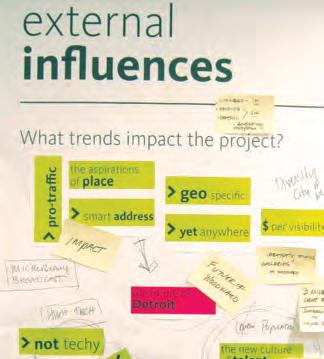


ported larger automakers is looking for younger staff and clients and would like them to be in Detroit. The agency 720 is one of those examples.” “We worked with them to identify how to arrange the spaces and then we executed the design to create the character of the space. This space supports sustainable design in the best interest of the environment as well as supporting ing health and wellness through having healthy snacks, refreshements, and creating spaces where people can walk. “An important part of our philosophy in designing places for
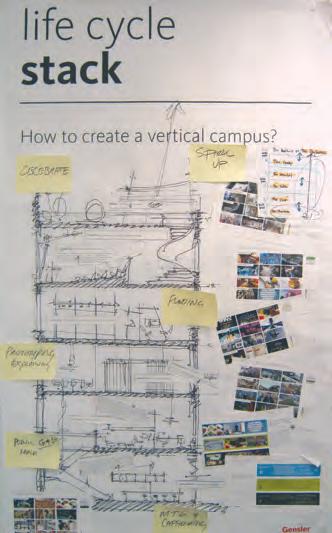
Work Style — #12.13 165
04
work is to recognize that there are different modes of how people work during the day. Some people require focus and concentration, others require collaboration, and others require the social aspect. So the spaces we designed had to support many different work styles.”

DETROIT LIONS
An example of this kind of project is the headquarter of the football team Detroit Lions. “It is a building that support the collaboration and training of a very young workforce all in the same environment, where managers and executives who run the team coexist, creating a family feel. That building has been designed to support all of these things simultaneously,” states Hartman.
SPACE RELOCATION
In recent years there has been a relocation of spaces, from a private spaces to more collaborating and teaming ones.
“What we notice in post-recession is that today’s workforce is the most diverse. Age and ethnicities differ greatly, whereas the
space available continues to decrease. There is less space devoted to a person in the workplace and more space is dedicated to collaboration and learning,” adds Hartman.
BODMAN PROJECT
A lawyer firm decided to move into a warehouse that was renewed in conjunction with the creation of the football stadium. “It was a space designed for industries. The new destination was intended for the professional practice of law. The challenge in a project like that was to find a vocabulary that reflected the heritage of the existing building,” says Hartman.
DECONSTRUCTION
Thanks to the rapid decline in population since its heyday in the mid 20th Century, the City of Detroit is home to some 78,000 vacant structures.

“Deconstruction can work. There is a sense of sustainability in using what is already built in the best way possible. A lot of buildings in Detroit have been deconstructed and renewed. It’s a peculiar-
ity of the city that can’t be found in many other cities in the United States,” states Urbanek.
The process of deconstruction aims to dismantle a building piece by piece, leaving the building’s individual components in the best possible condition for reclamation. Though the process takes more time and requires more people, Reclaim Detroit, a non-profit organization, is able to keep a competitive cost of deconstruction by selling the salvaged materials. Another benefit to the person paying for the deconstruction is that the value of the salvaged materials is tax-deductible as it is classed as a donation.
CITY ASSETS
Every city has its challenges and Detroit most certainly has urgent and long-standing ones. But not every city has the assets of Detroit. As Michigan’s largest urban center, Detroit is home to the largest concentration of workers, health, education, cultural, and entertainment institutions; the busiest international border crossing in North America for interna-
166 Work Style — #12.13
05 06
05 Dan Kinkead, Executive Director, Detroit Future City, 06 Hamilton Anderson Associates is home to Detroit Future City's Dan Kinkead
tional trade; host to 50 million annual tourists and visitors; a city of beautiful historic neighborhoods and commercial areas, including 245 sites or districts on the National Register of Historic Places and 8 National Historic Landmarks; and the second largest theater district in the country, second only to New York City. These assets make up the city’s physical and economic capital.
LONGTERM SUSTAINABILITY
Detroit Future city is a 350-page strategic framework aiming at promoting long term sustainability with information about new employment districts, the most promising residential neighborhoods, more efficient transportation modes, and innovative ideas to make use of acres of vacant land. “The report was developed through a 3 year process. There was a clear recognition at that time that the city was suffering financially and was unable to suggest valuable propositions to Detroit-based businesses and those who wanted to be there. The government needed to focus on several immediate challenges, so we elaborated long-term strategies to transform the city. In Januaury 2013, a team was formed to develop these strategies,” states Dan Kinkead, Executive Director, Detroit Future City. "Today the city is struggling in many ways, but there is also a new form of economy. In the last two years there were 12,000 new jobs downtown; the vacancy rates for offices spaces dropped dramatically; and the occupancy rate for residential living in the downtown area rose to 97 %. We need to be able to answer the question: “Why would someone want to be here” very clearly and very powerfully. In order to do this we need to address two issues. First, we have to focus on city revenue, and second on costs and the bankruptcy is part of that,” says Kinkead.
EVOLUTION AND RENOVATION
Detroit has, for more that 100 years, been known for making things. The industry supporting the automobile sector has become more technical. Today, it focuses more on the application of digital processes and components. The types of people who work in these in-

dustries have also changed. There is a much larger request for information technology profiles and brand and marketing profiles, so there is a renovation that is happening in downtown Detroit. “In my opinion the future of Detroit seems to be a contrast between the resurgence of downtown and the dereliction of neighborhoods. The attention of architects and urban designers needs to be applied in defining a strategy that enables the city's neighborhoods to improve their quality of life,” concludes Hartman.
MASS TRANSPORTATION
The things that Detroit is changing right now are: 1) mass transportation system through the M-1 Rail project; 2) downtown housing. The M-1 Rail project is a 3.3 mile circulating streetcar service on Woodward Avenue. It will better connect the 27,000 residents to their 140,000 job places and could bring between $500 million and $1 billion in economic development. It is a powerful project for a city in need of those kinds of numbers.
“
Those two things will change the dynamic of the city,” adds Urbanek.

A LEGACY
Several projects are already underway. They involve various collaborations between local organizations.
“We are working with the Environmental Protection Agency for new green infrastructure systems on the east side, and we are also working with high schools on a new program to teach students about Detroit Future City. Moreover we are also collaborating with other institutes on a bike parking program,” concludes Kinkead. There are still several steps to take before seeing the city rise again, and it will still take a long time. Today's projects are a gift, a legacy strongly supported by the community of Detroit, for the young people of tomorrow.
•
07 Architect at work 08 Designing building as a job 09 Paul Urbanek, Design Leader, SmithGroupJJR

Work Style — #12.13 167
09 07 08
Photo story. The Modern City
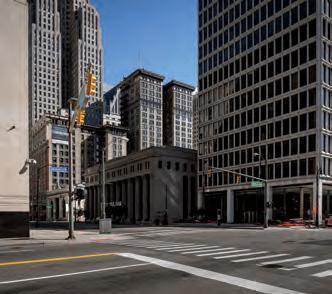






01 Worker on the Riverfront, 02 Police on the Riverfront, 03 Work zone near an intersection between Griswold and Congress

04 Men at work on Woodward Avenue, 05 Basketball game in Cadillac Square, 06 Manager on Randolph Street, 07 Colored chairs between Woodward and Clifford, 08 Houses on Woodbridge Street, 09 View of the Comerica Tower from East jefferson Avenue, 10 View of the Book Tower from the corner between Fort and Griswold, 11 Downtown Detroit between Griswold and Fort, 12 Downtown Detroit on the corner at Washington and Fort


05
The city before your eyes is lively, even if people are few. Sometimes its desolation can be overwhelming. But it has been able to become a community. This transformation has been possible because of everyone's devotion and commitment. Now the city belongs to them—to everyone.


168 Work Style — #12.13
01 02 03 04 05 06 07 08 09 10 11 12

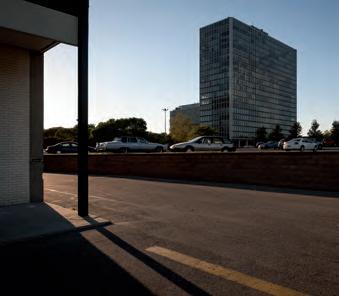










Work Style — #12.13 169
01 02 03 04 05 06 07 08 09 10 11 12
01 Houses designed by Mies van der Rohe near Nicolet Place, 02 From Nicolet Place toward Rivard Street, 03 Houses designed by Mies van der Rohe near Nicolet Place, another view, 04 View of Penobscot Building from Elisabeth Street, 05 View on the river dividing the United States and Canada from the Renaissance Center, 06 DTE Energy Building from Bagley Avenue, 07 The end of Concord Street, 08 Standing on Woodward, 09 Overpass near Macomb Street, 10 Standing on Clifford toward Elizabeth Street, 11 View of the Renaissance Center from a parking lot on Woodbridge Street 12 View of the Lafayette Tower between Orleans Street and Lafayette Street
170 Work Style — #12.13 River Rouge Deborn Seven Mile W Mc Nichols Rd W Curtis St. Jeffries Fwy JeffriesFwy Fullerton St. ChicagoBlvd WDavisonSt Broadstreet Ave Ewald Cir Dexter Ave Hamilton Warren Ave McGrawSt EdelFordFwy McGrawSt Liviernois Ave Parkland Telegraph Rd Wyoming St Wyoming St Piedmont St Piedmont St Southfield Fwy Hubbel St Chase Rd RiverAve Mc Nichols Rd W Ford Rd Mercury MichiganDrAve GreenfieldRdRotundaDr Southern Ave MillerRd SchaeferRd WyomingSt MichiganLonyoStCentralStAve DixAve ToledoSt MartinStLivernoisAve DragoonSt JunctionSt ClarkSt John Kronk St WatermanSt SpringwellsSt West EndSt LawndaleSt GreenfieldRd RauppRd OakwoodBlvd VisgerRd Dearborn Sr Economic data released by office of Emergence manager, Detroit
Work Style — #12.13 171 Midtown DavisonFwy Chrisler Service Fwy French Rd StJeanSt MackAve ALafayetteSt ALarnedSt AJeffersonAve Hamilton Ave Oakland Ave McKinleySt St E State Fair E State Fair St Duter Dr E Ryan Rd Mound Rd ConantSt Seven Mile E Mt Elliott St Sherwood St Earle Memorial Hwy Schoenherr StGratiot Ave Hayess St Van Dyke Ave Outer Dr E Chamlers St McNIcholsE FrenchRd MorangMorossRd Dr WhittierSt KellyRd OuterDrE ChandlerParkDr ConnerSt Gunston Ave Dickerson St EWarrenAve HarperAve Alter Rd Chamlmers St Cadieux Rd MorossRd KerchevalSt $18B+LongtermdebtofDetroit $380M2013city Budget deficit $ 100 M Annual city Deficits since 2008 The Greater Detroit region Thinks positive: • 1st in the share of total employment that is in the technology industry. • 1st in advanced automotive industry employment and establishment count. • 1st in the share of total jobs that are in technology occupations. • 1st in architectural and engineering employment at the industry and occupation levels. • 2nd in total STEM degree completions, trailing only the Chicago area. • 3rd in utility patents issued, trailing only Chicago and Minneapolis by a small margin. Source: Automation Alley’s 2012 Technology Industry Report
Where to Work Discovering the City
Shinola

AN EXAMPLE OF REBRANDING
Shinola was an American brand of waxbased shoe polish that was available from 1907 until 1960 and gained notoriety during World War I, when a disgruntled young soldier was said to have shined his commander’s boots with feces. The rumor led to the popular colloquialism, “You don’t know sh*t from Shinola.”
In 2011 the company purchased the Shinola name from the defunct shoe polish company.
The Shinola headquarters and manufacturing facility are located in Detroit inside the College for Creative Studies within the historic Argonaut Building, now known as the A. Alfred Taubman Center for Design Education, where General Motors invented the hydraulic automatic transmission and countless other innovations.
“We looked at a lot of cities in regard to where to put this watches factory and build the base of this brand and Detroit was a natural fit. It has a manufacturing heritage that would lend a degree of authenticity to Shinola products,” states Daniel Caudill, Creative Director at Shinola.

OPEN SPACES FOR A UNIQUE TEAM
Space at Shinola is an open environment where people have their own area and glass walls divide the watches factory from other offices, customer service, and shipping. The impression is of one unique team. “It’s really important for us not only in our stores but also office spaces to feel comfortable, warm, and inviting. We wanted an open atmosphere so that we are one team that shares the spirit of togetherness,” adds Caudill.
FAST GROWING
In a recent interview with Forbes, the company confirmed that it expects to produce 45,000 watches this year, and up to 500,000 annually by 2014 2015, with an average price of $600 per item.
“We have an amazing partnership in our watches factory with Swiss company Ronda. They take part in training our employees,” says Caudill.
Besides watches, Shinola also sells $2,000 custom-built bicycles and leather goods, all with an American pedigree. “We do everything we can to make our components here in the US,” states Caudill.

It’s also producing limited edition watches under licensing agreements with other brands, such as Ford Motor, which plans to sell a Shinola-built
SMALL COMPANIES GROWING

The location provides Shinola with the unique opportunity to collaborate with College for Creative Studies students in Shinola-sponsored workshops, including design courses on watches, bicycles, and leather goods.
“We are really excited to be part of this new group of small companies which are manufacturing in Detroit, and thanks to the collaboration with CCS we have the opportunity to train future people, future talents who come out of the city,” concludes Caudill •

172 Work Style — #12.13
A luxury brand that manufactures watches, bikes and leather goods.
watch to commemorate next year’s Ford Mustang's 50th anniversary.
[W collegeforcreativestudies.edu shinola.com]
The
02
01 02 03 04 05
01
Shinola Building inside the Argonaut Building
- 05 Bicycles and wheels at the Shinola shop

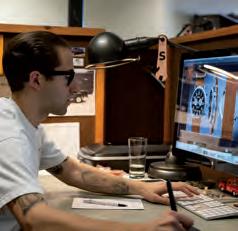


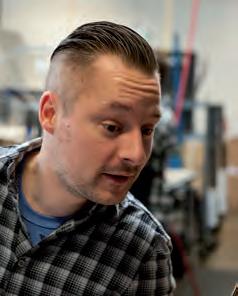
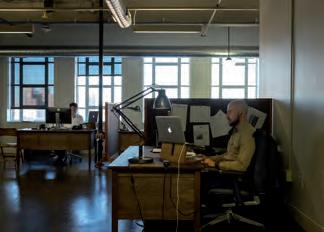
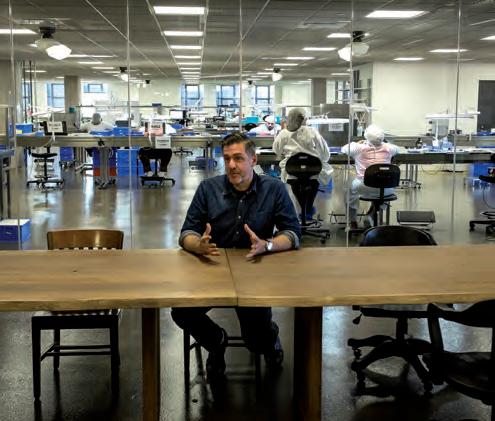




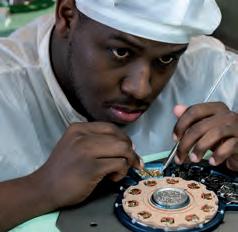



Work Style — #12.13 173 06 07 08 09 12 13 17 19 20 10 11 14 15 18 16
Photo story. The City of the Factories










Big or small factories, small activities or gigantic production buildings, everyone follows their destiny. This fate, in a city like Detroit that has voted par excellence to be a role model for industrial cities, finds itself to be a city where new touristic tours are organized around a new form of ruins. Ruins that don’t have time to become debris; those are the remains of a way of thinking, a way of doing business pressured by a future that becomes modernity and a new way of interpreting work.


174 Work Style — #12.13
01 02 03 04 05 06 07 08 09 10 11 12
01 View of factories from the corner between Orleans Street and Woodbridge Street, 02 Around the Packard Plant on East Grand Boulevard, 03 The Fisher Plant on the corner between Piquette and St. Antoine Street, 04 Around the Packard Plant on East Grand Boulevard, 05 Around the Packard Plant on East Grand Boulevard, 06 Around the Packard Plant on East Grand Boulevard, 07 Factory’s facade on Woodbridge Street, 08 Factories on Woodbridge Street, 09 High buildings of the Renaissance Center from East Jefferson Avenue, 10 Sea engines factory from Dubois Street, 11 Factory from the corner between John Street and Manchester Street, 12 Around the Packard Plant on East Grand Boulevard




Work Style — #12.13 175 01 03 02 04
Page 173 06 Daniel
07
08
my
09 Working
is the way 10 Highest technology 11 Design
12 Attention
13 Unlimited precision 14 Open space workplace 15 Incredible precision 16 It's
17 Laughing
work
and productivity 18 Gloves
19 Fun
work 20 Technically
01 Factory on West Canfield Street, 02 Michigan Bell and Western Electric Warehouse on Oakman Boulevard, 03 Building between Bethune East and Woodward, 04 Renovation works on an old industrial building on Atwater Street near the Renaissance Center
Caudill, Creative Director, Shinola
Employee at Shinola
Pimping
ride
together
and perfection at Shinola
to details is mandatory
almost finished
at
improves the mood
to avoid dust in the cogs
at
perfect
Where to Work Discovering the City
Companies Against Bankruptcy
Automotive, beer brewing, environmental engineering, non-profit financing, food and electrics: Detroit has a wide market and bankruptcy is just an opportunity.

AAM AMERICAN AXLE & MANUFACTURING THE FUTURE OF DETROIT
Technology is what's changing the market; technology is what's changing the the products that companies provide their customers. There is a demand for more fuel-efficient products, lower mass, that are energy-efficient to help reduce CO2 emissions in the interest of environmental protection. “What you’re seeing it’s an evolution of the products that we provide for our customers. At the same time, from a global perspective, our customers from around the world will look at things that are more capable, fuel-efficient, environmentally friendly. And I think you'll have a situation in which different markets have different demands. So you'll still have Detroit as the epicenter, but you'll also have Germany as a strong automotive country. Some of the best OEMs are German, such as BMW, Mercedes, and that's where a lot of the industry will come from,” states Christopher Son, Director of Investor Relations, Corporate Communications & Marketing
ATTRACTING TALENTS.
AAM is focused on technology leadership, operational excellence, and delivering a quality product for their customers. So they are working hard to attract the best and the brightest engineers in Detroit.
“We try to get the young kids early, so we partner up with some local universities such as Michigan University and Michigan State to get engineers to come and see what manufacturing is all about. They can do that in a couple of ways: 1) They can be summer interns. During the summer, they come to our company and see what it's like to be in a man-
ufacturing and engineering environment. 2) We also have a program where you can go to school full-time and work at the same time. Those are our co-op programs. So we try to get these kids who are still in school to come and see what opportunities are part of AAM. For associates here, we do performance reviews and career development. Everyone has training plans, and we do successionprogression. We talk to them about what they want in their careers and where we see them placed in the organization. Regarding training, we do particular skillsset trainings. So for those skills that are particular to a job, we also do career enhancement. Maybe an employee wants to look at another part of the environment or a different aspect. One can also get technical training or leadership training,” states Terry Kemp, VP HR.•
01 AAM's parking lot
02 Terri Kemp, Vice President of HR and Christopher Son, Director of Investor Relations, Corporate Communications & Marketing, AAM
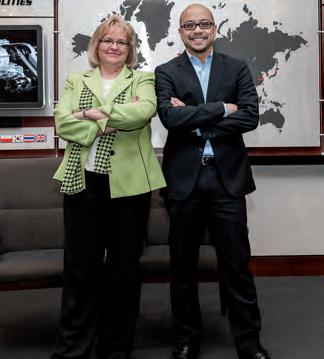
176 Work Style — #12.13
01 02
GENERAL MOTORS BEHIND THE CRISIS

The automotive industry crisis of 2008–2010 was part of a global financial downturn. The crisis affected European and Asian automobile manufacturers, but it was primarily felt in the American automobile manufacturing industry.

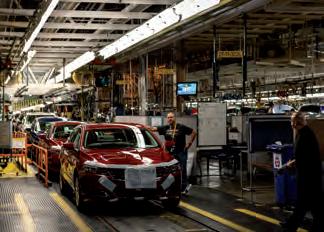



CHANGE MANAGEMENT
After this big crisis in 2008, companies have to change “Today the size of General Motors matches the market and economic conditions better than in 2008. We don't have a 60% market share anymore; now we compete with automakers from all around the globe. We have suppliers from different sides of the world and we manufacture cars in the countries where we sell our products. We are a much smaller, yet more efficient company. Our workforce is smaller and efficient. Labor unions have renewed partnerships and the situation is a lot less contentious than in the past decades,” states Gregg Martin, Executive Director Communications & New Strategies at GM.
“
INVESTMENT IN TECH CONTINUES
One of the things we did was reinvest billions of dollars in technology and in smaller and fewer but more efficient vehicles. Customers with their cars want to be safe, connected and respect the environment. Since GM went out of bankruptcy we have invested 8 billion dollars in the US economy and brought about 30,000 people back to work. So the rise of the US economy has been driven partly by the automotive industry but also by other kinds of manufacturing where jobs have been created. The US auto sector also created additional jobs for industry suppliers,” adds Martin.
A MORE VIBRANT INDUSTRY
The industry is now brighter in Detroit. The main car companies and their suppliers have a presence in and around Detroit and South Michigan. Of course there is a lot of growth in the South and the South West of the United States, but the main area for this industry remains Detroit. As Martin says, “It is home to thousands of engineers, executives and others workers. The size of Detroit now better matches the global nature of the business. We maintain our global HD in Detroit, we still have a plant here, so the industry will continue in Detroit.”
GM in the last 2 years has invested nearly $25 million in charitable giving that will help and improve the schools of Detroit, rebuild homes, preserve the arts and culture of Detroit. “Our employees have donated 2,000 hours of their own time to make this a better place to live,” says Martin. “It’s our labor, it’s our best minds, it’s our muscle to get the city back on track,” he continues.•
03 Greg Martin, Executive Director Communications & New Strategies, General Motors 04 Moving cars around 05 Car assembly
This is where the magic happens
Producing cars 08 A series of black GM cars
Ready to go

Work Style — #12.13 177
CSR
03 04 05 06 07 08 09
06
07
09
ATWATER BREWERY THE CITY OF BREWERIES
In Detroit there are now around 140 breweries and microbreweries. Beer in the United States is manufactured by more than 2,100 breweries, which range in size from industry giants to brew pubs and microbreweries. Today, the US craft beer industry employs over 100,000 individuals brewing eleven million barrels of beer per year, and generating roughly $12 billion in retail sales as of 2012. The history of breweries in the Detroit metropolitan area began a long time ago, in 1830. Between the 1830s and 1840s settlers were mostly of English, Irish or Scottish origin. The early Detroit brewers had Anglo-Saxon names and brewed primarily a variety of ales, with some porter and stout.
“
At one point in history, Detroit had more production breweries than any other city, and this is because of Detroit water, which is the most important ingredient,” says Mark Rieth, owner of Atwater brewery.




A GROWING MARKET
The number of craft brewers has grown from 8 in 1980 to 537 in 1994 to over 2,300 in 2012. The number of breweries in planning is skyrocketing. As of June 1, 2013 there are more than 1,500 breweries in development in the US.
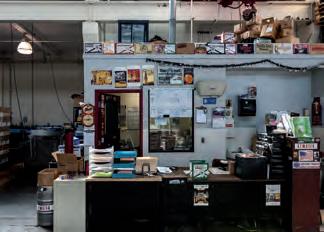
“
Since the 2008 crisis we grew and we have not been touched by the recession. The are two main reasons for this: one is our brand, which is very successful; we have been marketing our products since 1996. Also, the craft beer industry has been growing across the country. It has been the fastest growing segment of the spirits industry for the last 8 years,” says Rieth.
•
PM ENVIRONMENTAL THE BANKRUPTCY WAS EXPECTED AND IT IS AN OPPORTUNITY.
Actually in the city, “There are several abandoned industrial facilities in which there are renewal projects,” says Michael Kulka, Ceo PM Environmental. Since the bankruptcy, the line of their services has not changed, but the volume of work has increased. “We have 5 different projects to redevelop Detroit. For example we are working in collaboration with an environmental attorney for the redevelopment of 150,000 square meters of formal house property that a developer from NY wants to develop for loft retail and art studios, providing a real eclectic use,” adds Kulka. For PM Environmental, as for many other companies from Detroit, the bankruptcy was not a surprise. “What happened has been an opportunity, and in truth there is competition and demand from people trying to have available buildings. For example since July we have been working on a Detroit-based bank building that will be renovated and will have a restaurant on the first floor and lofts and offices on the second and third floors,” explains Kulka.•

178 Work Style — #12.13
10 11 12 13 — 14 10 - 12 Atwater Brewery Headquarters on Campau Avenue 13 Mark Rieth, Owner, Atwater Brewery 14 Office inside the Atwater Brewery production site 15 Michael Kulka, CEO, PM Environmental 15
CHELSEA MILLING COMPANY/ JIFFY MIX

The metropolitan area, compared to Detroit, has suffered less with unemployment. “We probably have the lowest unemployment rate in the state. This is because we have a strong economic basis: it’s traditional manufacturing hi-tech, university and retails,” explains Jack Kennedy, Vice President and General Manager.
AUTONOMOUS PRODUCTION
To remain in the market, Chelsea Milling Company has put all its strength into autonomous production.









“We store wheat. We mill wheat into flour. We print our own packaging materials. We also maintain low costs, and for this reason we do not advertise at all. We promote our product in grocery stores. But
we do not advertise to final consumers. Our market is done by word of mouth,” states Kennedy. This allows the company to maintain a very tight control of quality at affordable costs.
A FLAT ORGANIZATION
The climate among employees at Chelsea is friendly and cheerful. “We have what we call 'a metric store flat organization.' We do not believe in a lot of hierarchy. So there is not a lot of communication between the management and the rest of the employees,” adds Kennedy.
NEW STRATEGIES
After 130 years of history and presence on the market, the future for the company seems already outlined. “In 2006 ingredients of our products have become very, very expensive. We had to face the
concept of needing to consolidate our own economic bases. We decided to go into institutional food services, and that has been a very successful idea. In only a few years this has become 45% of our total business. We feel very strongly that it will be our future,” concludes Kennedy.
DETROIT IS A MUCH BETTER PLACE THAN PEOPLE THINK
The company feels very strongly about their social responsibility. They are very tuned into the needs of the city. They spend a lot of time at community events. “We do a lot of charitable work as a company, especially around the community. We participate in the environmental clean -up of sensitive properties around the city, and we are very active in recycling as well as supporting the Chelsea community hospital,” adds Kennedy.
Work Style — #12.13 179
16
17 Smile you're at work! 18 "We're at work and we have fun!" 19
20 Production site 21 Jiffy products 22 Worker
the
23
24
16 17 18 19 20 21 22 23 24 25
•
Production machines
Jack Kennedy, Vice President & General Manager, Jiffy
supervising
machine
Logistics are important
Jiffy's facilities 25 Team work at Jiffy
DETROIT,
TOGGLED
AN HUB OF TECHNOLOGY
The industry and employment data of the Automation Alley, Technology Industry Report claim that the Detroit region is an established hub of technology firms and workers. Innovation measures, such as patent awards and STEM degree completions, suggest that Detroit’s technology sector remains on the upswing.
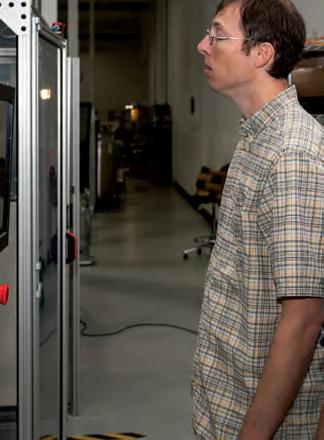
It’s a long drive to the Silicon Valley, but there is little doubt that Detroit’s tech sector has shifted into high gear.
“If you are wondering where to start a manufacturing business, you should do so in a place where people have skills in technology. For mechanical assembly and electronic assembly, you want people with skills in supply chain management, material management, inventory control, shipping, receiving logistics, quality system, management, development. Everything needed to make manufacturing successful is right here in Detroit,” says David Simon, President.

TECHNOLOGY TO FACE THE CRISIS Companies apply different strategies to remain in the market and overcome periods of crisis. “Our strategy to stay in the market has been to make substantial investments in automation equipment, which, in addition to giving great benefits in terms of quality and consistency of product, also creates a very competitive global base in terms of price, because the direct costs are very low,” states Simon. “The company is really focused on the US market for 2 reasons: one being that research, support and our property are based in the US, and two, that this is where our customers are and there are tremendous advantages
to be able to ship our products from the factory into the local market. In this way our products are built and quickly sold to the commercial and industrial properties,” adds Simon.
THE POSITIVE EFFECT OF BANKRUPTCY
The effects of the bankruptcy have even been positive for the technology segment and for the city in general. It seems that there is a tremendous sense of entrepreneurialism in people looking toward the future. “Once that bottom was hit, things went better and we saw the local economy improve in all areas,” adds Simon. •
BILL HIGHWAY THE BEST PLACE TO START A TECH COMPANY
The company settled in Detroit 14 years ago in 1999. “When we settled here,there weren’t many technology companies. Today there are hundreds of them. This is a great place even in this period in time. It may be the best place in the US, because there is so much awareness and investment in helping companies get up and running. The state of Michigan knows that the city will come back at its best,” states Vince Thomas Chairman & Founder of Bill Highway.
A WAY TO SUPPORT THE COMMUNITY
The company has 14,000 customers, and it brings in the business (banking 26 David Simon, President, Toggled 27 Employee of Toggled standing
180 Work Style — #12.13
27
26
28 Vince Thomas, Chairman & Founder, Bill Highway


29 - 32 Employees at Bill Highway



33 Michelle Lange, Chief Marketing Officer, Bill Highway
transitions, economic transitions from all over the country and Canada, through the city of Detroit. “Our customers are the typical large non-profit organizations with $10 million revenue or more a year. In the last year we dedicated ourselves to attracting more customers in Michigan and in the city of Detroit to help this area come back to its booming years and to help companies work more efficiently and then grow. It is the best way to help, to help them to hire more people and have an economic impact individually as a company,” adds Thomas.
TEAM MEMBER SUCCESS
Bill Highway provides a range of important initiatives and programs on worklife balance and space for children to its employees. “We don’t call our team HR, but we call it “team member success.” Our culture is focused on finding things that are applicable to individuals, for example unique talent,” states Brenda Gallick, HR Director.

A NEW TREND AMONG GRADUATES
There is a new trend in the city. “In the past young people, after graduation, were looking for really vibrant environments like New York, Chicago, and places like Dallas. Now what we see is that the graduates remain in Detroit. They get jobs in the city. Even people from other states come and get jobs here,” says Thomas. “Detroit has many things to be changed and built. Other cities, like New York, are fantastic but you cannot change anything there. Here, there is a lot to be created and this makes Detroit a wonderful place for young people to be,” continues Thomas.
CORPORATE SOCIAL RESPONSABILITY
“In terms of the community we get involved in a lot of projects. One example is the challenge Detroit Program where we provide volunteers paid time off,” states Gallick.
Challenge Detroit is an urban revitalization project bringing together individuals of various intellects and backgrounds to live, work, play, give and lead in Detroit by uniting area companies, non-profits and cultural institutions.
•
Work Style — #12.13 181
31 32 33 30 29 29
Photo story. The City at Night





The night forgives everything. The night forgives the city for not being clean, crowded and modern. Desolation gains dignity and allows you to see spaces and buildings as if they were detached from the constant clicking of the clock. The night makes you complicit. It allows you to squeeze into narrow angles or pick those that during the day would be considered improbable points of view.If your point of view takes you to the middle of the road, it's at night when you can be there.

182 Work Style — #12.13
01 02 03 04 05 06
01 Bus station on Grand River Avenue, 02 Work Zone between John R. and Broadway, 03 Opportunity Detroit, 04 Overpass on Broadway, 05 Night lights on State Street, 06 Hartz Building on Broadway, 07 Alley on John R. behind the Wurlitzer Building

Work Style — #12.13 183 07
Photo story. The City of Angles



The perspecitve of angles is, in my opinion, a privileged point of view. A closed way to look at things, in the search for a decodification of the information of the place where I’m at in that moment. Dust – the set of information present in an environment - settles in the corners and if you’re truly able to watch, maybe one can understand many things. This point of view is a way for me to return to an American imagination that I feel closer to, rather than the pompous view of "watching nose up.”

184 Work Style — #12.13
01 02 03 04
01 Fire department headquarters in Highland Park 02 Michigan Central Station from Dalzelle Street 03 Industrial building from between Woodbridge Street and Mac Dougall Street 04 The Renaissance Center near Franklin Street 05 Corner of Toggled’s LED lights factory at 164 Indusco Court, Troy 06 Corner between Piquette and St Antoine 07 Corner between Griswold and West Larned Street 08 Corner on Concord Street 09 Corner between Gouin and Chene, 10 Corner 6299.






Work Style — #12.13 185 05 06 07 08 09 10
What’s behind a building? Behind its elegant facade? I ask often ask the question myself when in a city. I try to look beyond the pretty and good surface that wants to be shown. Looking behind things is like having an escape route. It is searching for the complicity of shadows. It is spying on what happens backstage. It is both intriguing and charming.

186 Work Style — #12.13
01
Photo story. The City of Alleys
01 Alley on Griswold, 02 Alley on John R. Avenue, 03 Alley on West Congress Street, 04 Alley between houses near Michigan Central Station



Work Style — #12.13 187 01 02 03
Photo story. The City from Above
Viewing a city from above is always an emotion. Such a sudden change in perspective always represents a revelation. It can always be considered a new discovery. It is always like reorganizing a geography that seen from below is made of other colors and orderd. This is even more noticeable in an American city with the view of its downtown area.

188 Work Style — #12.13

Work Style — #12.13 189 01 Guardian Building and the One Woodward Avenue Tower 01
Where to Work Workplace Kindness
A New Planet Where to Work
WHO
Gentletude is a nonprofit organization developing projects to promote kindness. Cristina Milani, the founder, affirms “kindness is normal, it is a much easier attitude to have than disrespect," in fact "one to be kind only needs to behave well.”
WHAT
This not-for-profit organization proposes its projects to schools and businesses. These concrete programs allow the organization to introduce the topic of kindness in those environments where, for a number of reasons, being kind can make a difference. At school, more kindness reduces bullying, kids study more efficiently and general conditions improve. In companies, the beneficial effects can be seen on productivity - employees work better in a kind environment - and on sales. A positive perception of a company increases business. The organization's projects are programs of communication and training.
FROM THEORY TO PRACTICE
November 13 is the International Kindness Day. The World Kindness Movement, as explained by Michael Lloyd White, Secretary General, “is committed to transform the topic from theory to a practical and daily activity.” Many things can be said on kindness, but "we want facts to do the talking, because kindness is normal for humans, and even the shittiest (this is the right term) colleague, if put in a polite scenario, will be better." The pictures published here are an example of activity done by Gentletude during the world Kindness day.

Market sellers, Viale Papiniano, Milan (Italy).13.11.2012.




A THOUSAND ACTS OF KINDNESS
Kindness is both a generic and specific subject. Generic because everyone has their own theory on kindness, and specific because every culture has a minimum set of behaviors that are considered as gentle. Kindness, however, must not be confused with nicety. Kindness organizations are not only after basic kind gestures, such as the classic help to an elder woman crossing the road. Kindness is an ethical commitment that must be spread in all kinds of relational and active gestures of a person that works and interacts with society.
GENTLEBOOKLETS
A number of kind thoughts are collected in a series of booklets where authors, with different backgrounds, have their
say on kindness. From 2014, the World Kindness Movement will gather a string of short articles on the meaning of kindness and its promotion all around the world. The articles will run in a publication: A Kind World. For more information on the project contact Gentletude ONLUS.
FACTS
The subject of kindness must be put at the center of the attention, and for this reason the World Kindness Movement develops concrete projects. Between those, Gentletude has promoted a series of creativity contests. In 2012 it was the turn of graphic designers, in 2013 of photographers and in 2014 of cartoonists. The idea is to ask these creative professionals to develop projects targeted at kindness.•
190 Work Style — #12.13
Is it a magic place, where everyone is polite and rules are followed?
Is it a place out of this World?
[W
—
]
gentletude.com gentle-projects.com
gentle-onlus@gentletude.com

This major event will explore some of the most significant local and global questions we face today in the context of the answer: community. How will we address the challenges of poverty? Of growing inequality? Of the environmental crisis? Of the failure of our institutions?
Community is the answer will showcase community-based solutions from Scotland and around the world. It will allow community members, activists, practitioners, researchers and policymakers to come together and examine what actually matters to people, how to measure it and how to place it at the core of what we do.
Over three days, parallel tracks will allow participants to choose from a range of academic presentations, seminars, practice-based learning events and field visits. There will be a full social programme and the opportunity for overseas delegates to take part in extension programmes supported by Scottish community learning and development practitioners.


Celebrating our common wealth: an international gathering 9-11 June 2014, Glasgow, Scotland, UK visit: www.communityistheanswer.org
Jane Addams
Taking place in the beautiful, historic campus of the University of Glasgow in the run-up to the Commonwealth Games, Community is the answer is expected to attract several hundred Scottish and international participants. The gathering is a collaboration organised by the International Association for Community Development (IACD), the University of Glasgow and the Standards Council for Community Learning and Development for Scotland.

192 Work Style — #12.13
“The good we secure for ourselves is precarious and uncertain until it is secured for all of us and incorporated into our common life.”
C D STANDARDS CO UNCI L FOR SCOT LA ND



















 by Goñi Montes, Decatur, USA
by Goñi Montes, Decatur, USA

 By ANNE BUCHANAN
By ANNE BUCHANAN





 By CHRISTINE DEAKERS
By CHRISTINE DEAKERS






































 By
By





















 By LUCA BRUNONI
By LUCA BRUNONI













 By MARTHA TINTIN
By MARTHA TINTIN































































 R. Stoker
R. Stoker


















































































































































































 Clothes exhibited on June 24, 2013 at the Dakar French Institute.
Clothes exhibited on June 24, 2013 at the Dakar French Institute.


















































































































































































































 By ALESSANDRO ALBRIZIO
By ALESSANDRO ALBRIZIO

































































































































































